Uganda, 2021
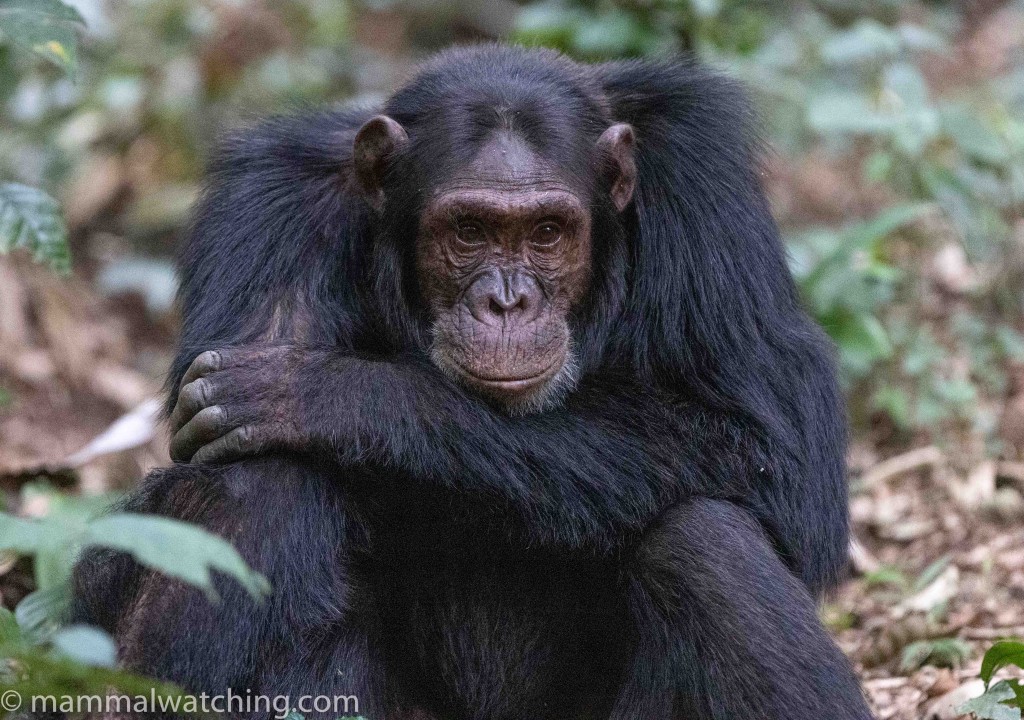
Chimpanzee, Pan troglodytes. Kibale National Park
For many years Uganda had been fairly high on my list of places to visit, but never quite high enough for me to start thinking seriously about a trip. I’d heard only good things about the Pearl of Africa, but didn’t think I would see many new mammals there. My thinking changed in early 2021 when Tomer Ben-Yehuda and Alex Myor returned from two Ugandan weeks with a large haul of mammal sightings, many of which would be new for me. This was fertile ground for my mammal list!
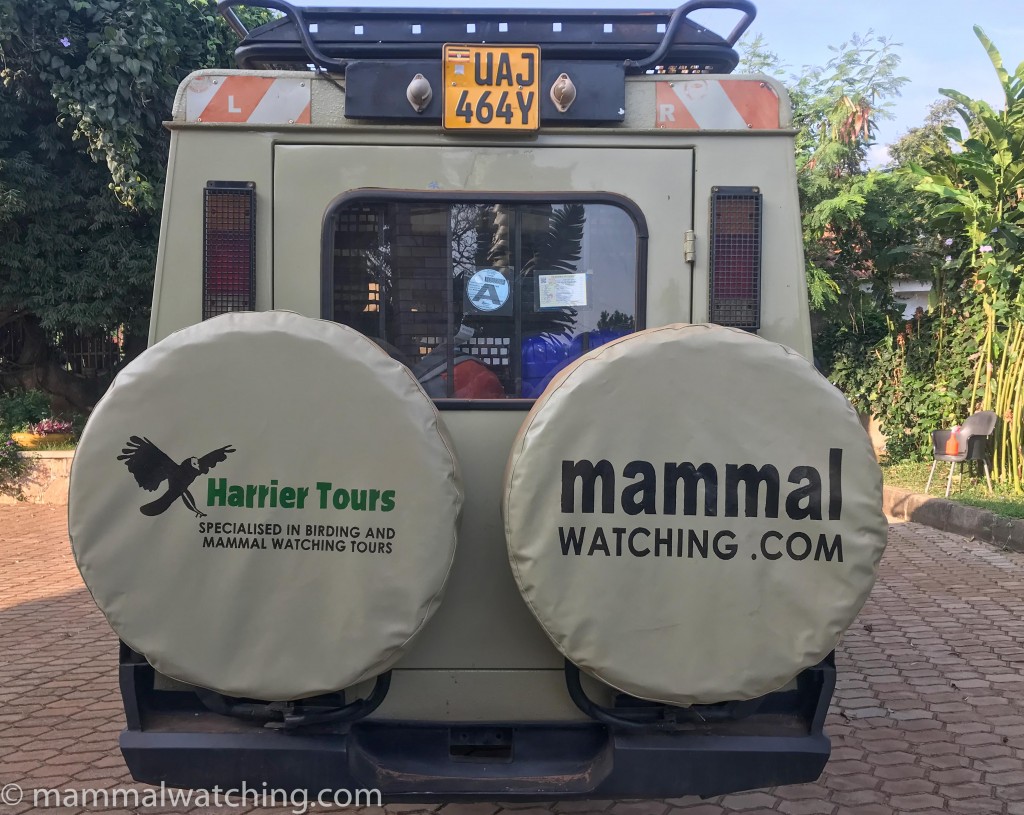
VIP mammalwatching
Tomer and Alex’s success seemed in part due to the quality of their guide and safari operator, Harriet Kemigisha from Harrier Tours. Harriet had already demonstrated great wisdom when she decided to devote more of her time to mammalwatching some years back, even advertising on this site.
Uganda had moved to the top of my list and I took my family there in July 2021 for some ‘relaxed’ mammalwatching. Relaxed, of course, is a subjective term.
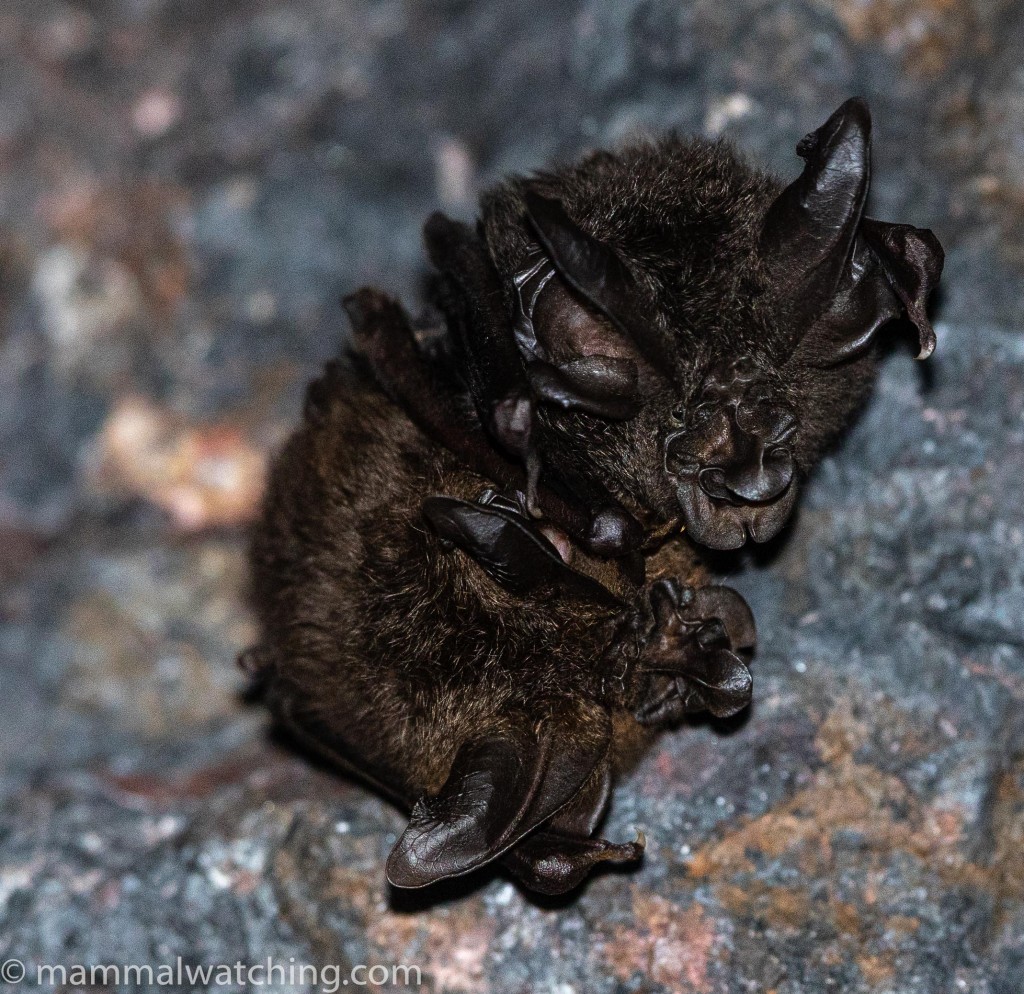
Ruwenzori Horseshoe Bat, Rhinolophus ruwenzorii. Bwindi Impenetrable Forest
This was the other half of my East African trip during which I also visited Kenya. While I spent many many hours organizing the Kenya portion myself, I asked Harriet to organize the Ugandan leg. Every single last bit of it. This, I realized as I was sending yet another bank transfer to Kenya, was a huge bonus. She also did a far better job than I could have, patiently adjusting our itinerary as dates and mammals of interest shifted.
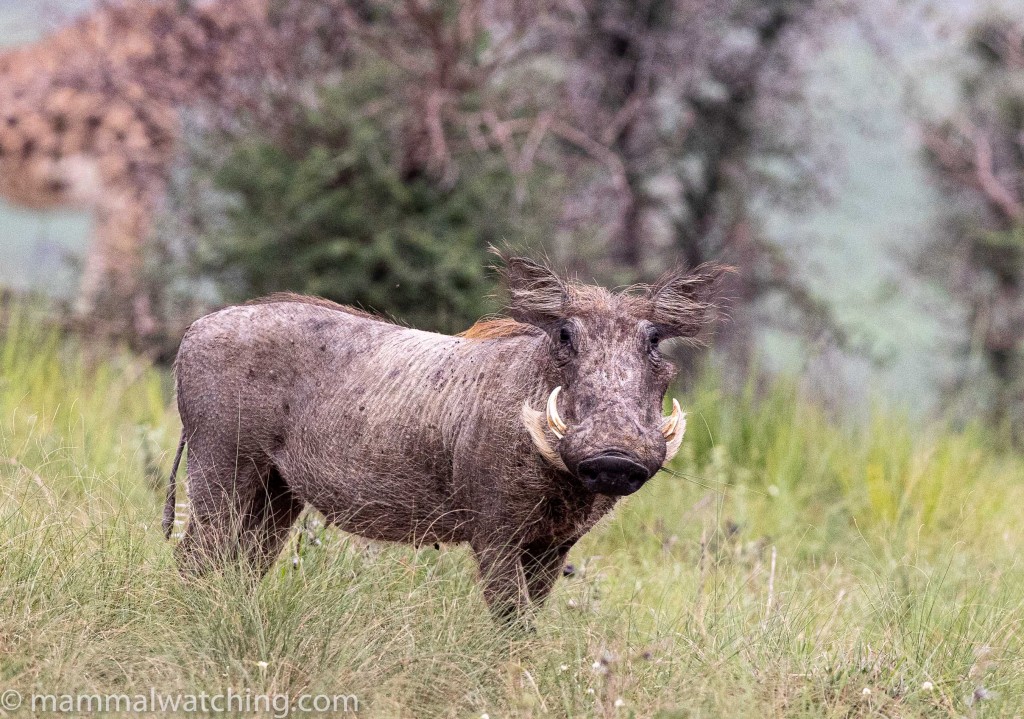
Common Warthog, Phacochoerus africanus. Murchison Falls National Park.
A month before we left the USA, Carlos Bocos was in Uganda, also with Harrier Tours. His mouth-watering – 95 species – trip report set the bar even higher.
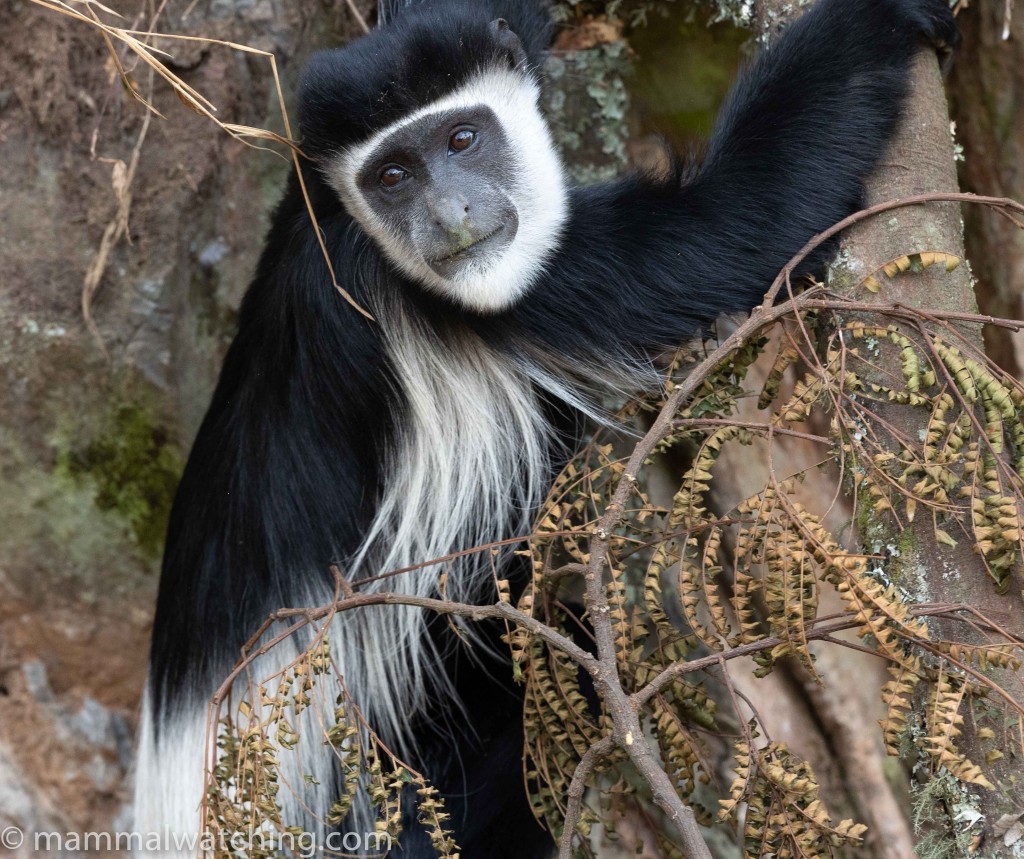
Guereza Colobus, Colobus guereza. Bwindi Impenetrable Forest.
Tomer and Alex gave plenty of information on the sites in their reports so I won’t duplicate that too much here with details about accommodation and so on. I will focus on the mammals.
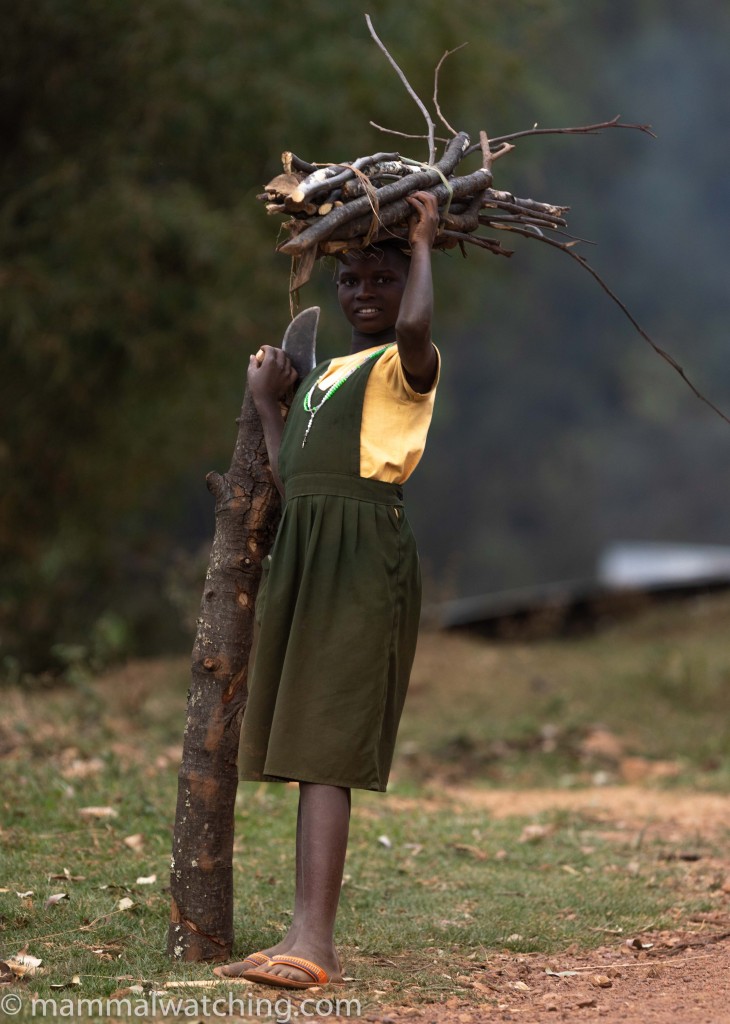
When And Where To Go
We followed a shortened version of Tomer’s itinerary, skipping Semliki Wildlife Reserve, Queen Elizabeth National Park and Buhoma (in Bwindi) and adding a night at Lake Mburo to break the long drive back from Bwindi to Entebbe. The itinerary was pretty easy to decide based on my time budget and mammal wish list.
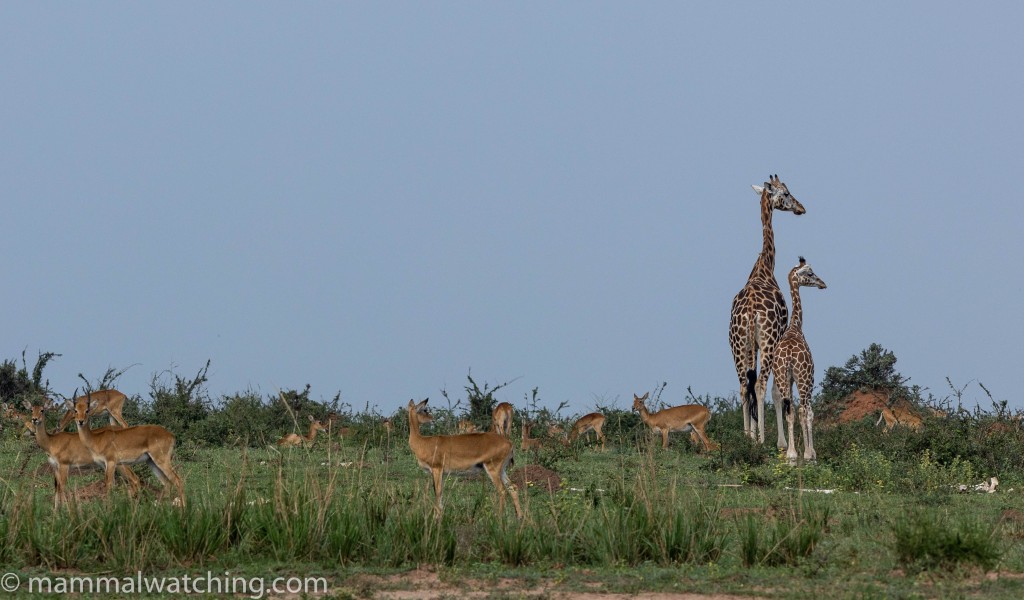
Giraffe and Uganda Kob. Murchison Falls National Park
We did spend time debating whether or not to visit Semliki Wildlife Reserve (which is a different place to Semuliki National Park). Ten years or so ago a mammalwatcher had photographed Pousargue’s Mongoose here, an almost unknown species. Back then the mongooses were rumoured to be frequent visitors to the kitchen. But Tomer and Alex missed them here in January. And Harriet, after further discussion with the people in the reserve, felt they were at best a long shot these days. But more on this later.
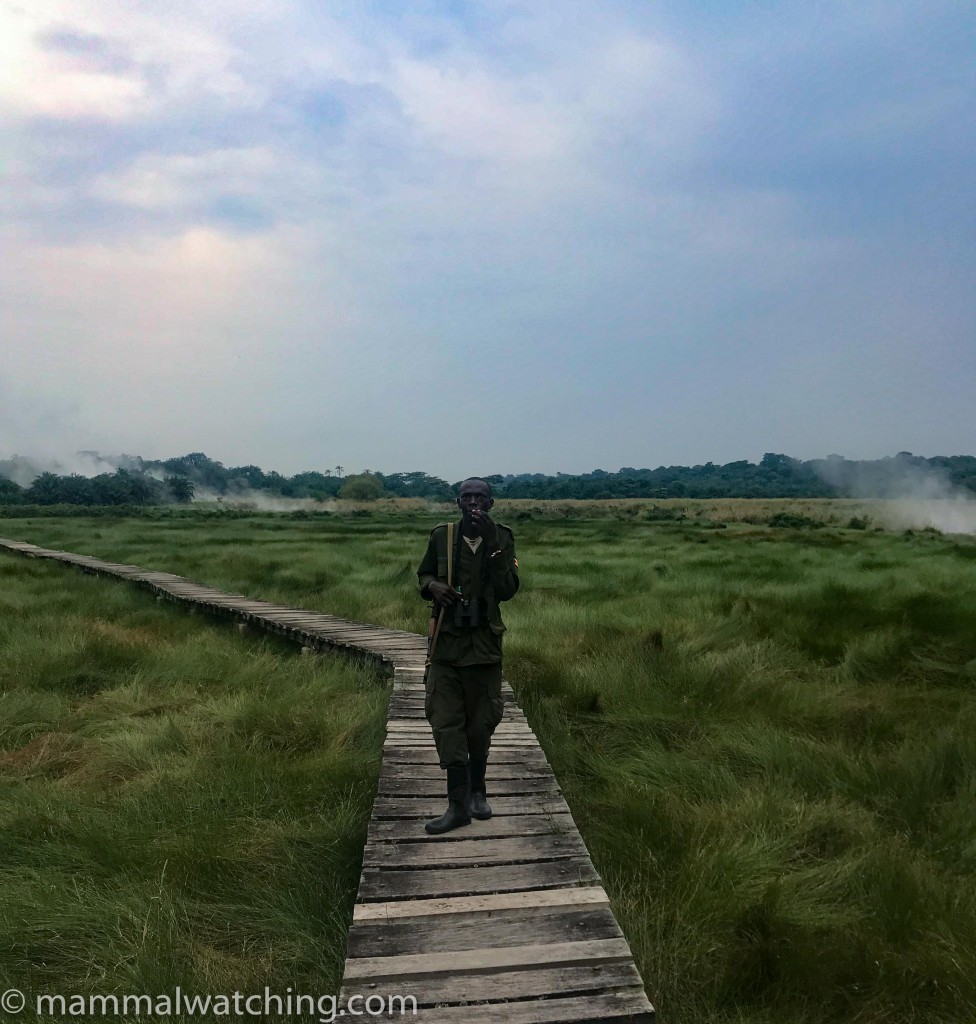
The Hot Springs, Semuliki National Park
July seems one of the best months to visit Uganda. I don’t remember any rain, and temperatures were pleasant, even in Semuliki Rainforest on the border with the DRC. The absence of rain and mist also made Bwindi Impenetrable Forest an easier place to see mammals than it can be, though the dry weather may also be the reason we did not see duikers feeding along the roadside.
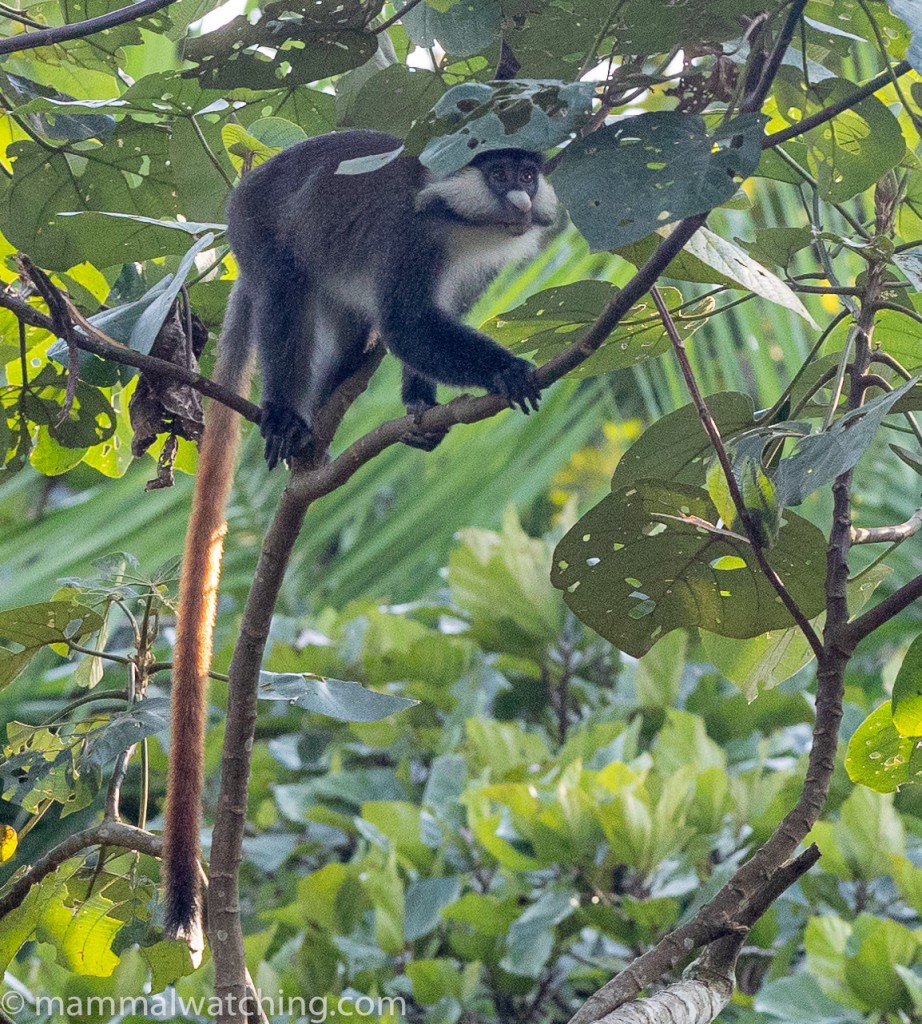
Red-tailed Monkey, Cercopithecus ascanius. Bigodi Swamp (Kibale).
I didn’t have a field guide for Uganda’s mammals. I don’t think there is one. I used Kingdom’s field guide and Chris and Mathilde Stuarts’ excellent app for African Mammals.
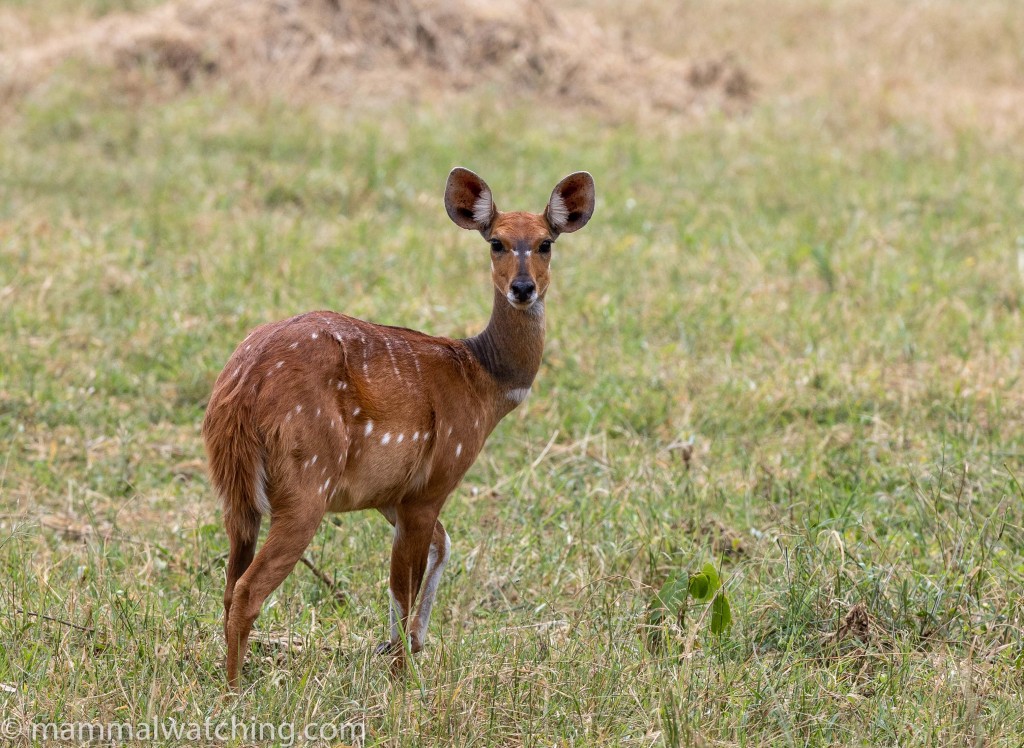
Cape Bushbuck, Tragelaphus sylvaticus. Ziwa Rhino Sanctuary.
Harriet guided us for the whole trip and also brought along her son Kevin who was great company and a very good spotter. Joel, our driver, was a total star.
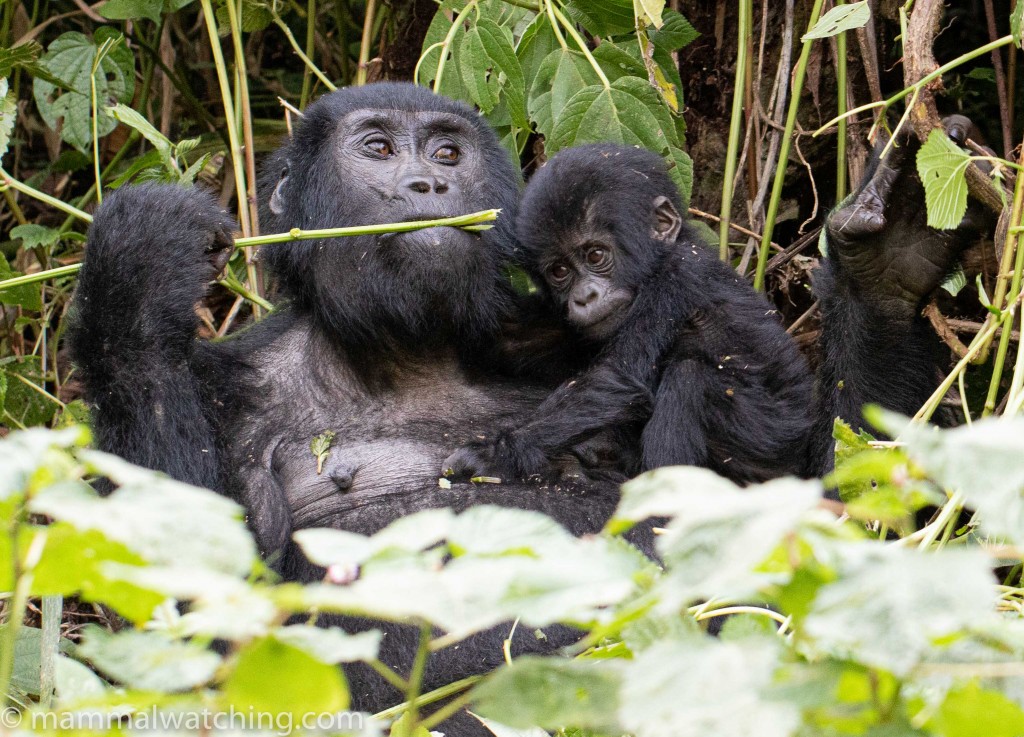
Eastern Gorilla, Gorilla beringei. Bwindi Impenetrable Forest.
Mbamba Swamp
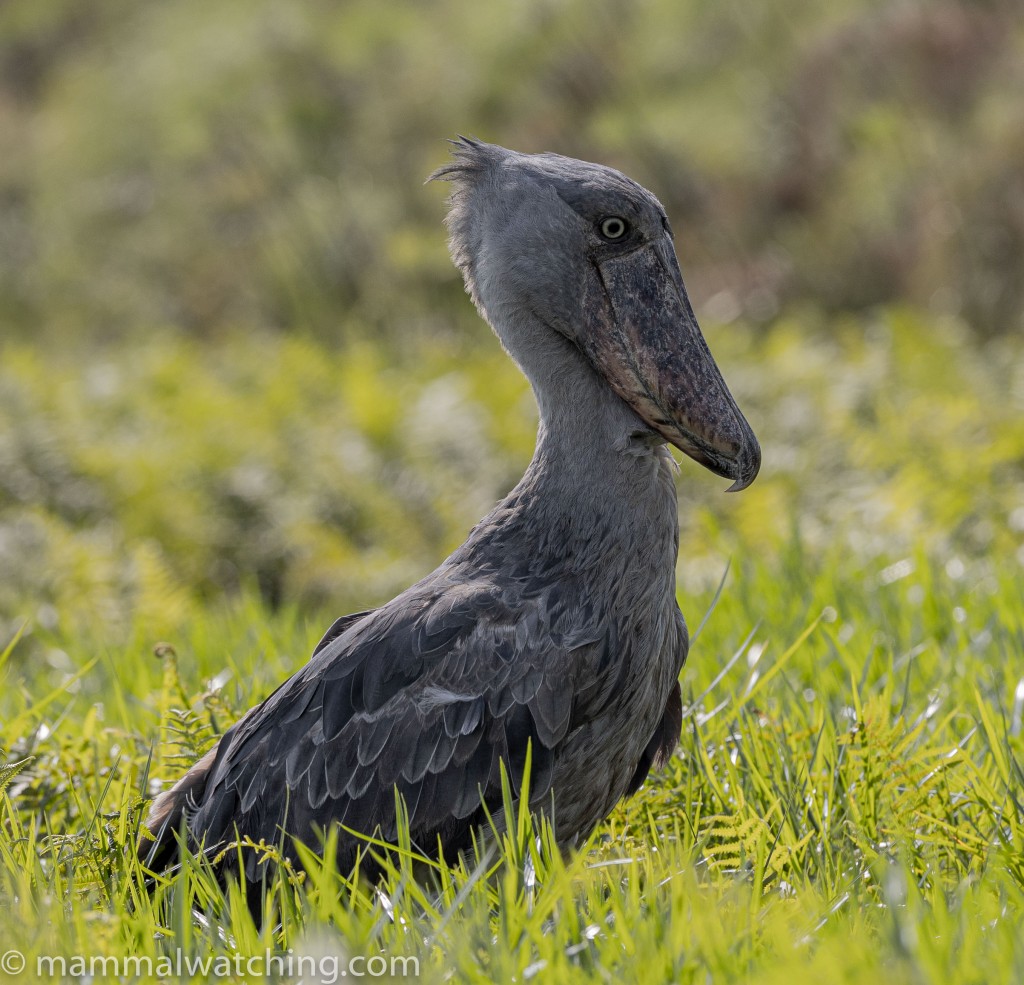
Aquatic Dodo aka Shoebill Stork
Our first stop was Mbamba Swamp, a couple of hours’ drive from Entebbe. I was indulging my son who wanted to see a Shoebill Stork. They are quite cool. For a bird.
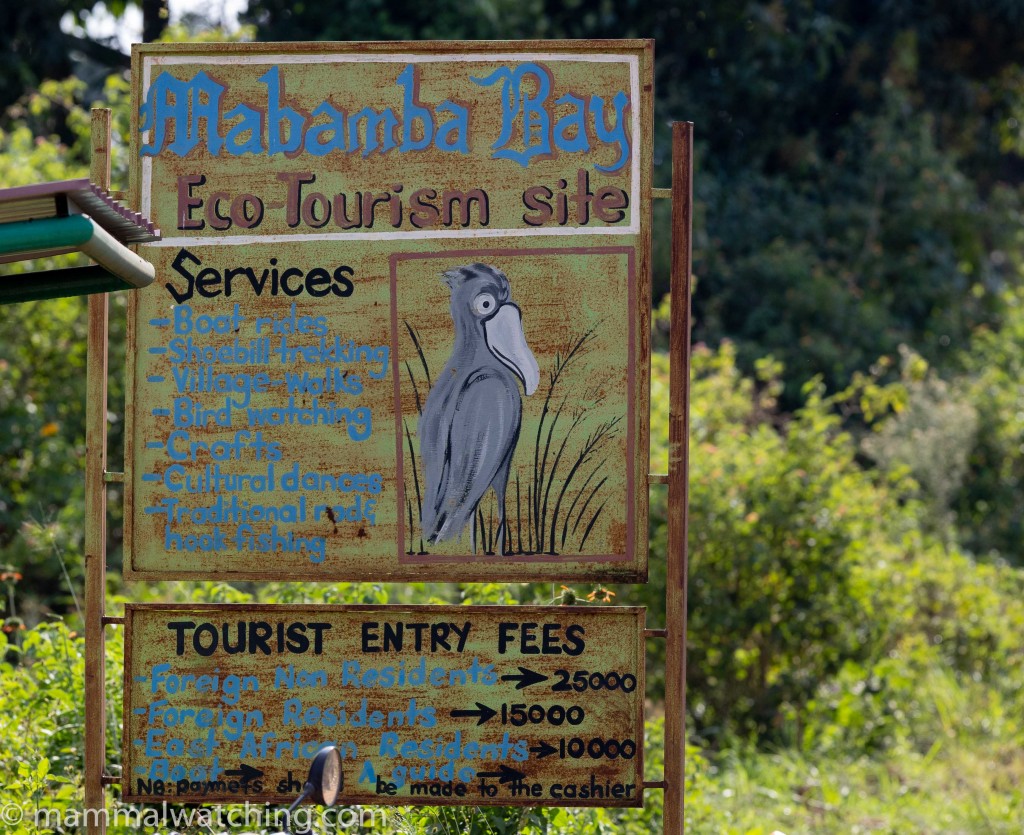
I had seen Shoebills at Bangweulu in Zambia 30 years ago, but here they are easier to see, and easier to see well. It took 30 minutes to find one and on the canoe ride back we got brief glimpses of Spot-necked Otters in the water in front of us.
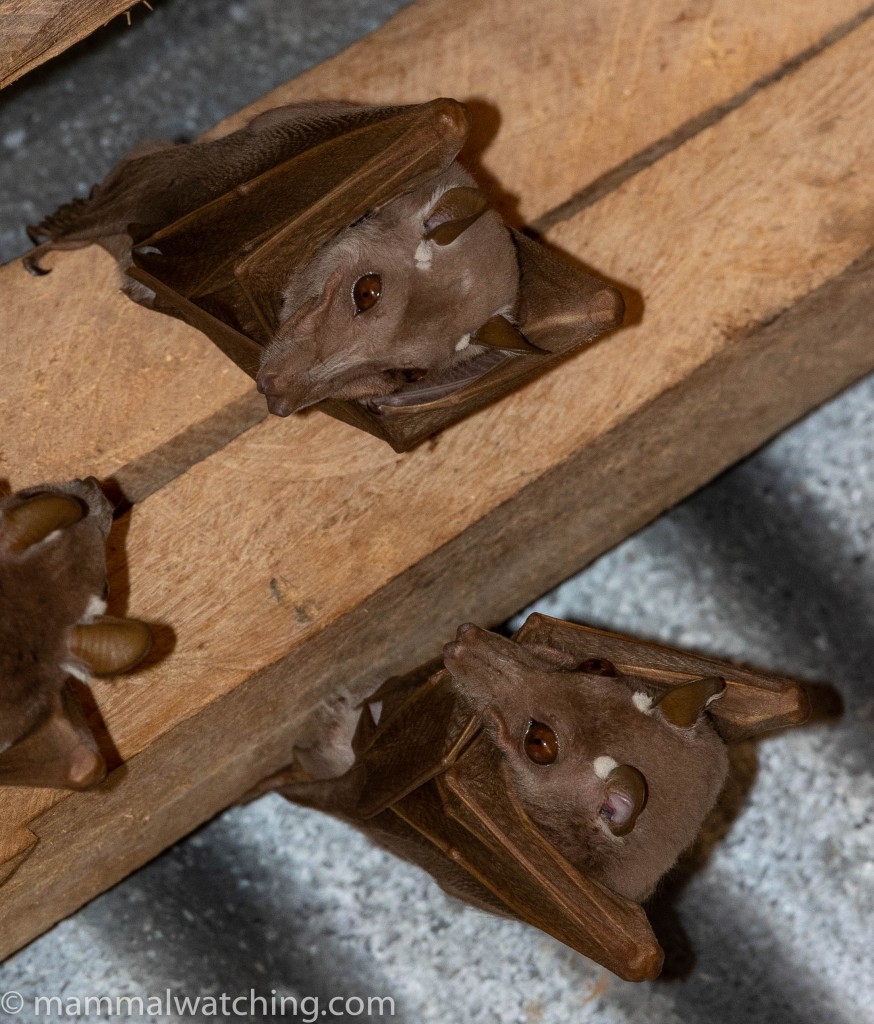
Probably Wahlberg’s Epauletted Fruit Bat, Epomophorus wahlbergi
A roost of epauletted fruit bats in a building next to the dock were likely Wahlberg’s Epauletted Fruit Bats, though Epomorphous labiatus are also in the area and virtually impossible to separate without looking at the roof of their mouth.
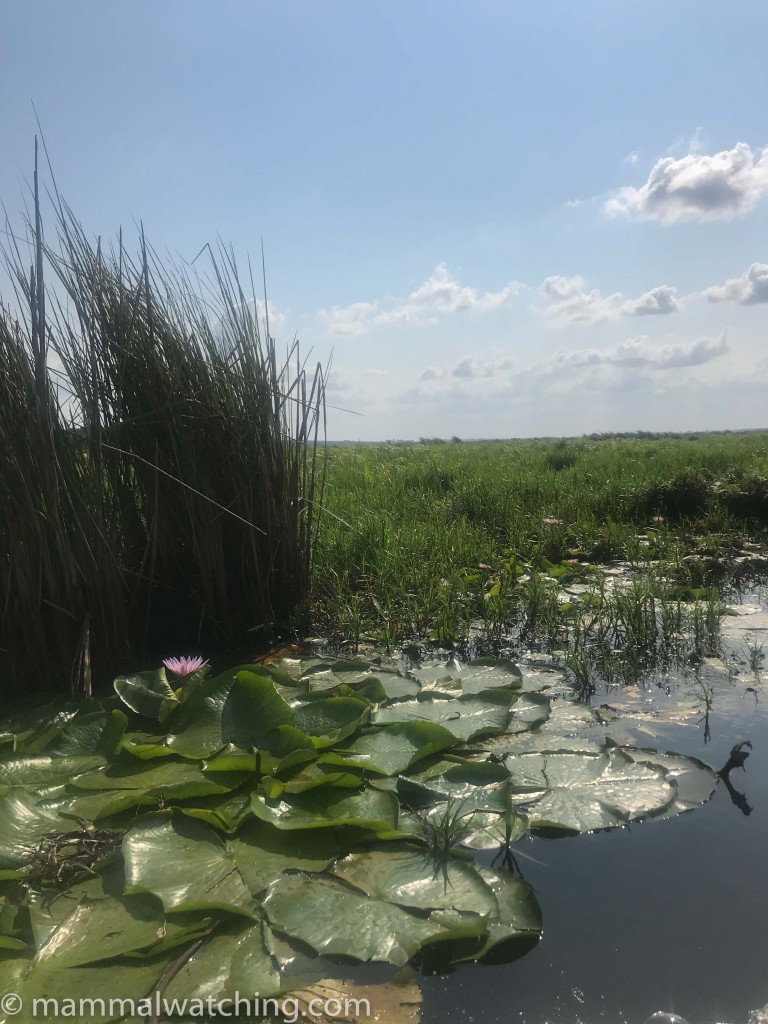
My daughter encountered a large rat when she used the toilet before we got on the canoe. She didn’t think to mention this to me until we had returned. The rat had gone. My resentment remains.
Ziwa Rhino Sanctuary
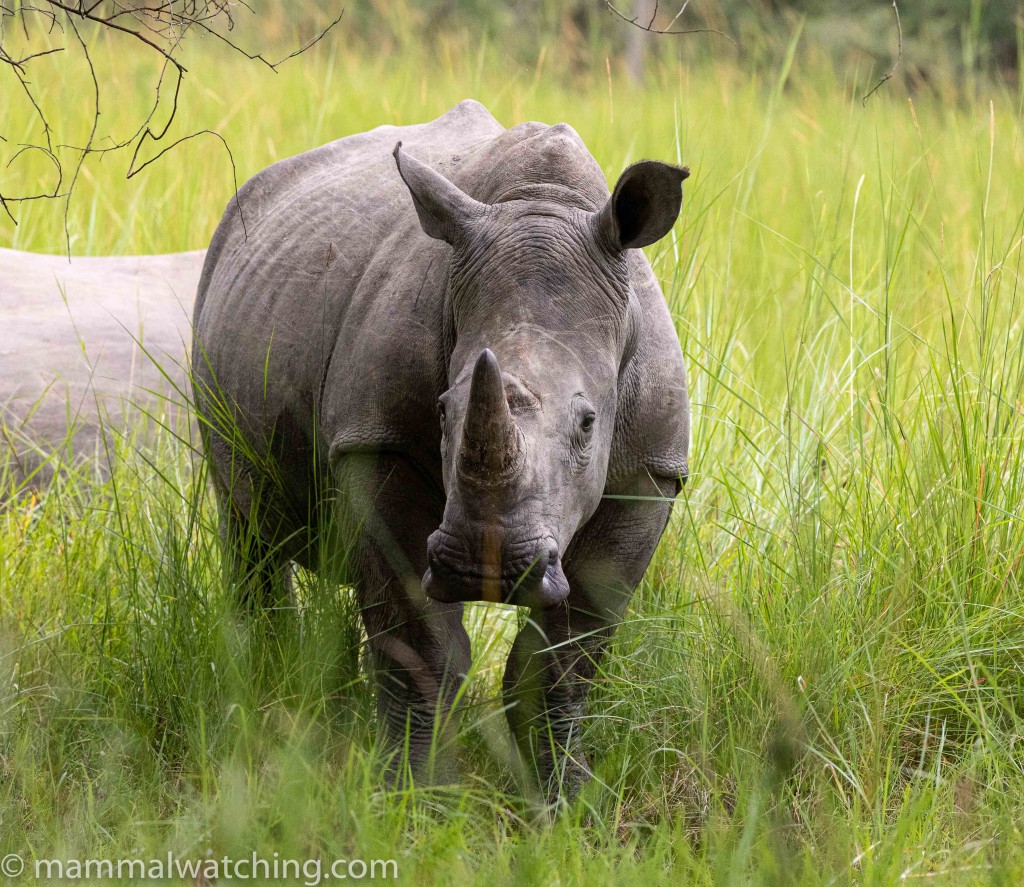
White Rhinoceros, Ceratotherium simum
We stopped for an hour at the Ziwa Rhino Sanctuary to see Uganda’s only White Rhinos. Thirty or so have been reintroduced here (or perhaps introduced if you are a purist as there used to be Northern White Rhinos here) and are breeding. The rhinos are under constant guard and guides will take you to see them on foot. It didn’t feel very wild, but it is always a thrill to see these animals close up.
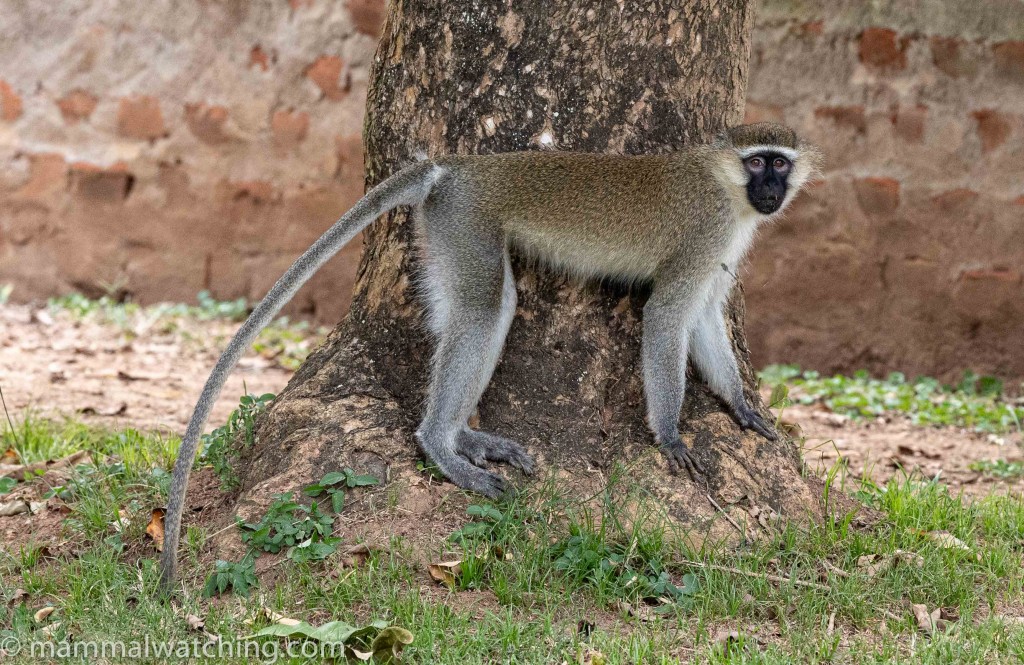
Tantalus Monkey, Chlorocebus tantalus
A few other mammals were running around the sanctuary including Tantalus Monkeys (Vervets are also found in Uganda), Olive Baboons, Warthogs, Kob and Bushbucks.
Murchison Falls National Park
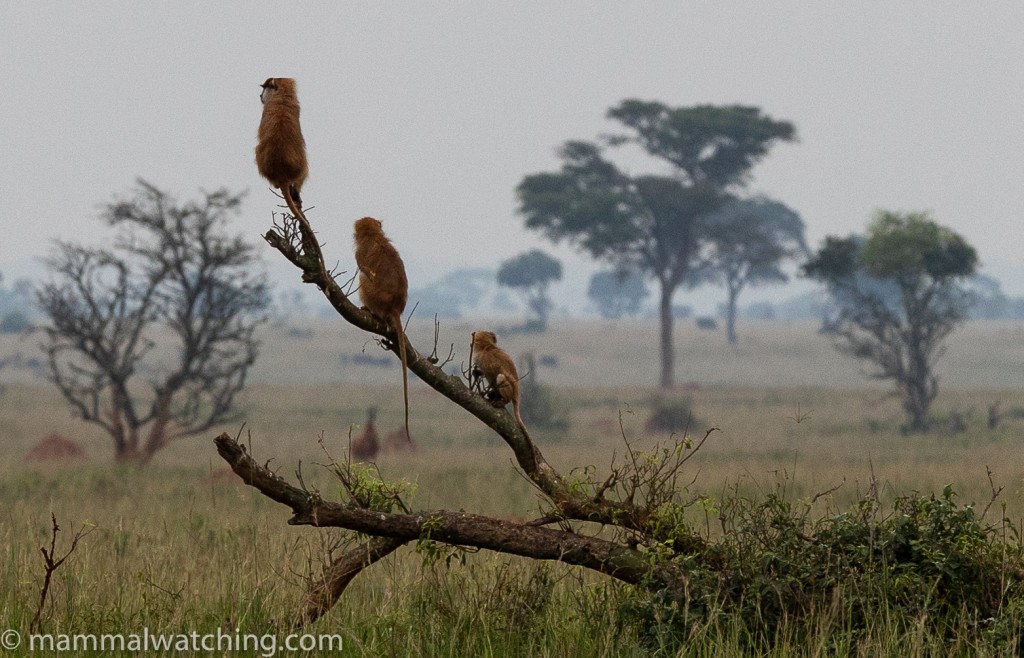
Patas Monkeys, Erythrocebus patas
Budongo Forest Sector
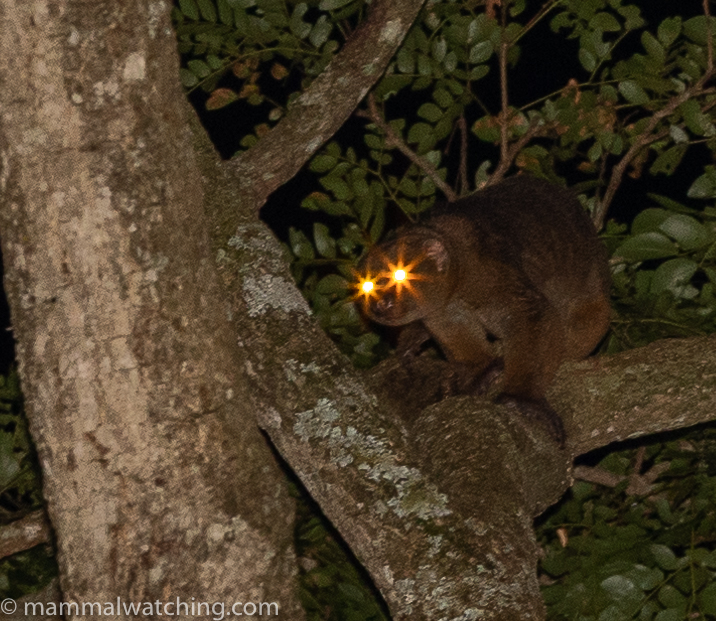
East African Potto, Perodicticus ibeanus
The first official stop of the trip (“official” meaning there were new mammals for me to see) was Budongo Forest just inside the southern boundary of Murchison Falls National Park.
My main target was East African Potto, and we saw several during a two hour night drive. Demidoff’s Galagos were also common, and many sleeping Guerza Colobus and Blue Monkeys caused temporary excitement through the heat scope.
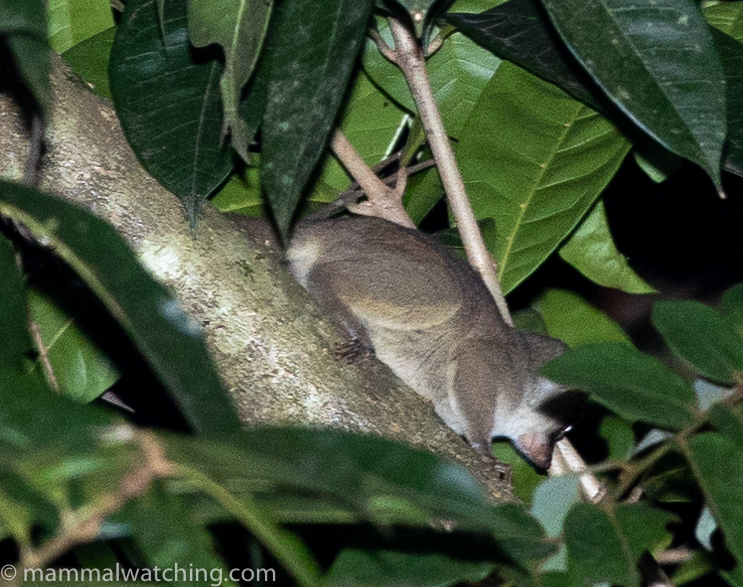
Demidoff’s Dwarf Galago, Galagoides demidoff
I saw a small antelope – likely a duiker – at the edge of the road twice through my thermal scope but it melted into the forest before we could get a light on it.
Pakuba Lodge and the Savanna
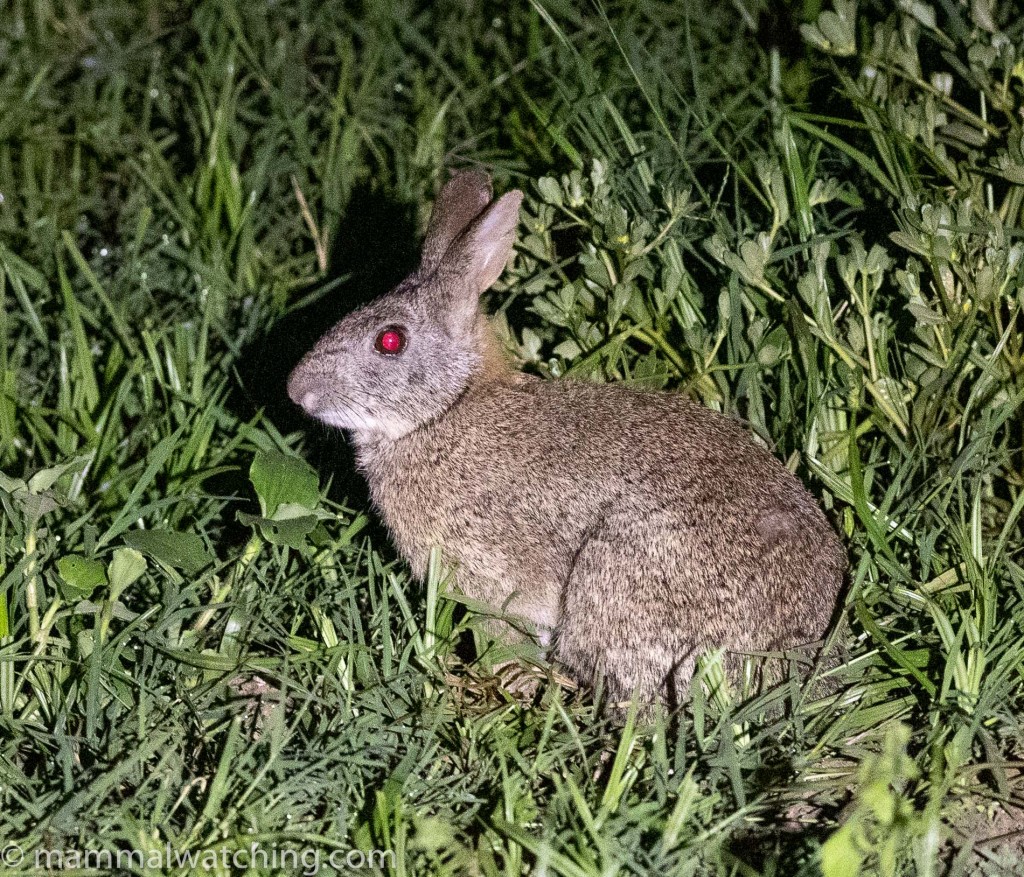
Bunyoro Rabbit, Poelagus marjorita
Murchison Falls National Park is Uganda’s largest, and comprises about 4000 square kilometres of savanna, bounded to the west by Lake Albert.
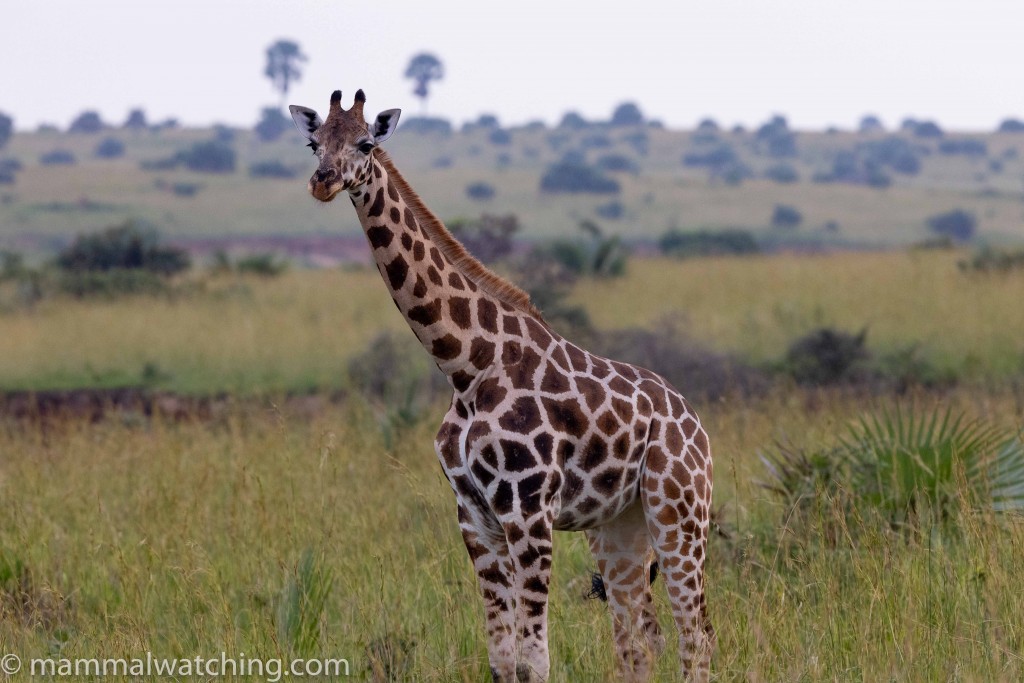
Giraffe, Giraffa camelopardali
We saw a lot of game on the morning drive from Budongu Forest to Pakuba Lodge.
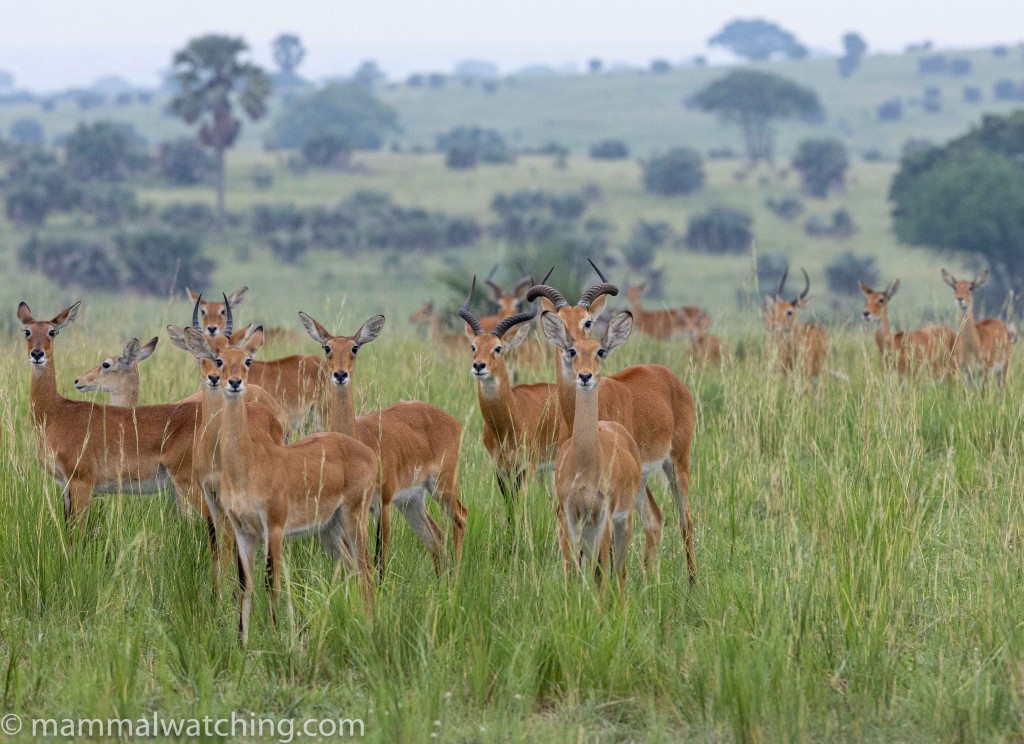
Kob, Kobus kob
Uganda Kob were abundant, as were Oribi.
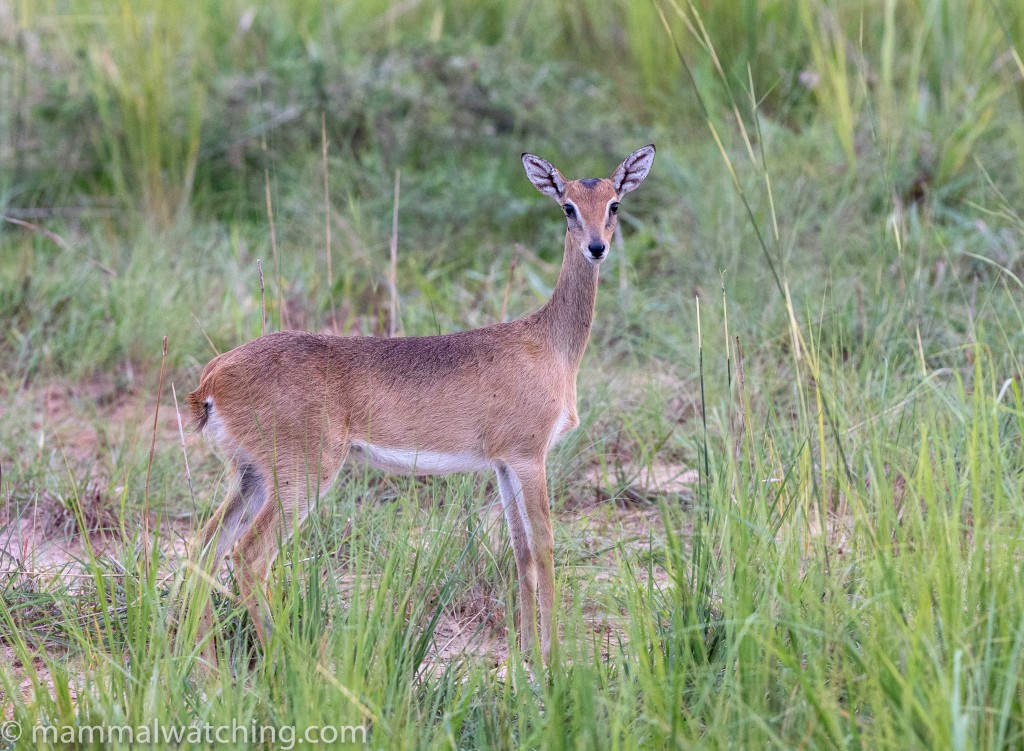
Oribi, Ourebia ourebi
And there were plenty of Waterbuck, Giraffe, Buffalo, Hartebeest, Warthogs, Olive Baboons, Banded Mongoose and Elephants.
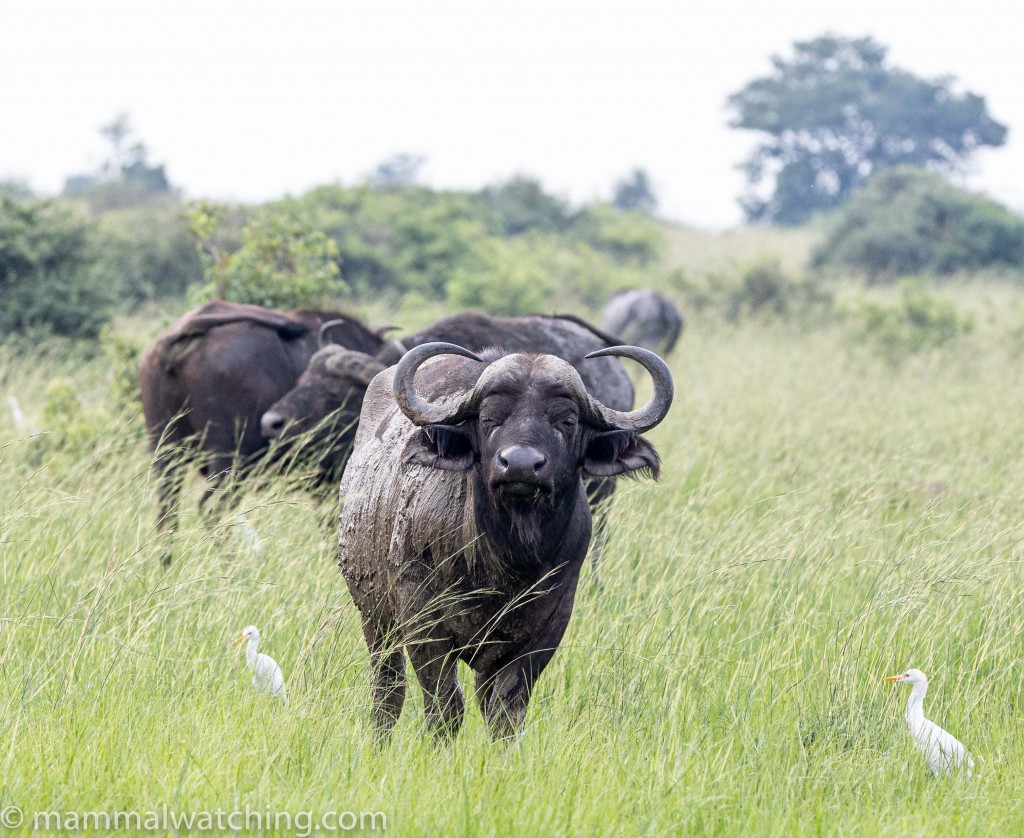
African Buffalo, Syncerus caffer
Along with Hippos and Striped Ground Squirrels at the Lake Albert shore.
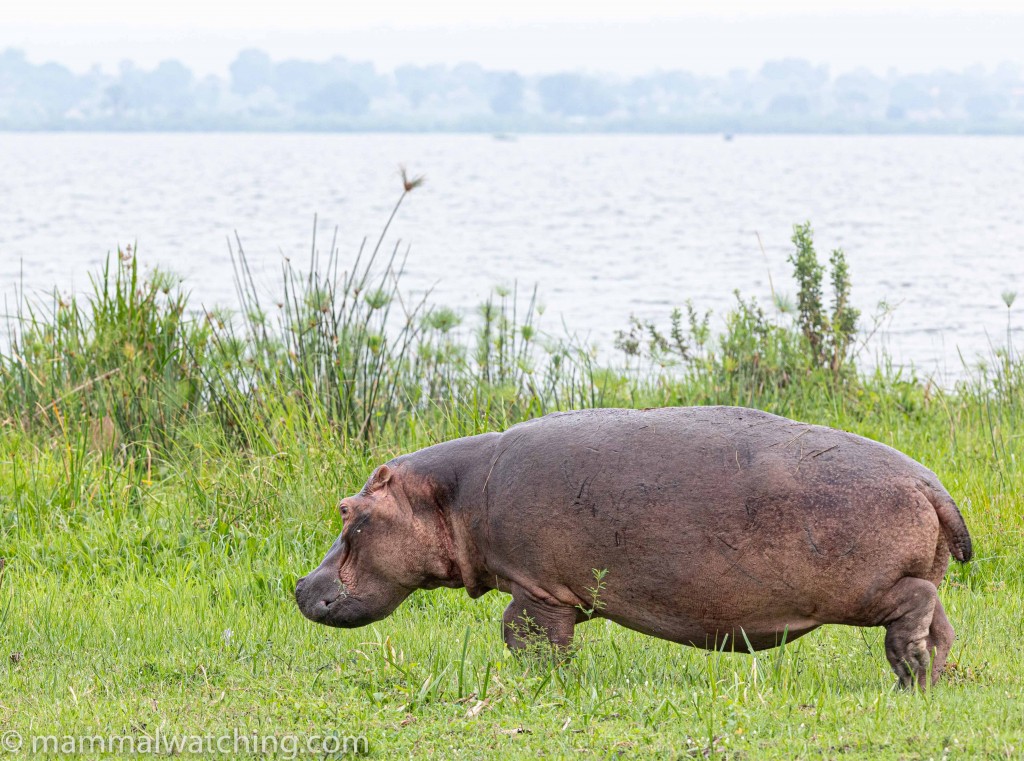
Hippopotamus, Hippopotamus amphibius
My diurnal target here was the beautiful Patas Monkey, a species that holds the record for the world’s fastest primate. They are easy to see here. And yes they can run fast.
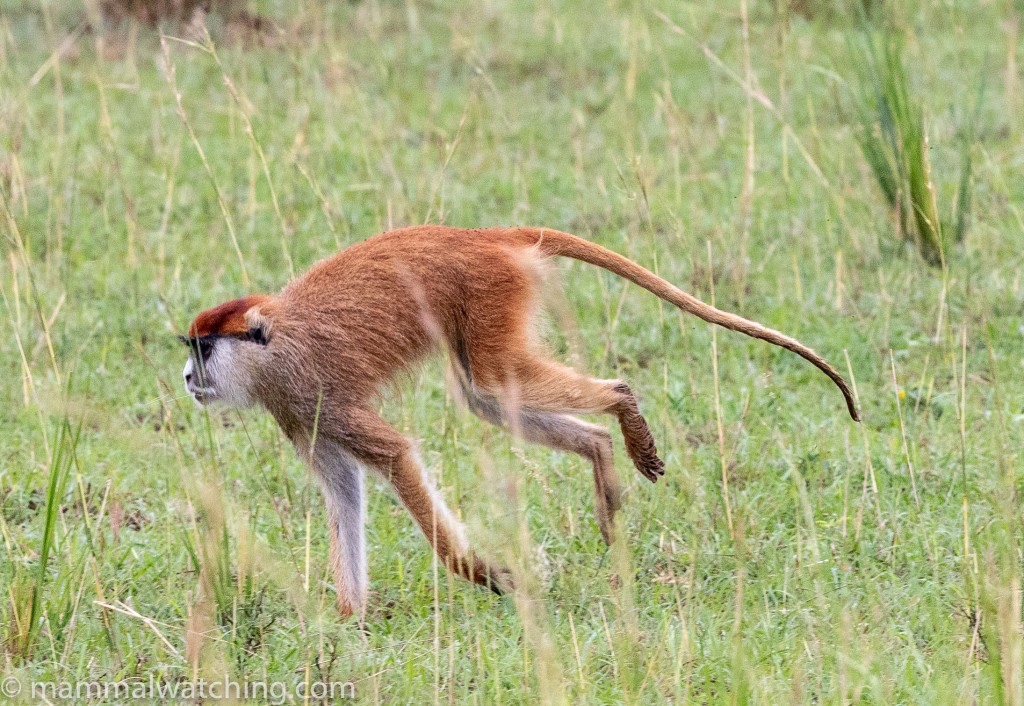
Patas Monkey, Erythrocebus patas
My other key target was the Ugandan endemic Bunyoro Rabbit, for which we would need to wait until dark.
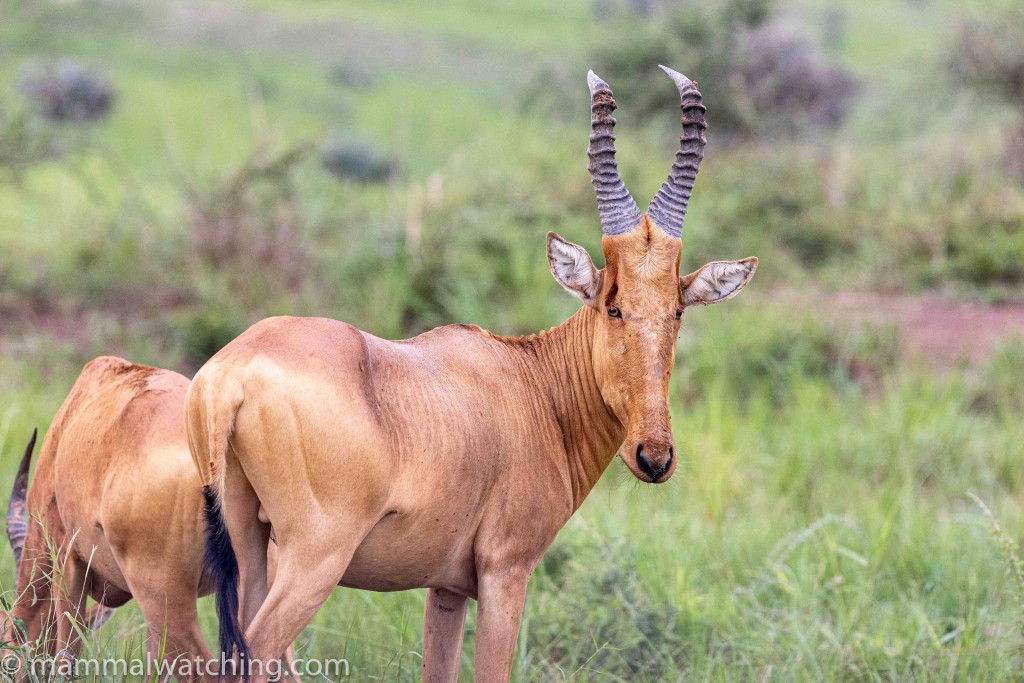
Hartebeest, Alcelaphus buselaphus
Pakuba Lodge had Mauritian Tomb Bats, roosting on trees near the main building.
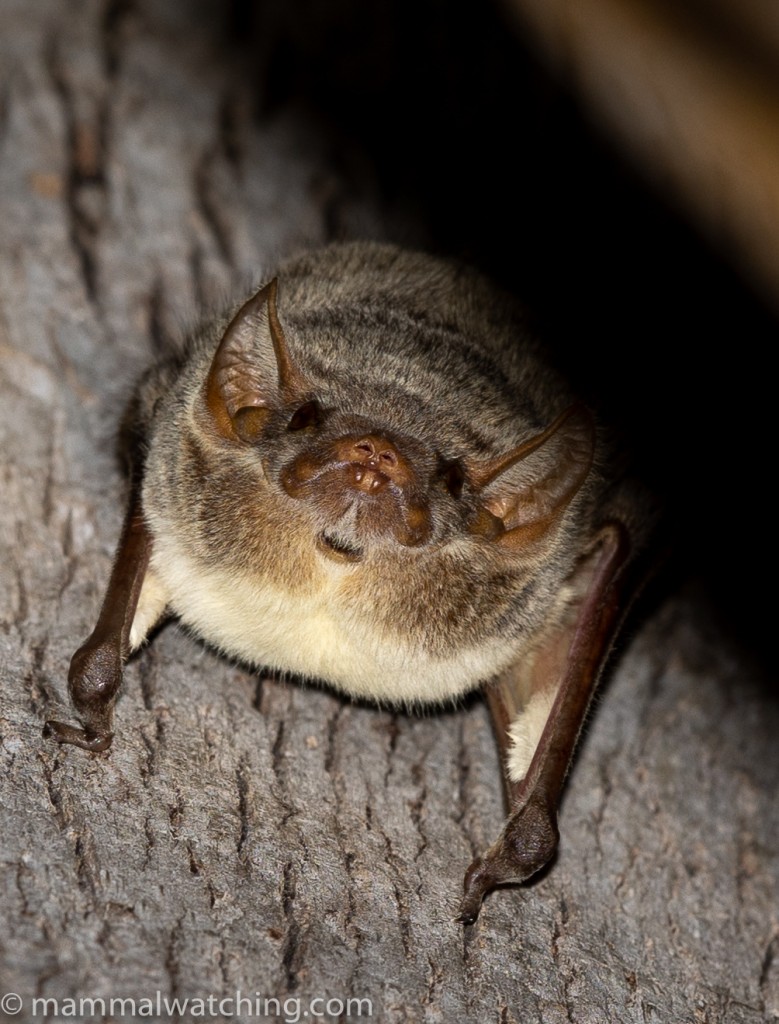
Mauritian Tomb Bat, Taphozous mauritianus
There were also some Little Free-tailed Bats peeping out from under the eaves of the reception building’s roof at dusk.
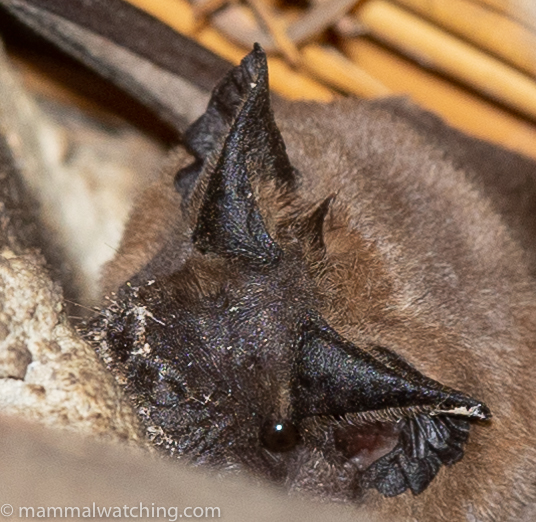
Little Free-tailed Bat, Chaerephon pumilus
Just before sunset we visited the ruins of the original Pakuba Lodge, that Idi Amin decided – in the 1970s – ought to be his personal lodge. The ruins were full of bats, but Harriet was nervous about me leaving the truck to look as lions and leopards frequent the place.
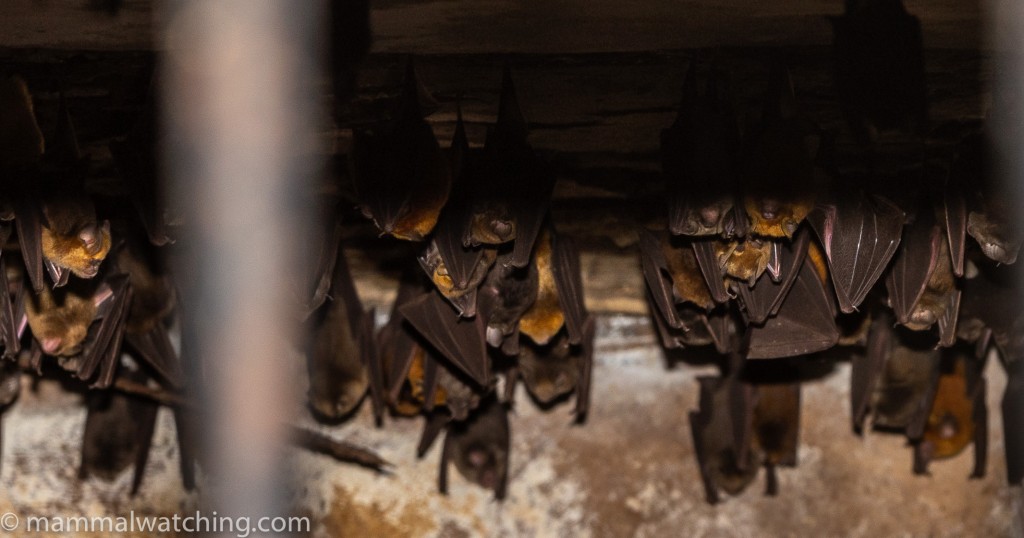
Sundevall’s Roundleaf Bats, Hipposideros caffer
But the bats were impossible to photograph well. After 10 minutes without any sign of predators I left the car and walked a bit closer. The bats were still very difficult to photograph but appeared to be Sundevall’s Roundleaf Bats.
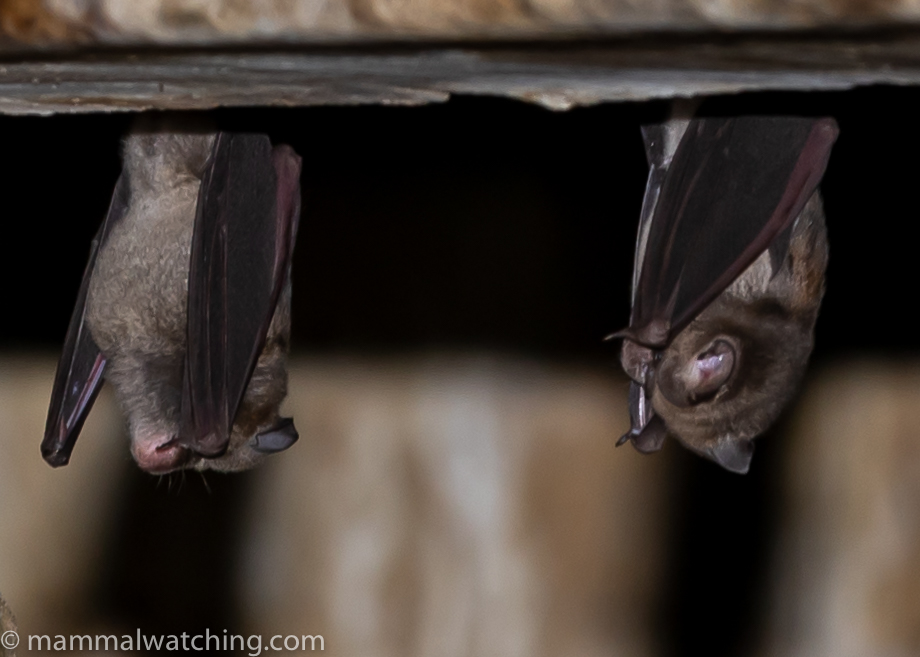
Sundevall’s Roundleaf Bats, Hipposideros caffer
A night drive after dinner was productive. We saw several Bunyoro Rabbits before we left the lodge gardens. My camera batteries died not long after, so I missed photos of three or four Kemp’s Gerbils (also a lifer), a White-tailed Mongoose and a North African Crested Porcupine. I did manage a photo of this Side-striped Jackal with the last bit of juice in my camera.
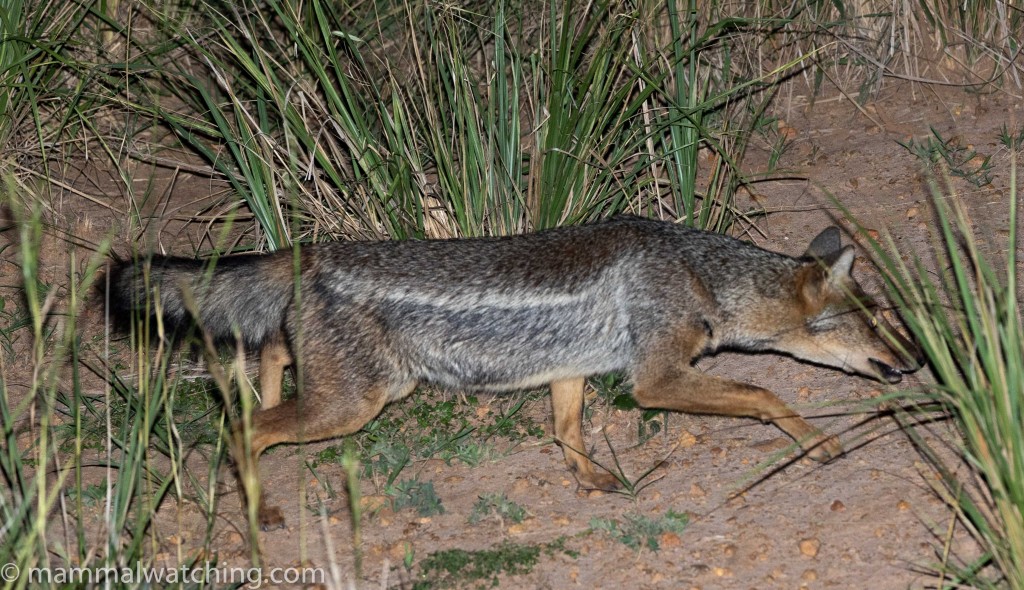
Side-striped Jackal, Lupulella adustus
After breakfast the next morning we set off through the park on the long drive to Semuliki National Park.
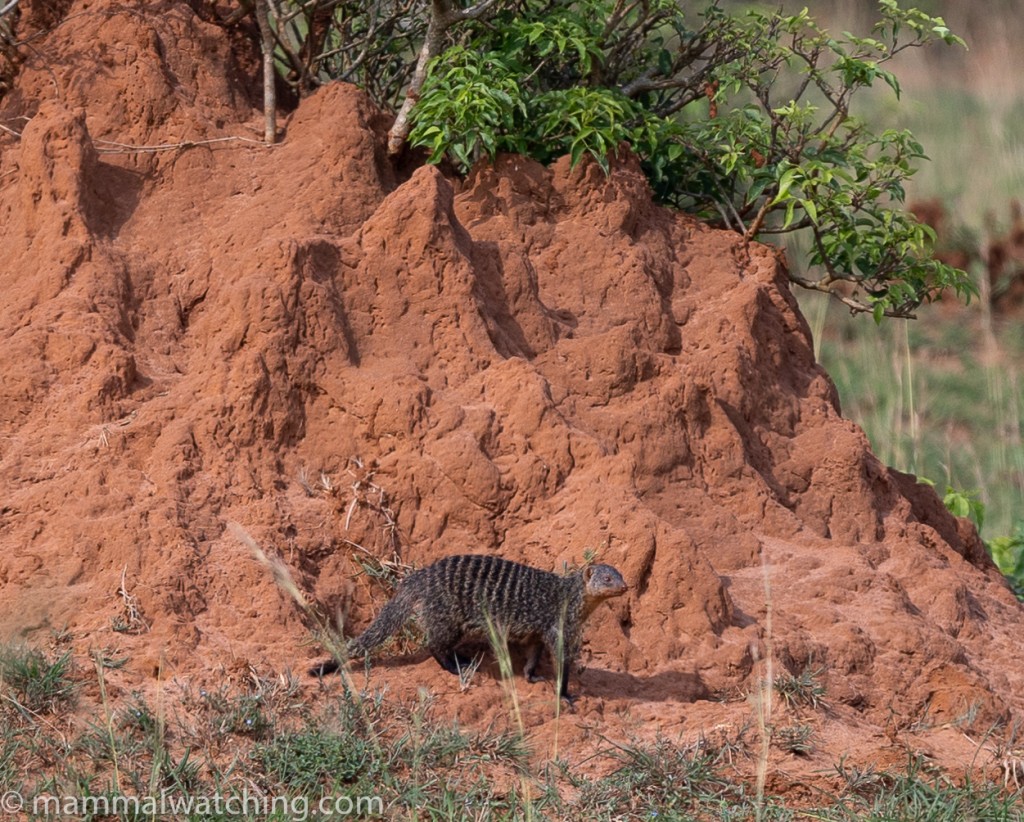
Banded Mongoose, Mungos mungo
Two or three kilometres from the lodge, within a hundred metres of Lake Albert, a mongoose dashed in front of the vehicle. I had only a glimpse and mentally marked it down as either a Dwarf or possibly a Banded Mongoose.
But Harriet, who was sitting up front, had a different opinion. It was too large to be a Dwarf Mongoose and looked wrong for Banded. She thought it was a Pousargue’s Mongoose. We stopped the car.
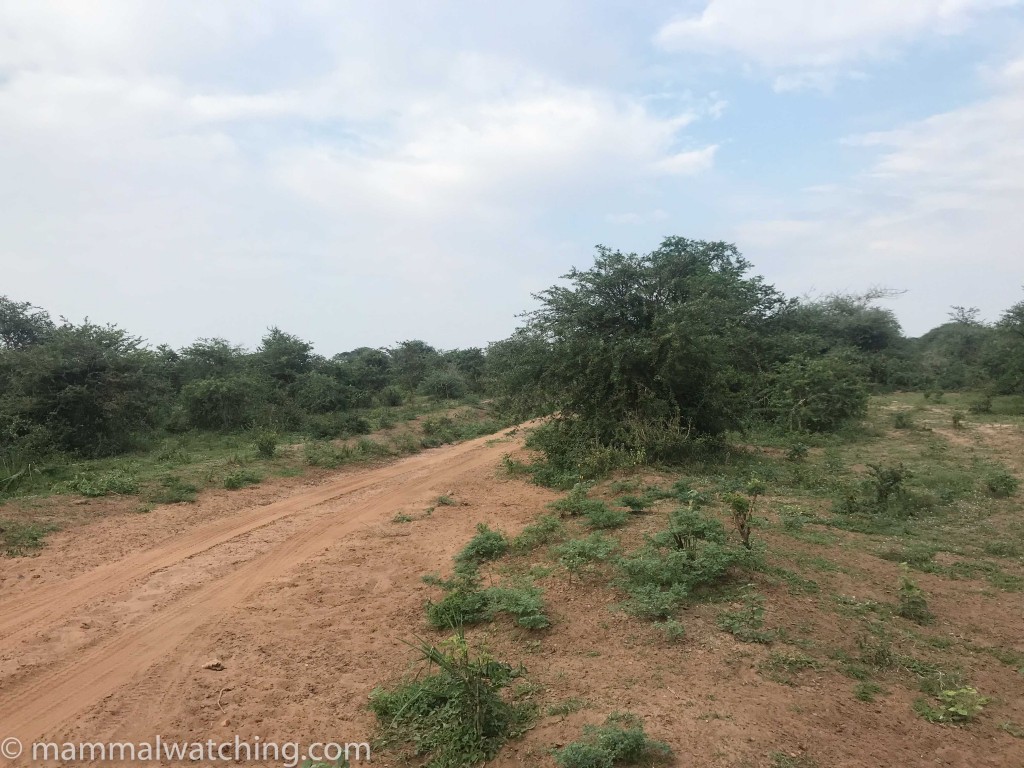
Pousargue’s Mongoose habitat
Harriet had never knowingly seen a Pousargue’s Mongoose before. Until Tomer and Alex’s January trip she had never even heard of the species. But after their visit, and in the process of researching mine, they were firmly on her radar.
So we waited by the bush which the mongoose had disappeared under, presumably running into the hole at its base.
A few minutes later Joel saw another mongoose dash across the road and under the same bush.
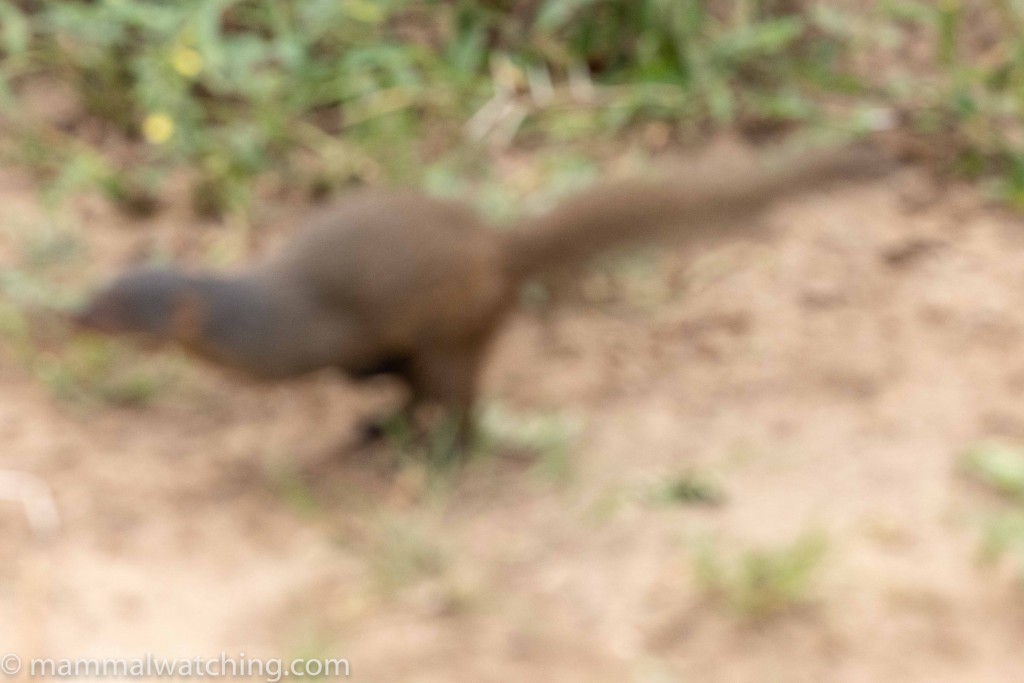
Pousargues’ Mongoose, Dologale dybowskii
We prowled around for the next hour. We had glimpses of three animals dashing from bush to bush and back again. They were very fast and very sneaky. I managed to take a few terrible photos of one or two mongooses as they sprinted for cover and the animals were a very good match for the few photos I had seen of Pousargue’s. Harriet was in no doubt.
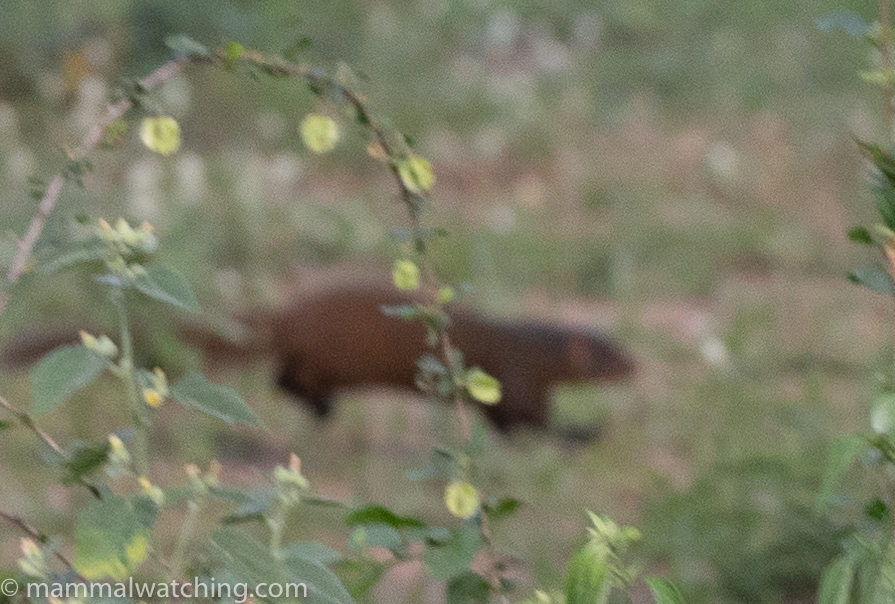
Pousargues’ Mongoose, Dologale dybowskii
Their behaviour was also different to Banded Mongooses, which usually travel in much larger groups and will generally stop, look back and sit up to examine a potential threat. These animals travelled alone, sprinting low to the ground from one bush to another.
Though my pictures are frustratingly awful they, together with our notes on the animals’ behaviour, were sufficient to persuade Chris and Tilde Stewart that these must indeed be Pousargue’s Mongoose. And that is good enough for me!
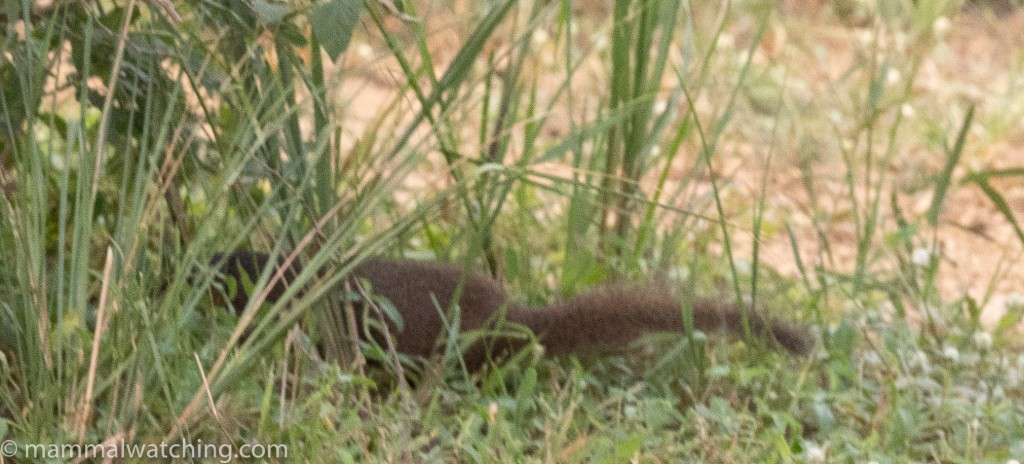
Pousargues’ Mongoose, Dologale dybowskii
If Wikipedia is to be believed, there are only 30 specimens of this species in museum collections, while the animals have only be recorded a handful of times over the past ten years and never at Murchison Falls. And yet I saw three within 24 hours in a popular national park without any special effort.
My guess is that they are likely not uncommon here (Vladimir Dinets thought he saw them here too), but that no one has paid much attention. Most visitors and guides have likely never heard of the species. If it wasn’t for Tomer and Alex’s trip, and my questions, Harriet would not have paid attention to them either. A nice example of citizen science in action and the cascading benefits of mammalwatching for conservation. I will write a note for the IUCN (now here: Two observations of Pousargues’s Mongoose in Murchison Falls National Park, August 2021)
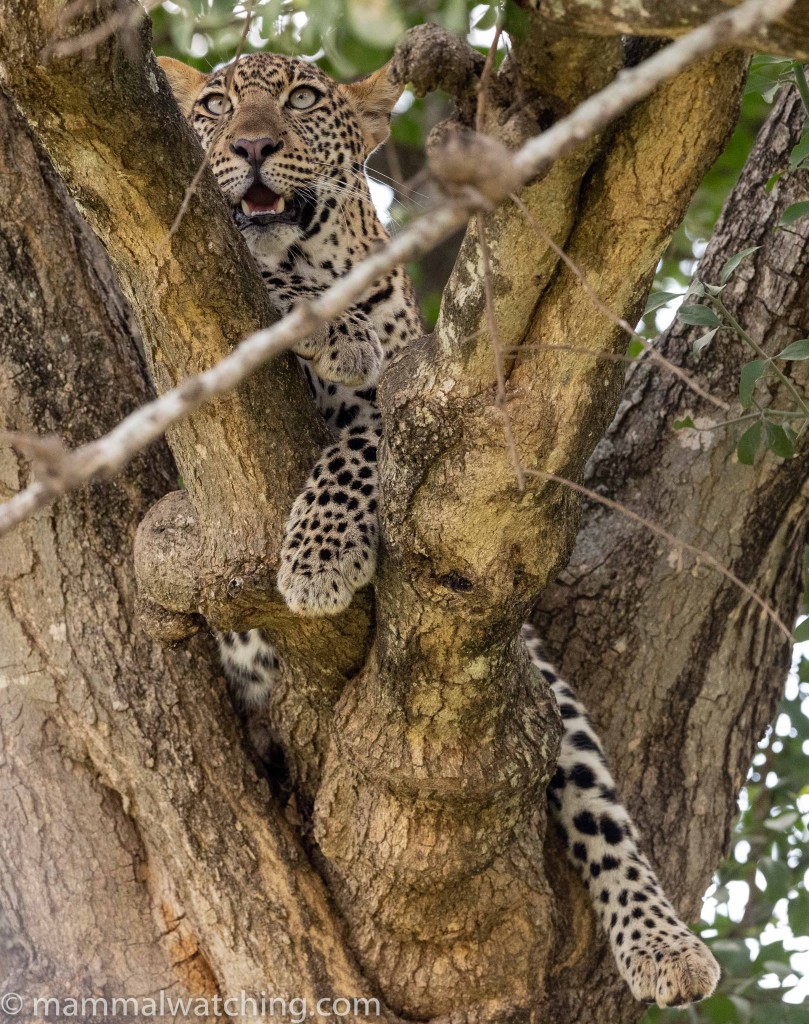
Leopard, Panthera pardus
Highly delighted – even my kids were impressed – we carried on through the park. A Leopard in a tree was the highlight.
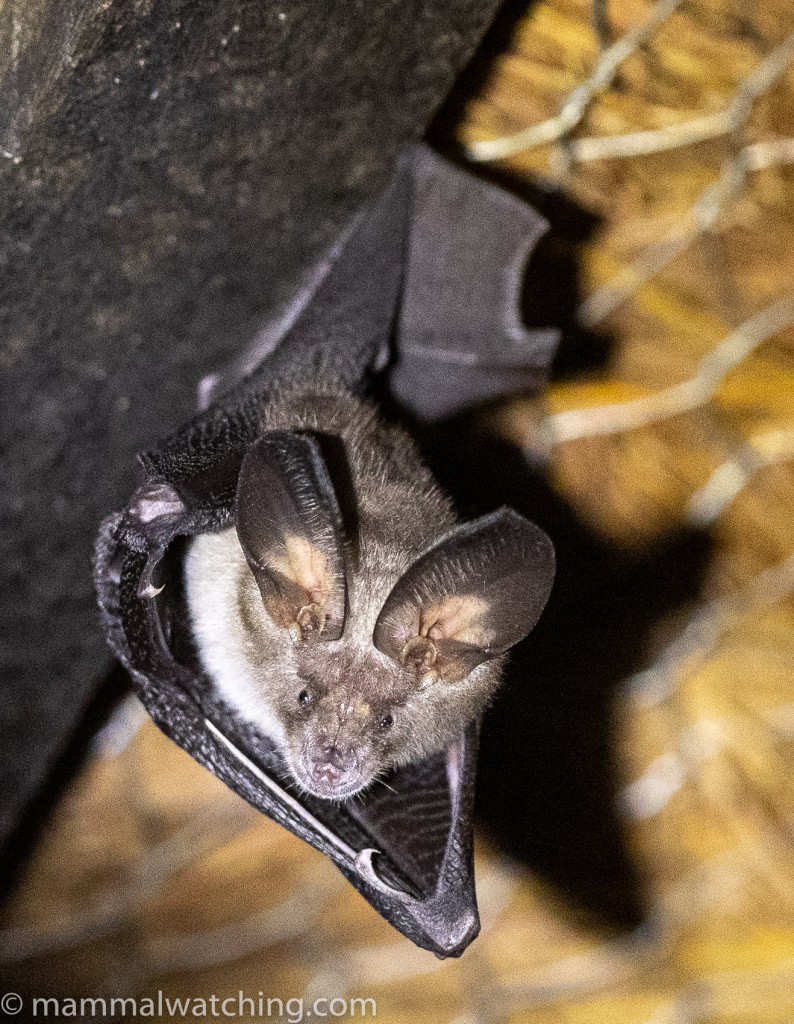
Probably an Egyptian Slit-faced Bat, Nycteris thebaica
We stopped at Red Chili Camp to see the roosting bats that Harriet had heard about. They were a Slit-faced bats, probably Egyptian.
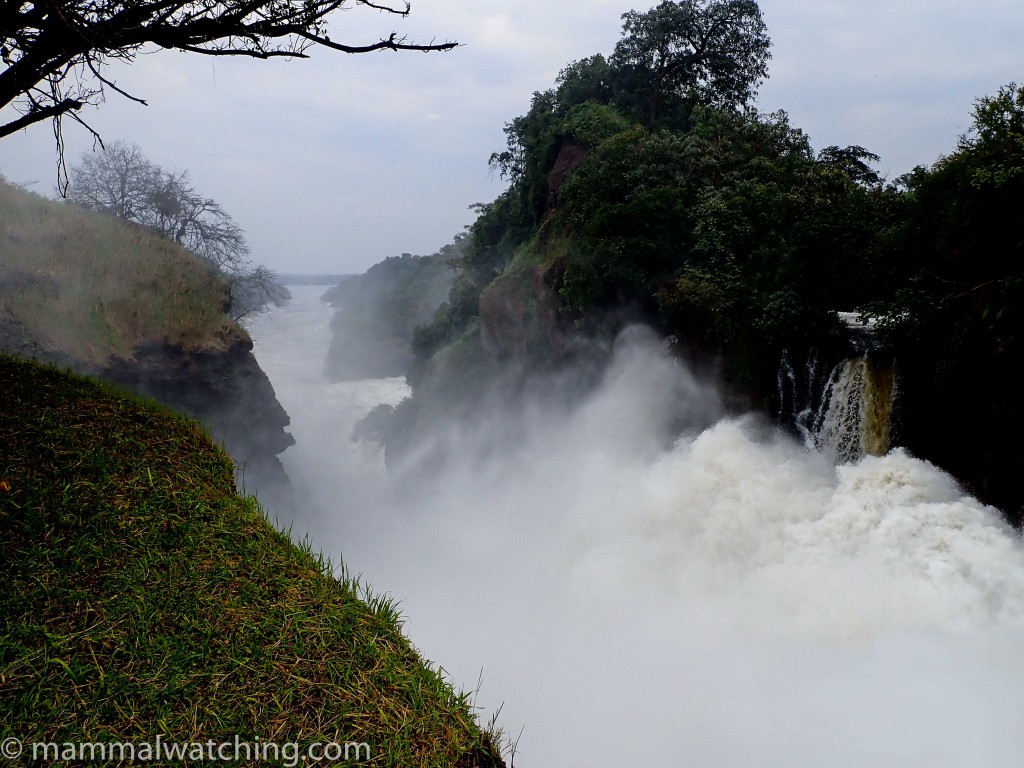
Murchison Falls
A stop at the actual Murchison Falls was worth the detour. We spent the rest of the day driving to Semuliki National Park, arriving well after dark in part because of car trouble.
Semuliki National Park
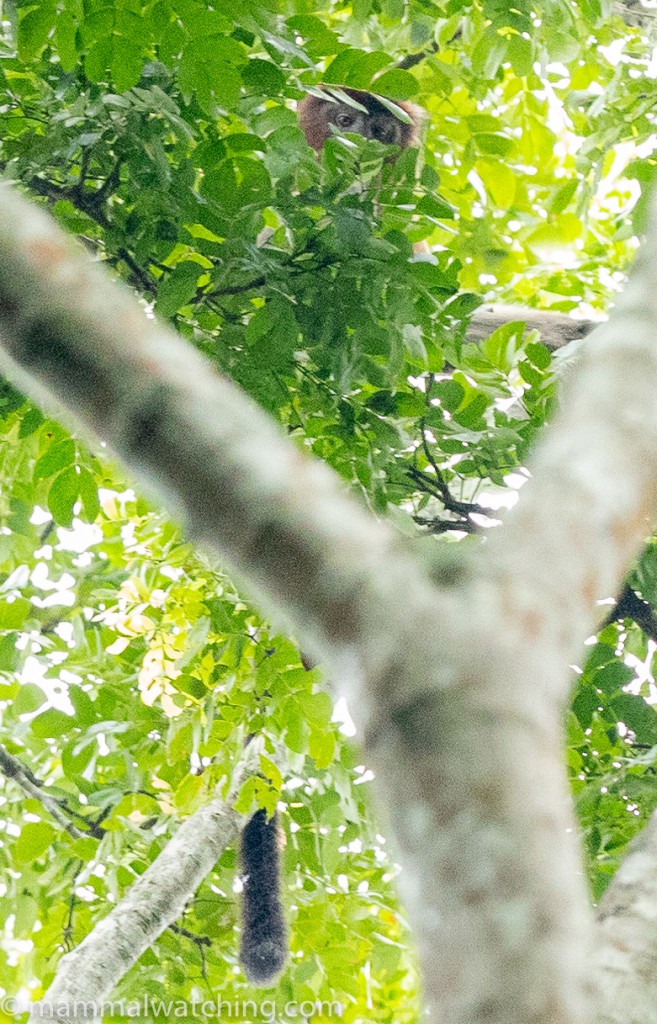
Semliki Red Colobus, Piliocolobus semlikiensis
Semuliki National Park is primate central. This lowland rainforest borders the DRC: Ituri Forest, home to Okapis, is on the other side of the Semliki River that is a boundary of the park. I was hoping for three new species of primates here, a new squirrel and some bonus bats and rodents.
Both Carlos and Tomer/Alex had had productive night walks around the hot springs area at the edge of the park. I was keen to follow in their footsteps, especially to look for the Link Rats they had seen. But, despite Harriet’s efforts, we were not allowed to visit the area after dark at short notice. The ranger blamed this on security problems: there was, he said, an army presence in the area because of people illegally entering the park from the DRC. I suspect good old-fashioned bureaucracy was also to blame. We didn’t see any soldiers while we were there.
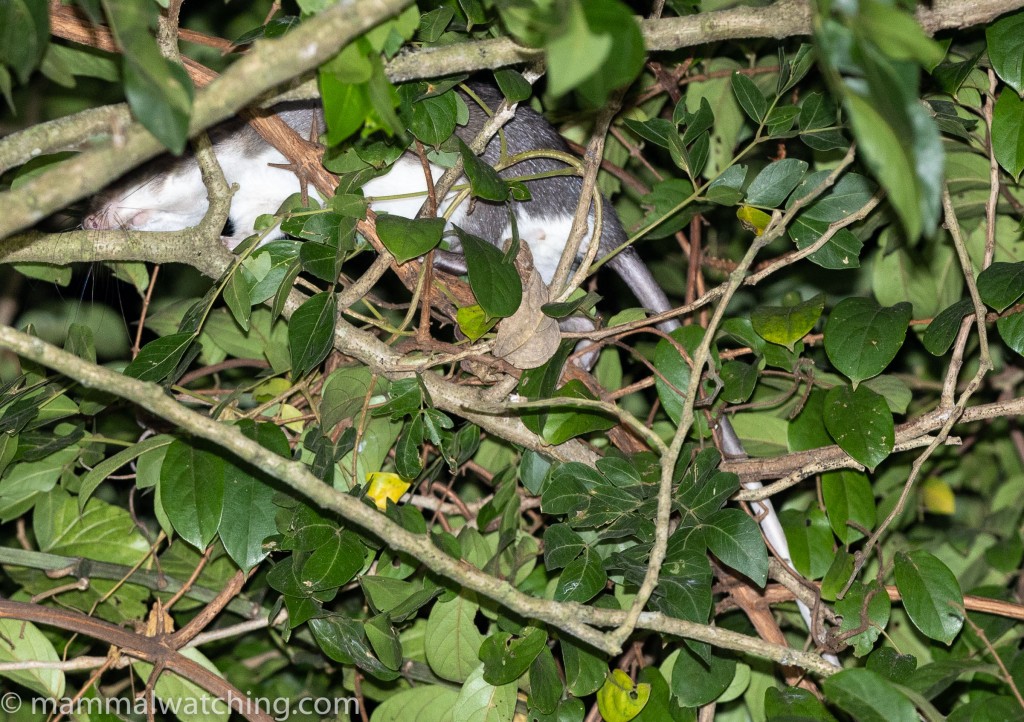
Forest Giant Pouched Rat, Cricetomys emini
A little disappointed, we took a short night walk around the forest cabins and along the road. The only mammal was a large Emin’s Pouched Rat. Not as fun as the Link Rat I was hoping for but a lifer nonetheless.
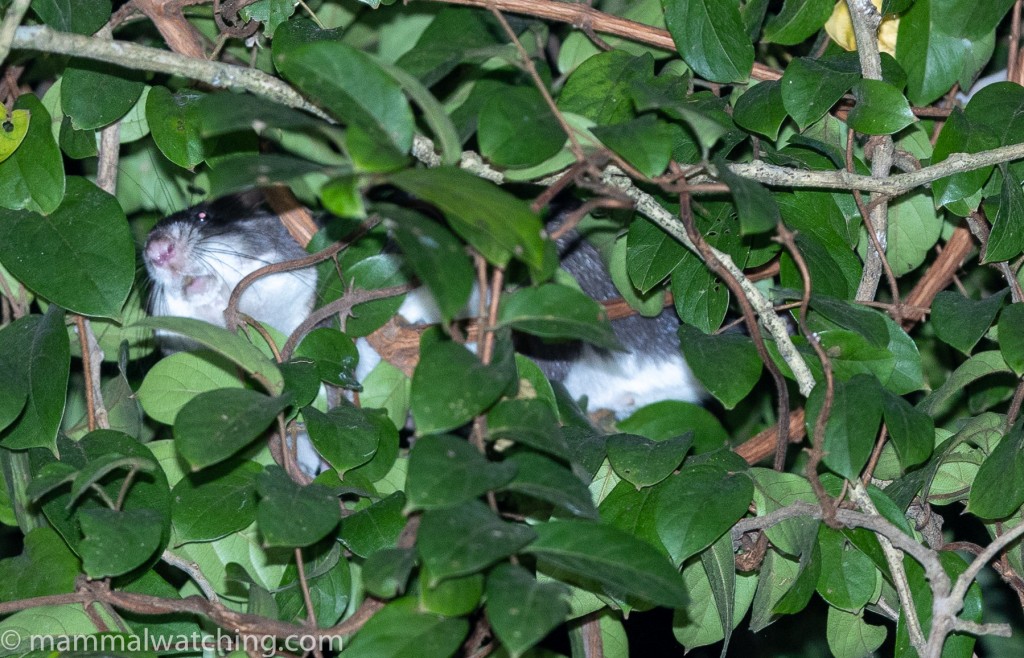
Forest Giant Pouched Rat, Cricetomys emini
The following day would involve a long – potentially all day – walk through the forest in search of three target primates: De Brazza’s, Dent’s and Semliki Red Colobus Monkeys. Harriet thought the red colobus would be the hardest to find of the three, though we had a very good chance of finding them all in a day.
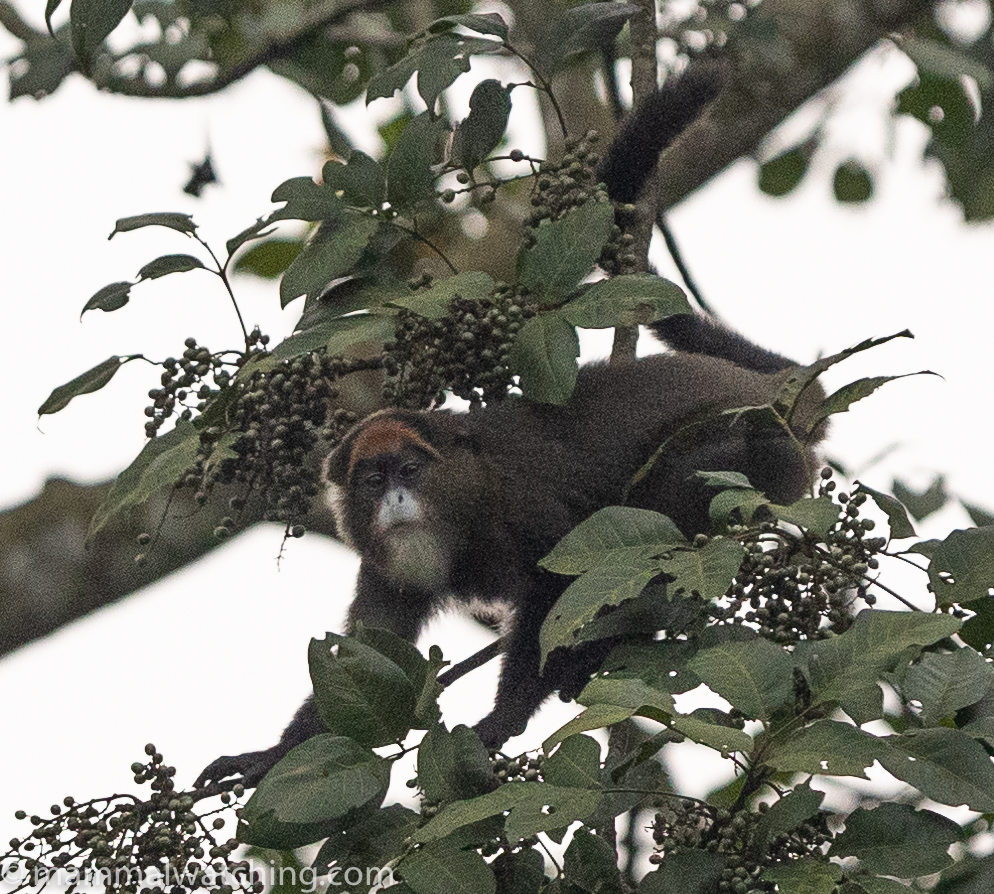
De Brazza’s Monkey, Cercopithecus neglectus
The De Brazza’s Monleys were easier than expected. We saw an animal at first light from the dining area at the Burnaga Campsite while we were eating breakfast. A great monkey. I had spent several hours waiting, monkeyless, beneath a tree in the Central African Republican that one had jumped into. So I was very happy to finally see one.
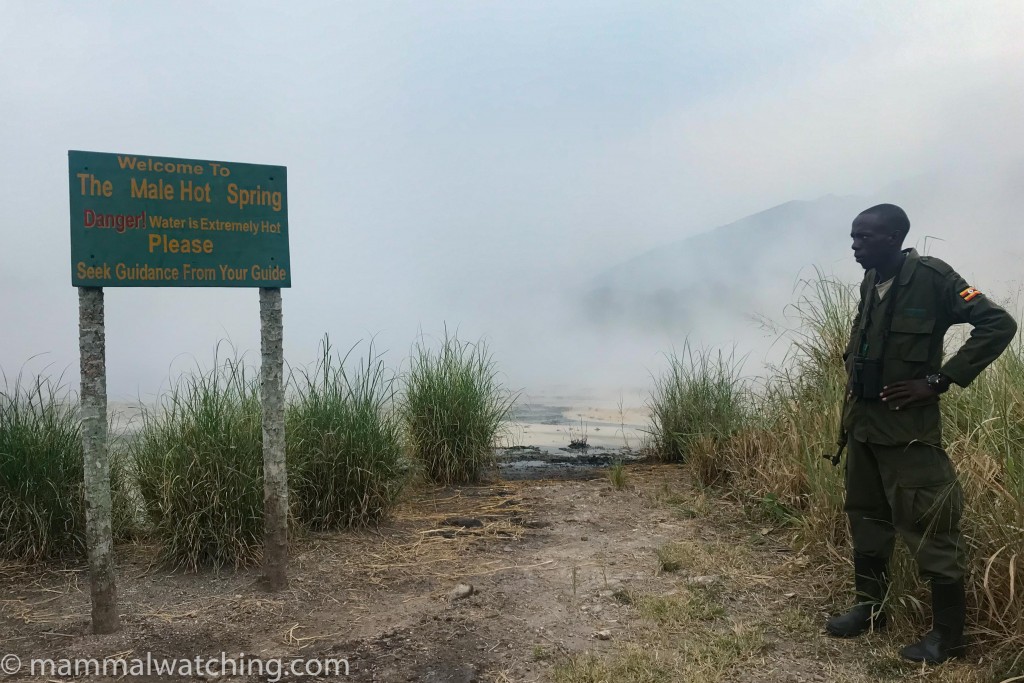
Our first stop were the male and female hot springs areas close to the camp. This is a reliable area to find De Brazza’s Monkeys and we saw several distant groups.
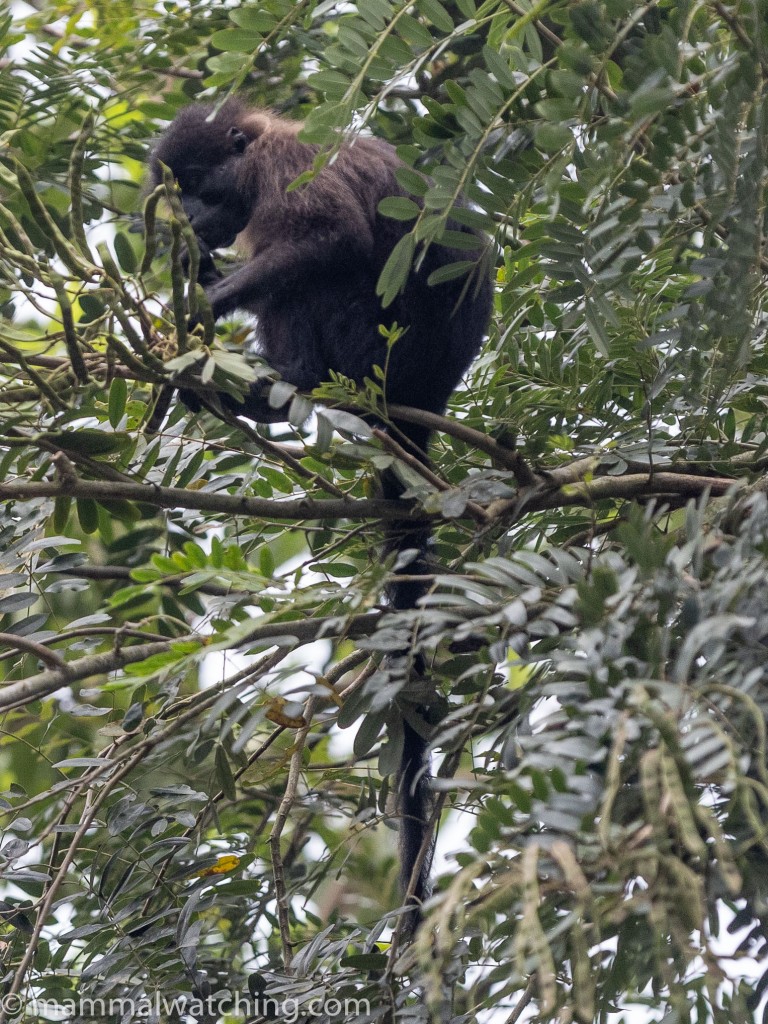
Grey-cheeked Mangabey, Lophocebus albigena
At the nearby park offices we saw our first Grey-cheeked Mangabeys. Some people record this species as Johnston’s Crested Mangabey, with the species in Kibale recorded as the Uganda Crested Mangabey. I follow the recent thinking that they are all Grey-cheeked Mangabeys and should not have been split.
There were Mauritian Tomb Bats at the offices, and a walk along a short trail there did not produce the Stuhlman’s Elephant Shrews that Alex our guide saw frequently. But Olive Baboons and Guereza Colobus were around.
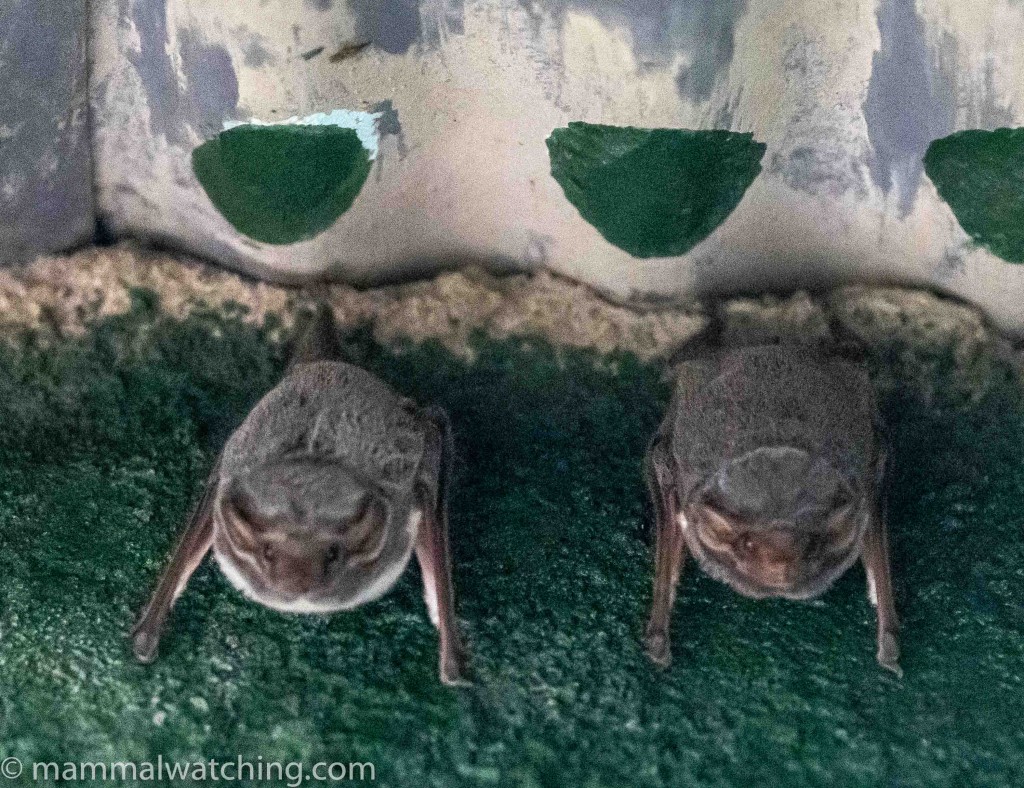
Mauritian Tomb Bats, Taphozous mauritianus
And then we headed off into the forest in search of Dent’s Monkeys and Semuliki Red Colobus. The silence broken only by the occasional bird call or my daughter, Katy, sighing pointedly behind me. Katy detests heat, humidity and biting insects. And she was a little ‘apprehensive’ about the hike. In fact she was livid with me for subjecting her to it. Apparently being left alone all day at the campsite was not an acceptable alternative.
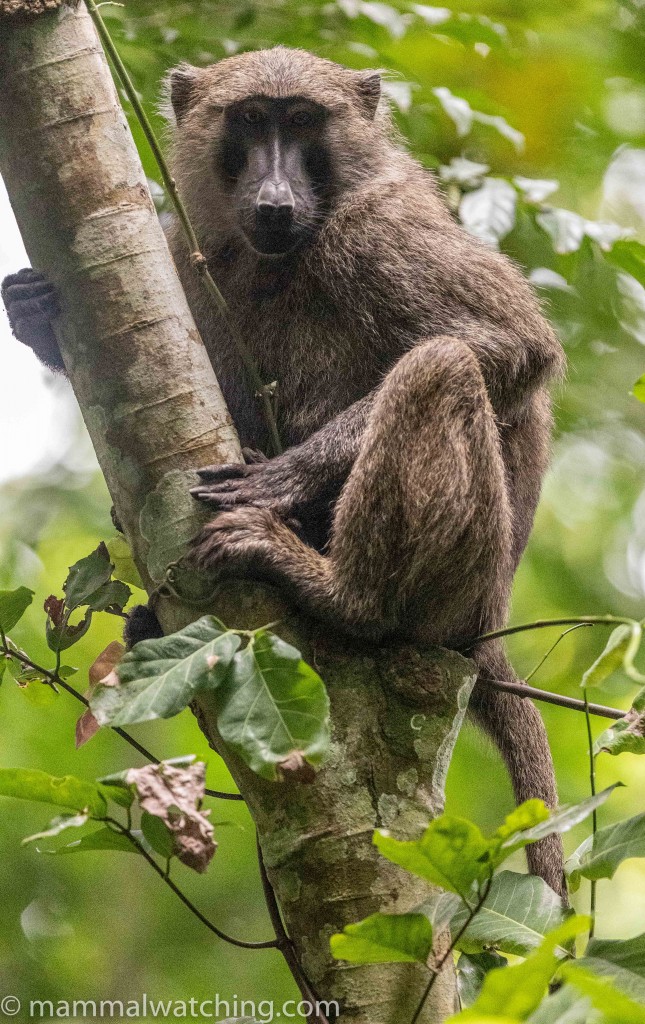
Olive Baboon, Papio anubis
But the walk was far more comfortable than I was expecting. Temperatures and humidity were far more pleasant than July in New York City. There was no mud. And the only biting bugs we encountered were ants. Whenever Katy saw them on the trail she would break into a frenzied series of spasms to dance past them: think James Brown dancing on a live subway track. This was, naturally, a source of amusement to the rest of us. Even more amusing was taking it in turns to say “Hey Katy, have you ever seen an idiot dance? OH WATCH OUT! ANTS!!”.
This was hysterical. All three times we did it. Katy did not seem to find it as funny as we did.
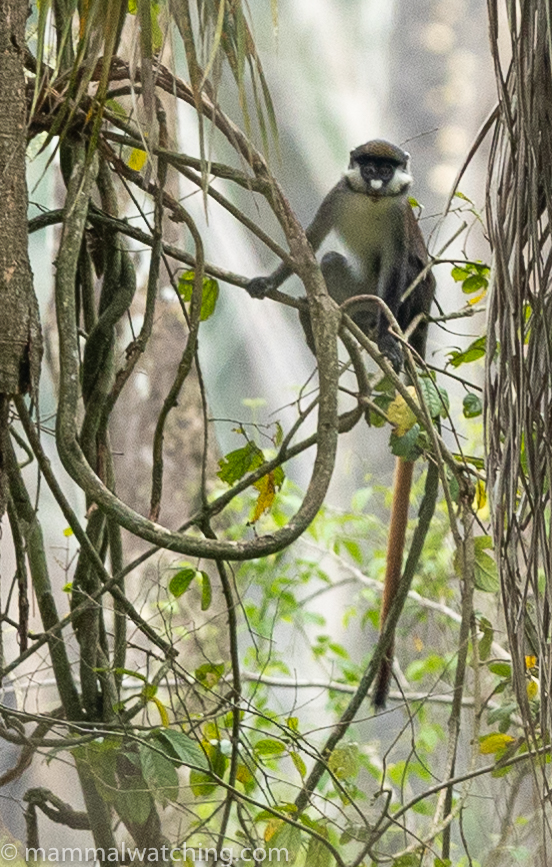
Red-tailed Monkey, Cercopithecus ascanius
We saw Red-tailed Monkeys, a species I had only seen once before in Rwanda, Blue Monkeys and Guereza Colobus, as well as a brief look at my first Alexander’s Bush Squirrel.
Two hours later we were at an old army camp, that would be basecamp for the rest of the day while we searched for the more difficult primates.
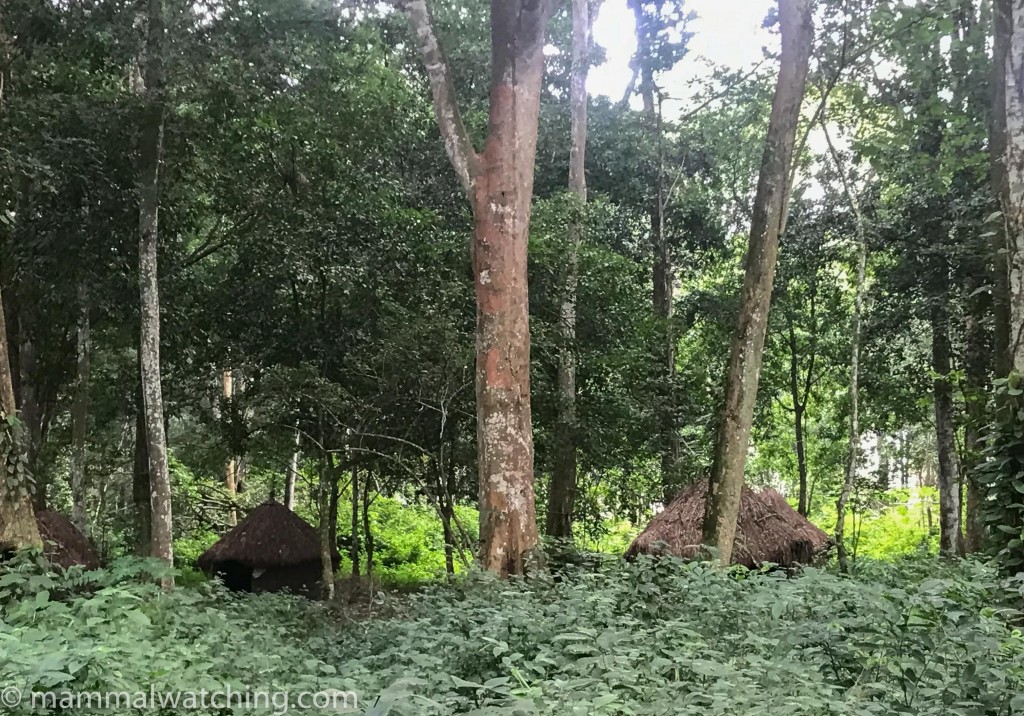
Ye Olde Army Campe
We poked around the huts here but couldn’t find any of the Doryhina Leafnosed Bats that others had seen here. There were some slit-faced bats roosting in a hollow tree. They might well be Andersen’s Slit-faced Bats (Nycteris aurita) and I wanted them to be … but without catching one I could not be sure.
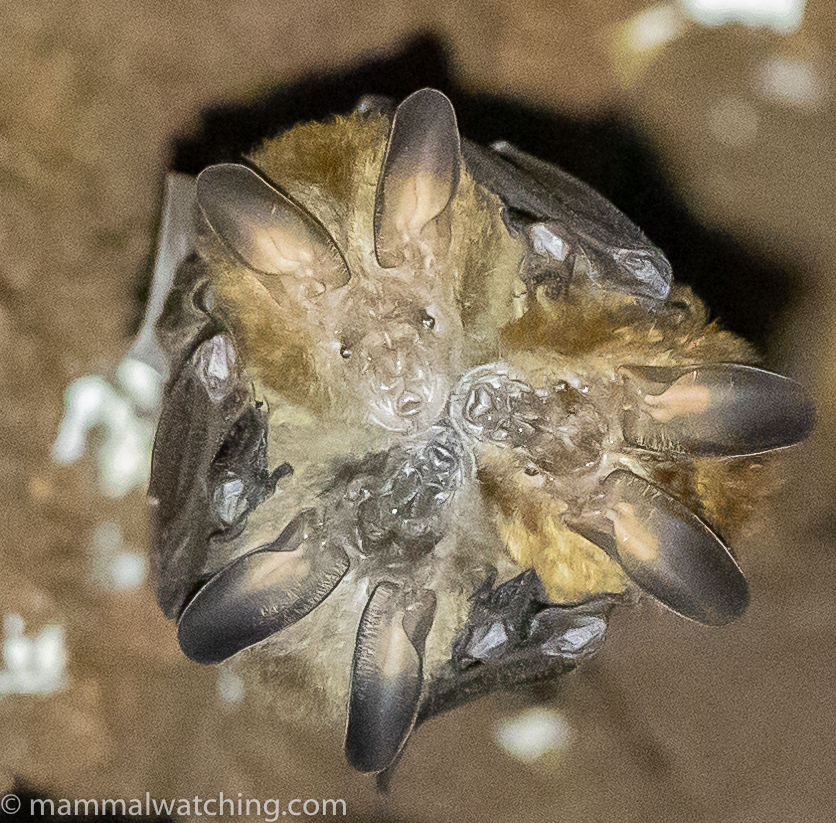
Possiby Andersen’s Slit-faced Bats, Nycteris aurita
While I was looking for bats, Katy spotted some monkeys that were indeed Dent’s Monkeys. I felt guilty for the ant pranks.
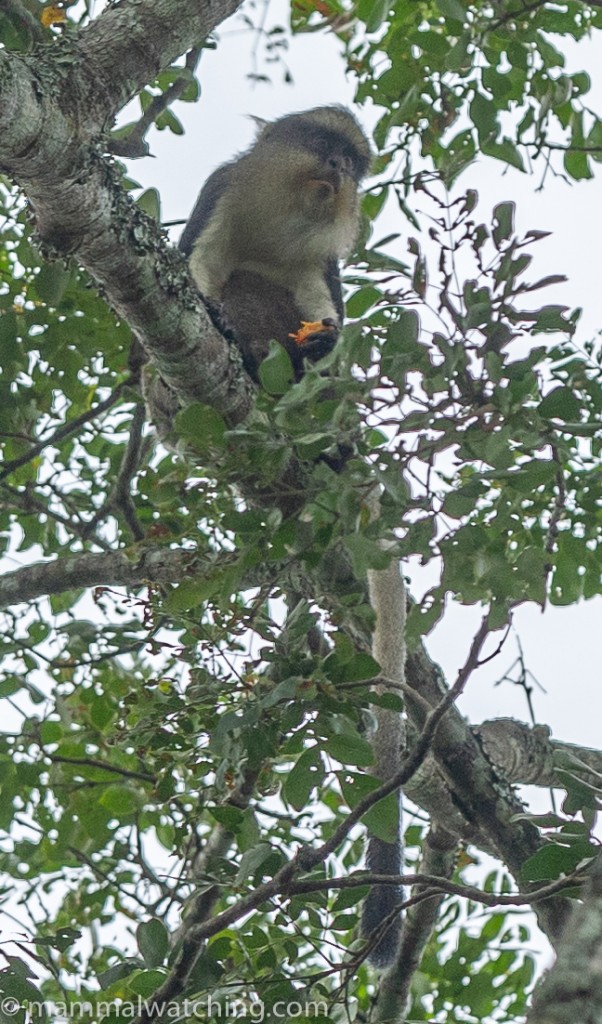
Dent’s Monkey, Cercopithecus denti
Alex, our guide, wandered off in search of Semliki Red Colobus which are often in the area. I walked along the river a little way and carefully checked out a hundred monkeys in a large mixed troop of Dent’s and Red-tailed Monkeys, eventually seeing a Semliki Red Colobus looking back at me. We had long – though distant – views of several animals, all of which were being rather cryptic.
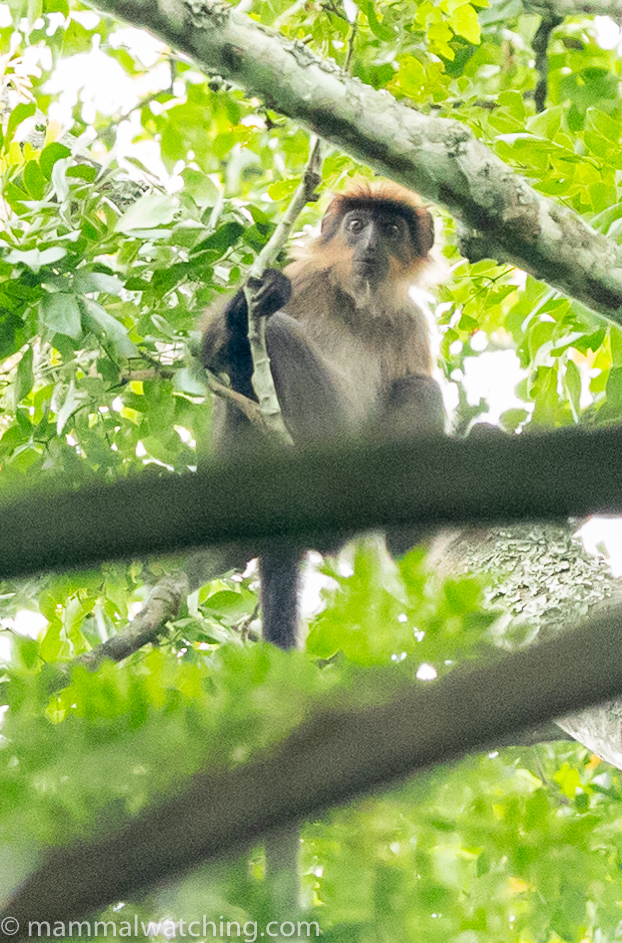
Semliki Red Colobus, Piliocolobus semlikiensis
We were back at our car by 3 p.m, adding Isabelline Red-legged Sun Squirrel to the day’s mammal list on the way back.
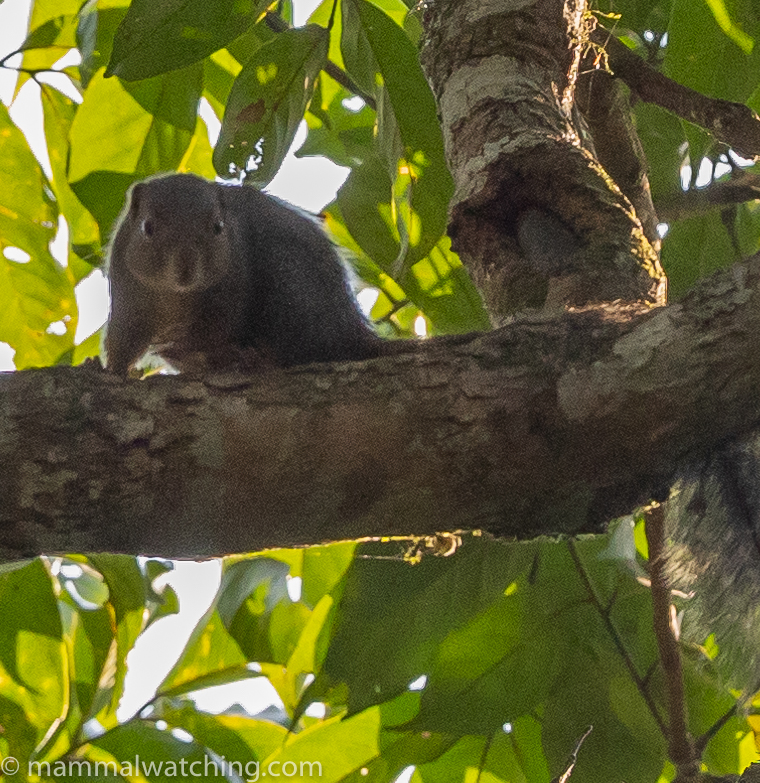
Isabelline Red-legged Sun Squirrel, Heliosciurus rufobrachium
Back at the car even Katy agreed – grudgingly of course – that it had been a good day.
Kibale National Park
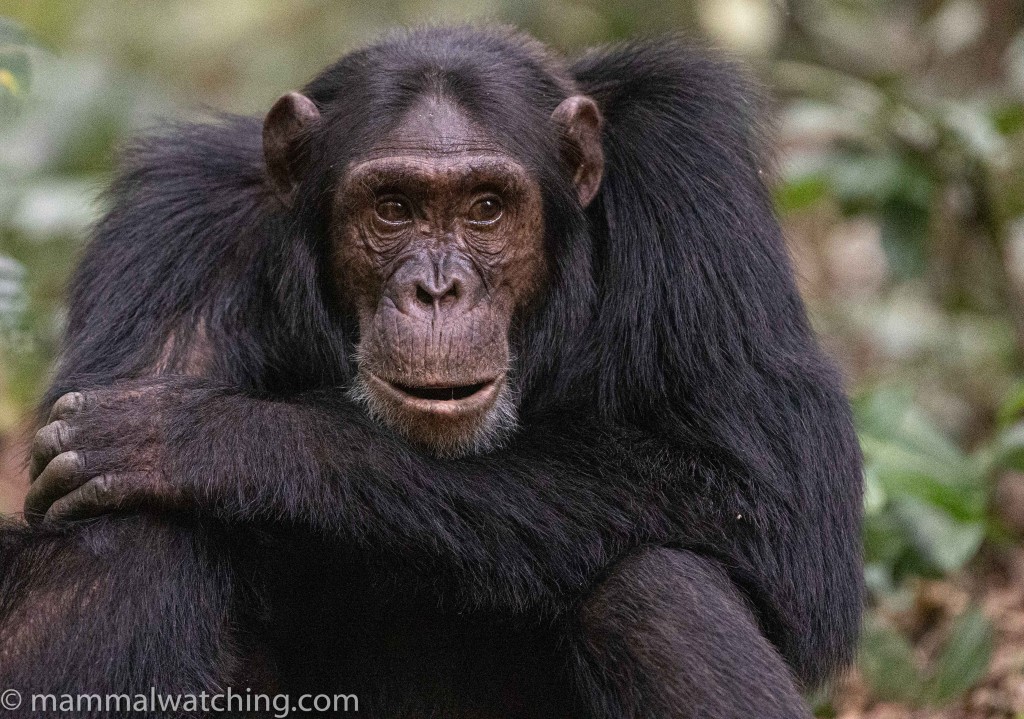
Chimpanzee, Pan troglodytes
We spent two nights at Kibale, staying in Harriet’s comfortable Kibale Forest Lodge close to the national park.
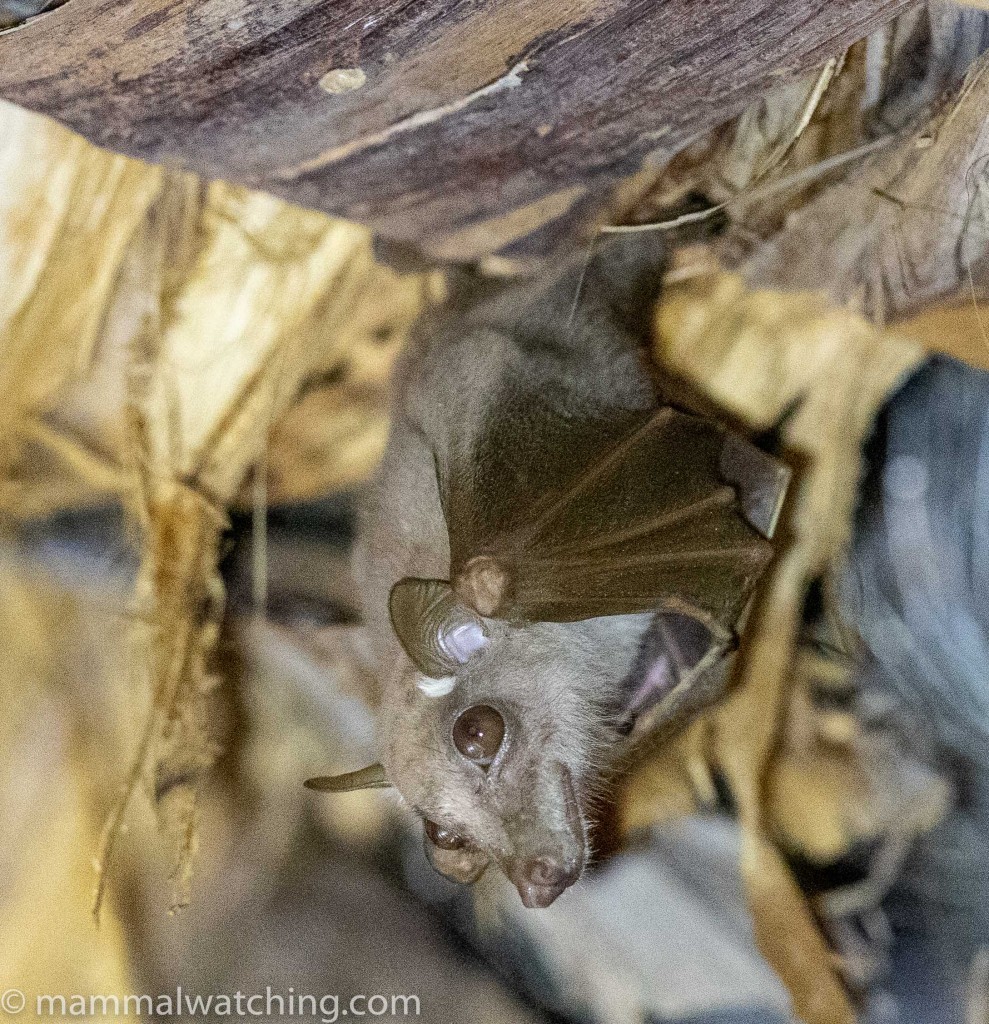
Ethiopian Epauletted Fruit Bat, Epomophorus labiatus
I caught one of the fruit bats roosting in the lodge’s dining room and checked its palate to claim my first (confirmed) Ethiopian Epauletted Fruit Bat.
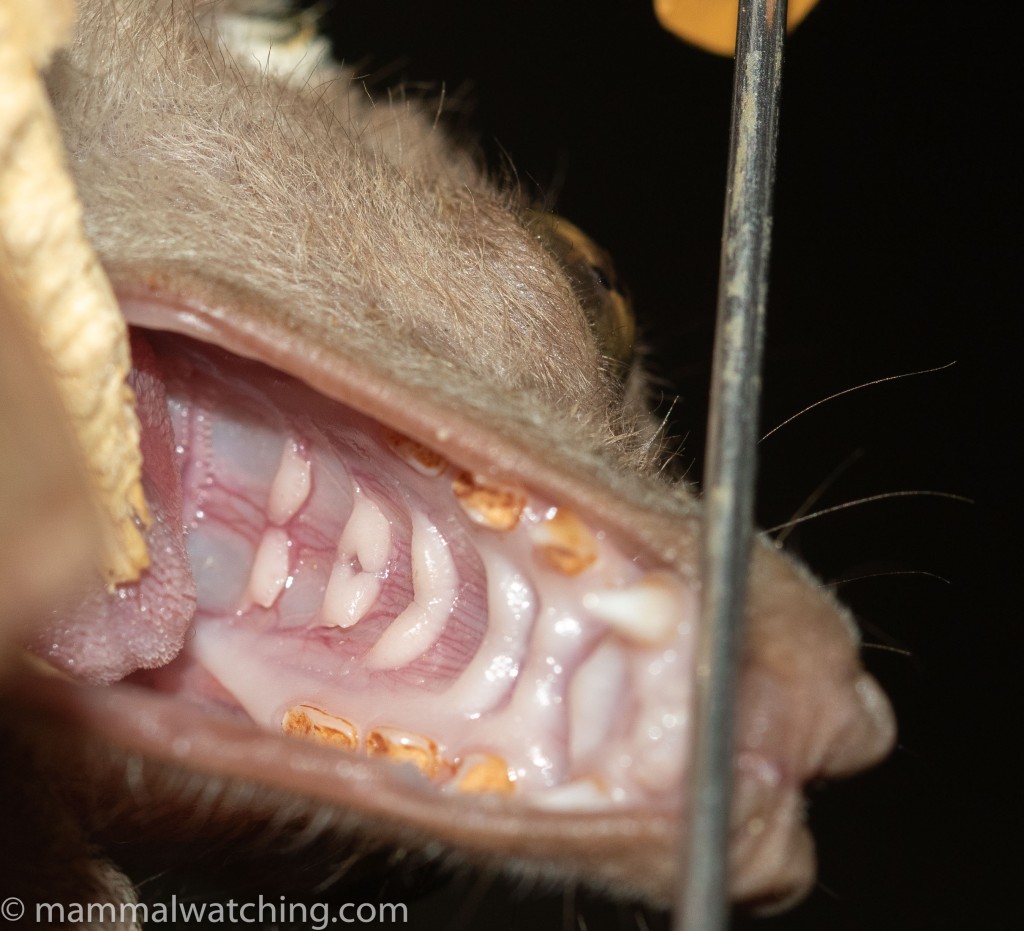
Ethiopian Epauletted Fruit Bat, Epomophorus labiatus
You need to count the number of ridges in the roof of the mouth behind the molars to identify these bats to species level.
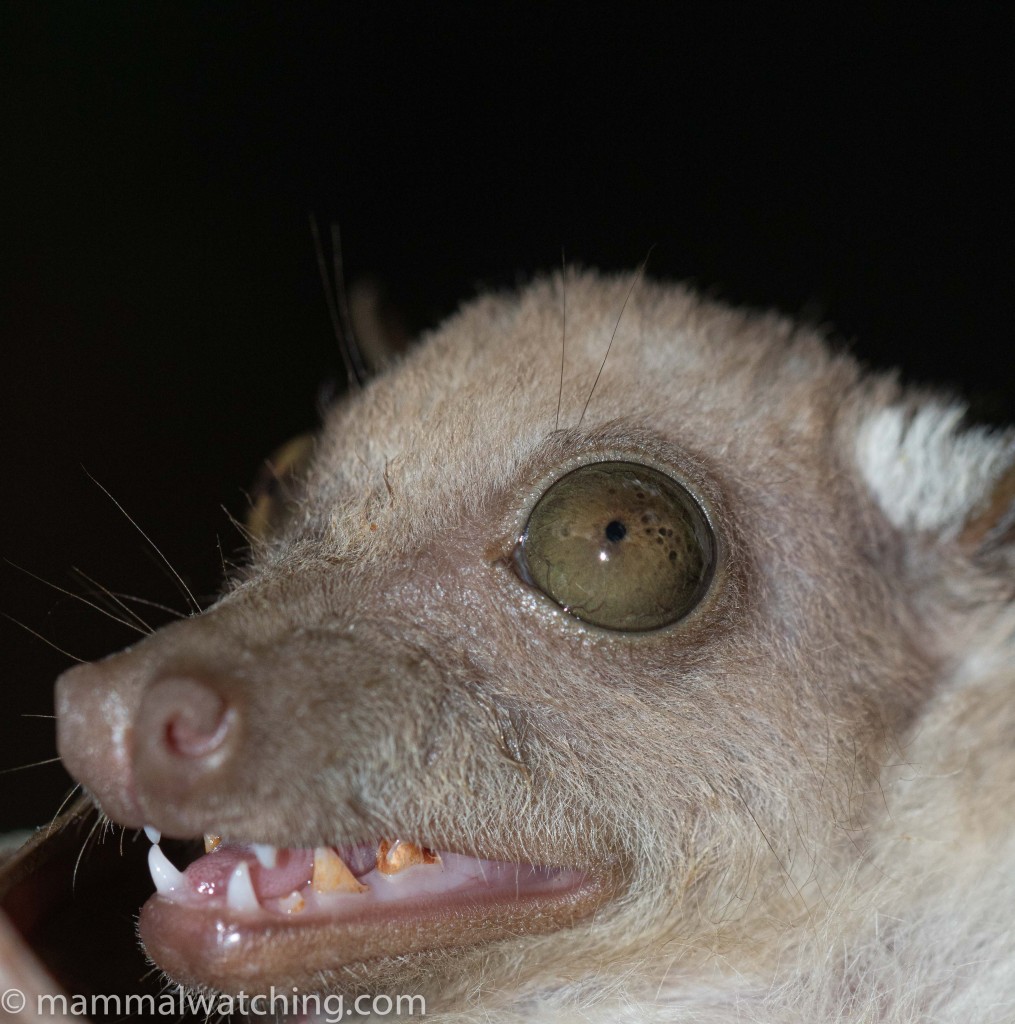
Ethiopian Epauletted Fruit Bat, Epomophorus labiatus
Harriet grew up in a village here and knows the area well. With the help of her friend Edison we found some Goliath Beetles in the forest, much to Patrick’s delight. The largest flying insect in the world and his most wanted bug.
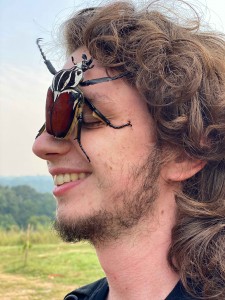
Patrick bonds with his most wanted bug
At night we looked for Golden Cats, duikers, cusimanse and whatever else we could find.
Golden Cats are seen very very occasionally and not by us.
Weyn’s Duikers are not uncommon. I saw a couple of probable duikers in my thermal scope but not in a flash light. The one “duiker” I excitedly did photograph turned out to be a bushbuck.
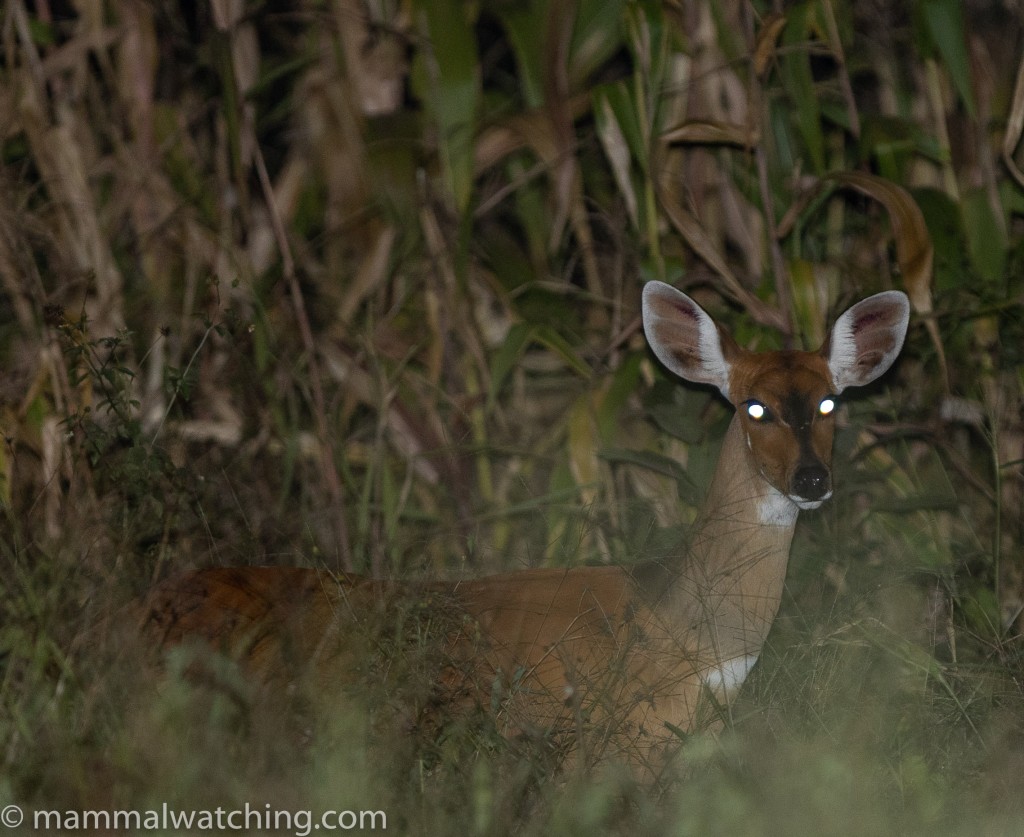
Cape Bushbuck, Tragelaphus sylvaticus
Harriet has seen cusimanse several times at night in fields near Edison’s village. We didn’t have any luck, but we did have fun in the village capturing a large rat by hand at midnight. It turned out to be a House Rat.
A walk around Bigodi Swamp was productive for primates.
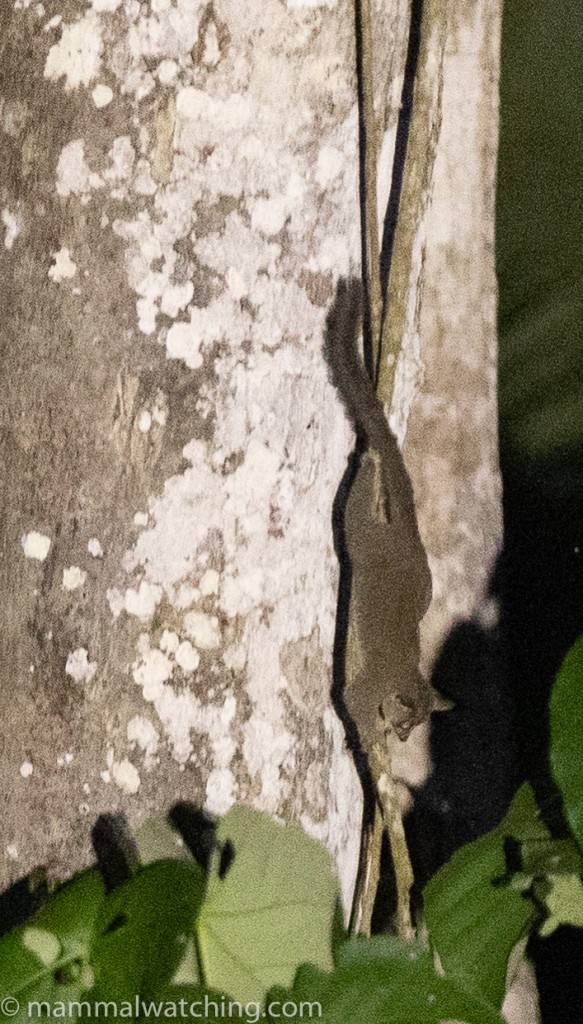
Thomas’s Dwarf Galago, Galagoides thomasi
We saw several Thomas’s Galagos and Eastern Pottos, along with many sleeping diurnal monkeys.
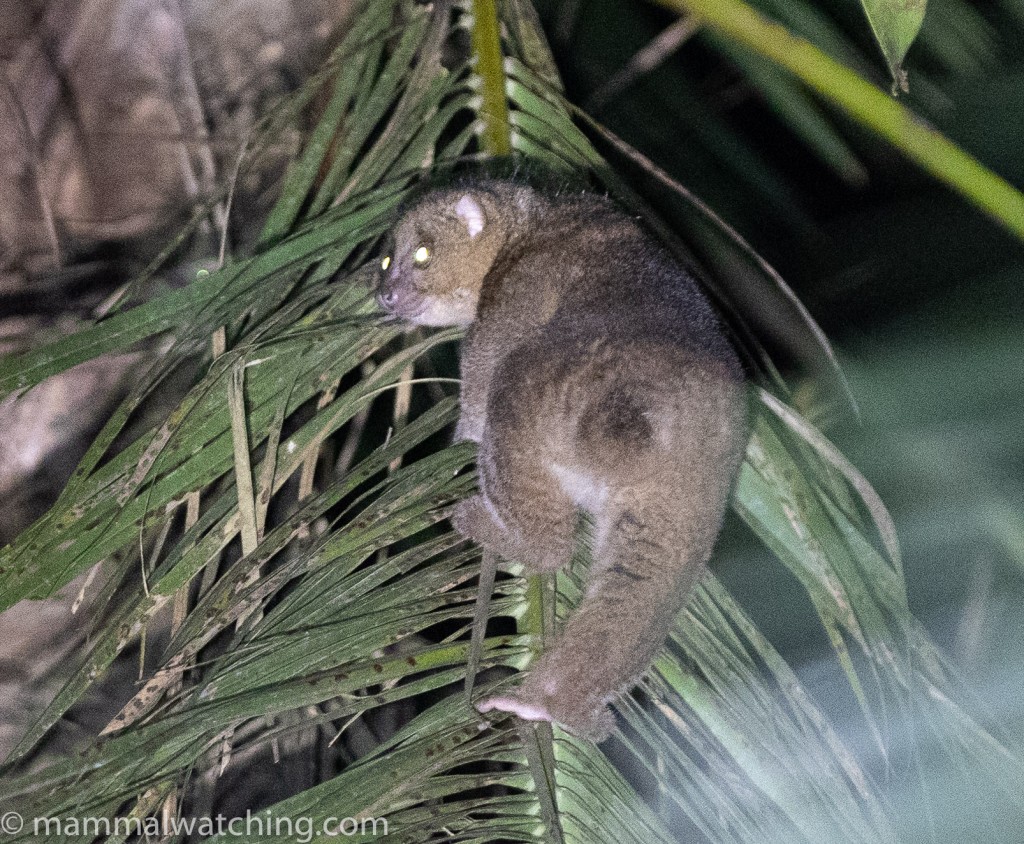
East African Potto, Perodicticus ibeanus
In the early morning, the trails around the edge of the swamp are a great area to look for primates.
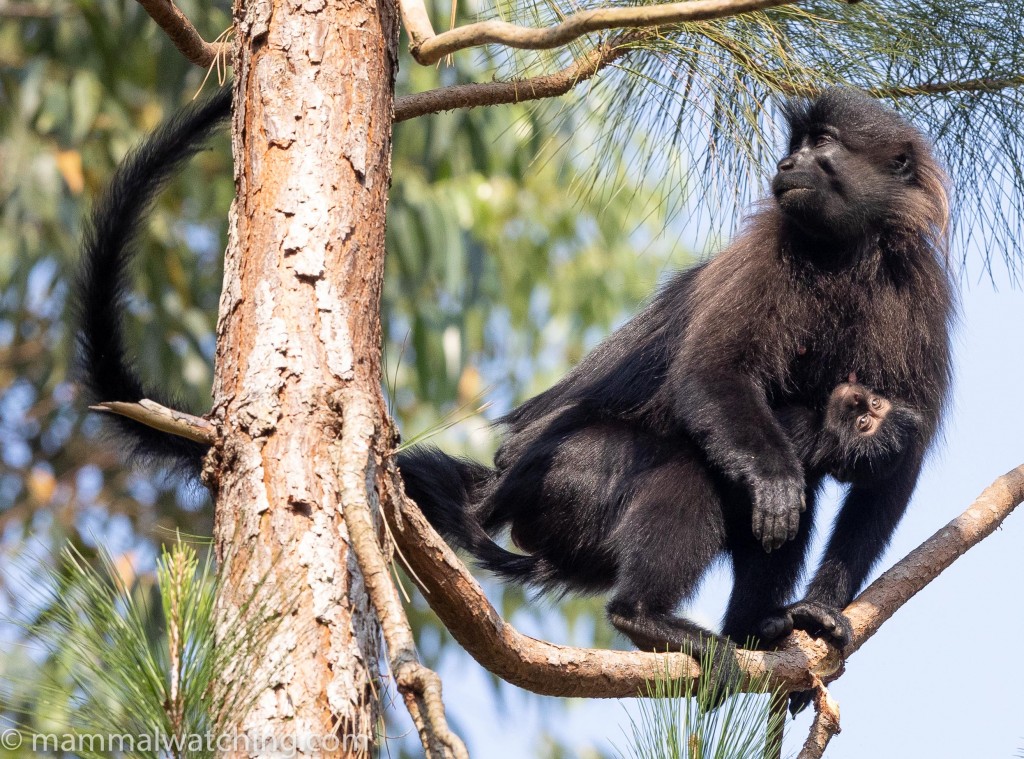
Grey-cheeked Mangabey, Lophocebus albigena
Grey-cheeked Mangabeys and Red-tailed Monkeys were easy to see, and in much better light than we had had at Semuliki.
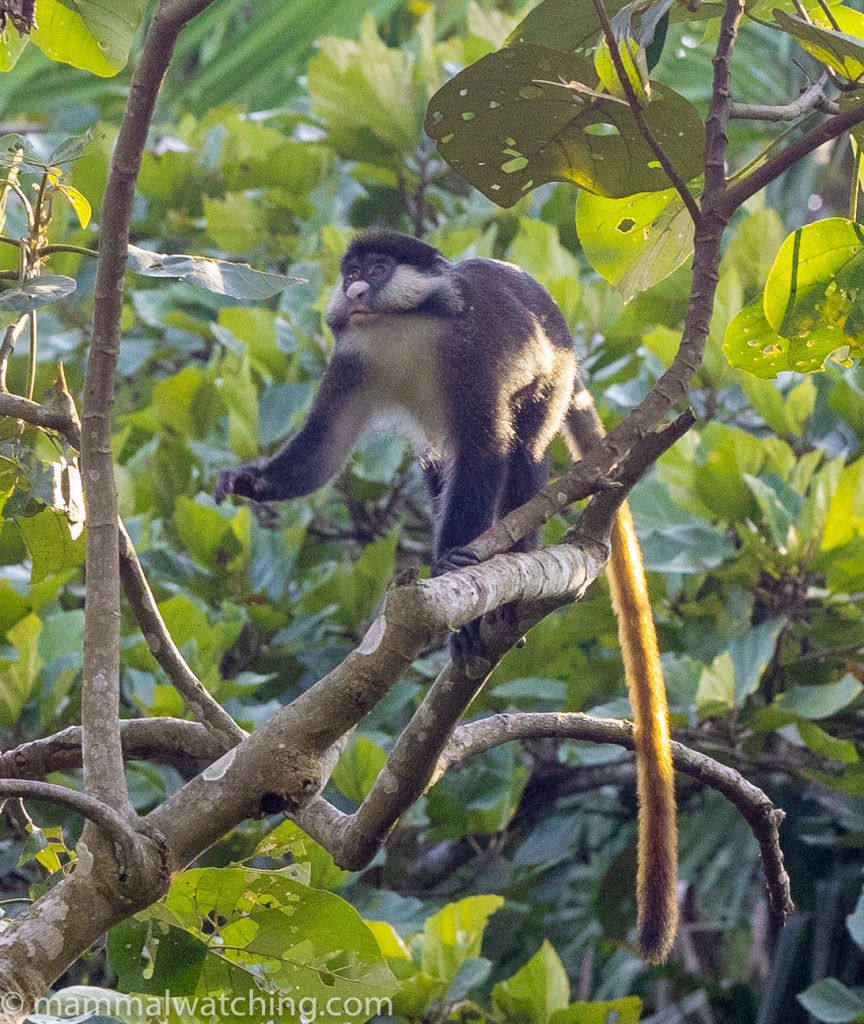
Red-tailed Monkey, Cercopithecus ascanius
We also saw L’Hoest Monkeys and Olive Baboons.
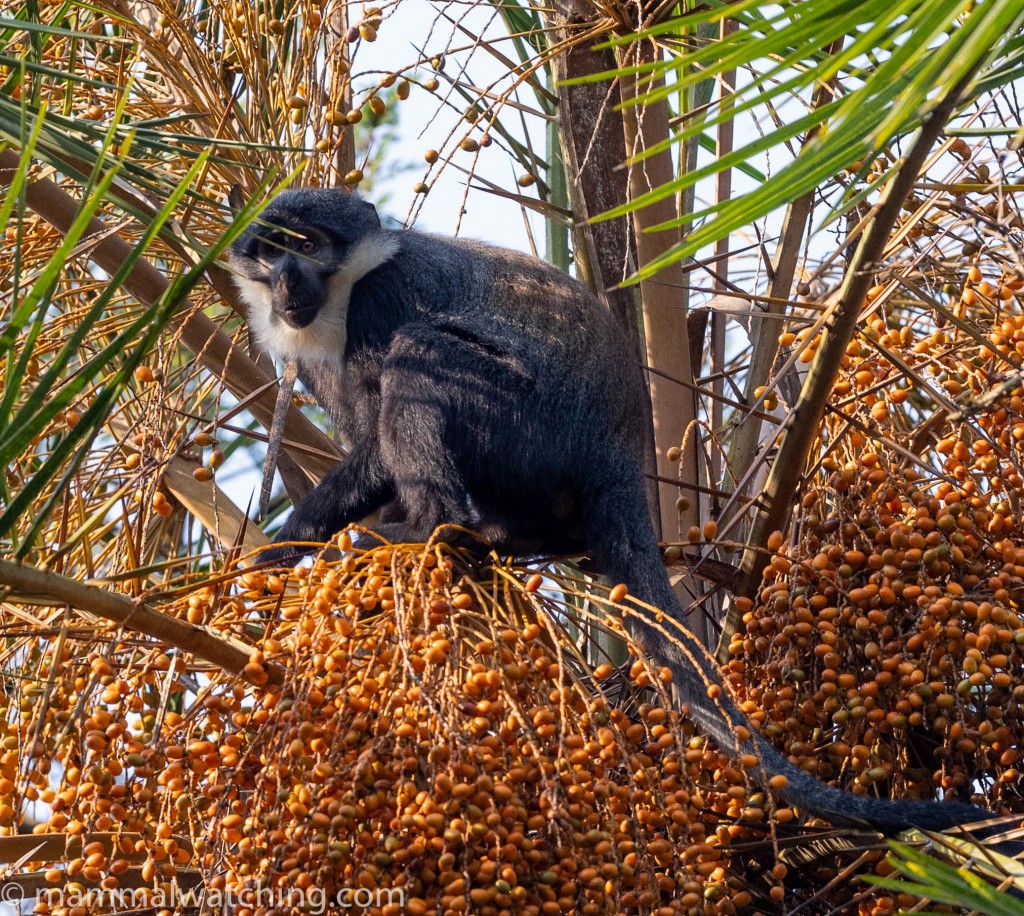
L’hoest’s Monkey, Allochrocebus lhoesti
The Ashy Red Colobus were lifers.
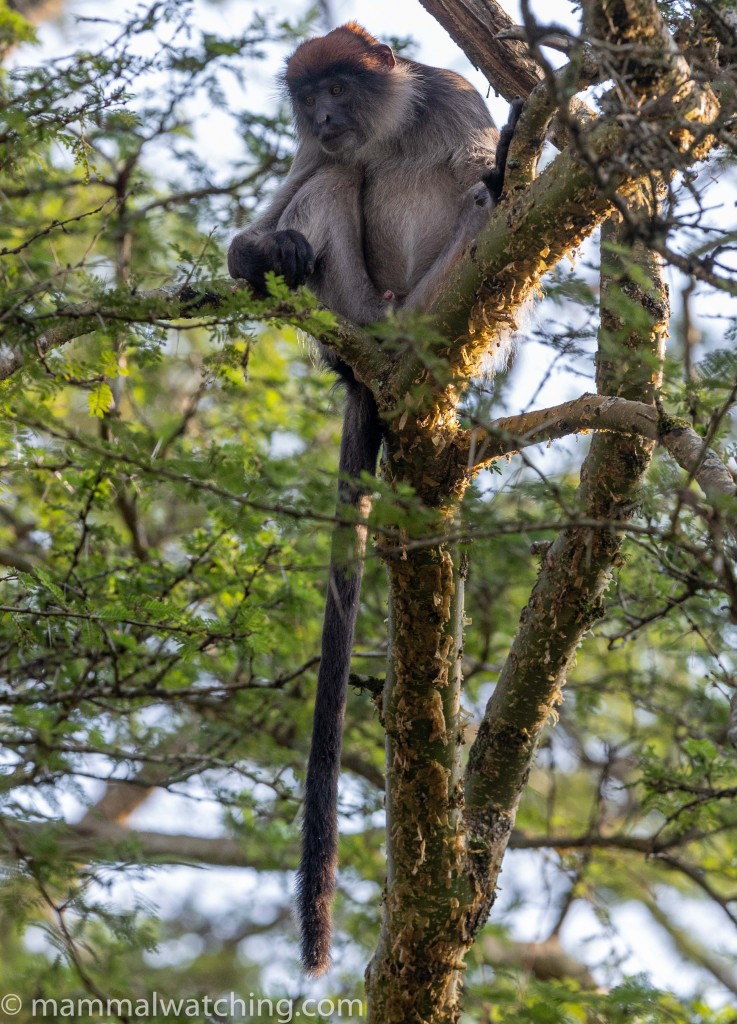
Ashy Red Colobus, Piliocolobus tephrosceles
We stopped in at the Kibale Primate Lodge to see the resident Angolan Fruit Bats, which have longer fur than the similar looking Egyptian Fruit Bat.
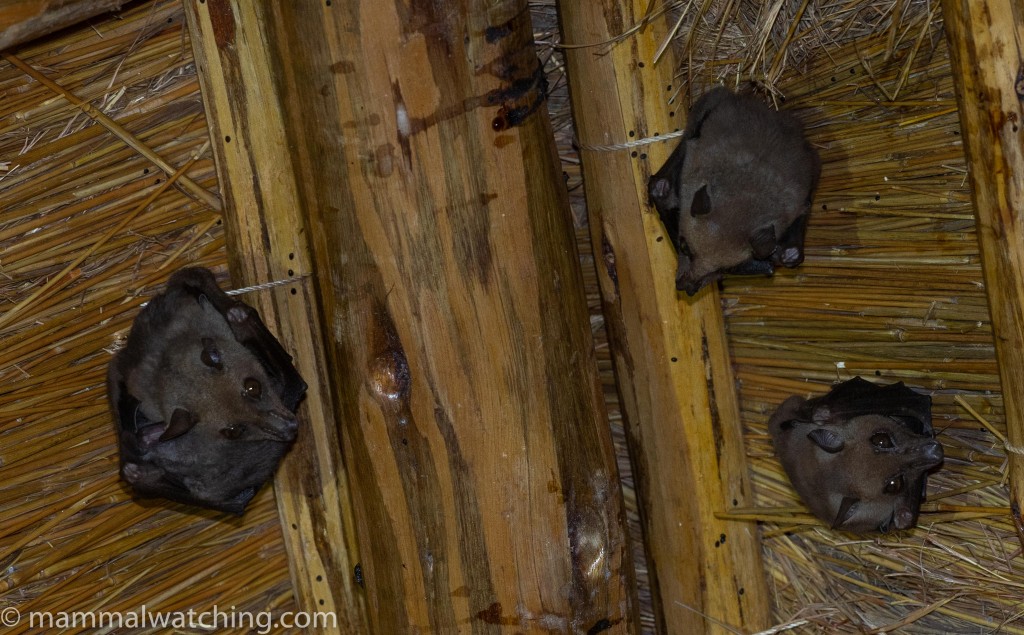
Angolan Fruit Bat, Myonycteris angolensis
Trapping around Harriet’s lodge caught a Giant Shrew. I caught it two metres up a metal ladder under a water tank in her garden. Clearly they climb surprisingly well.
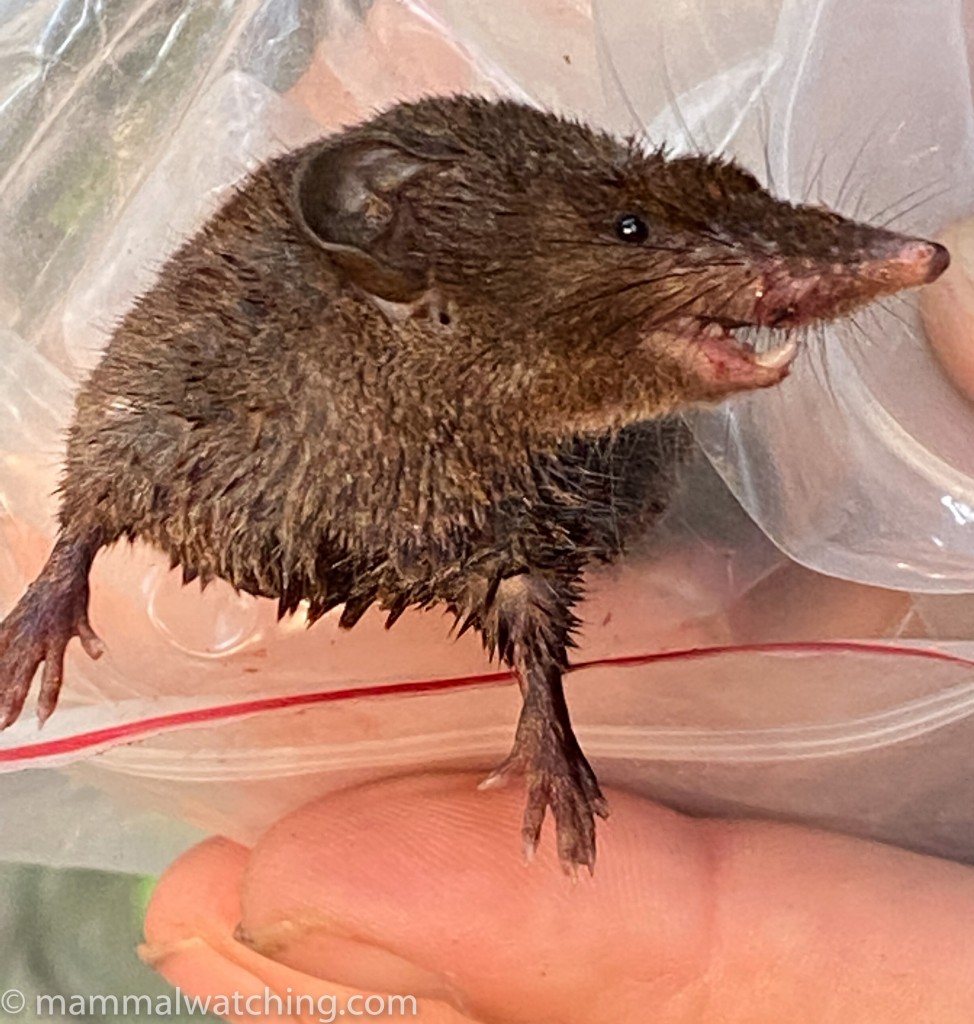
African Giant Shrew, Crocidura olivieri
We also set traps in the fields around Edison’s village. I had seen an interesting reddish rat in the day time here but we caught only an African Grass Rat, a Black Rat and another Giant Shrew.
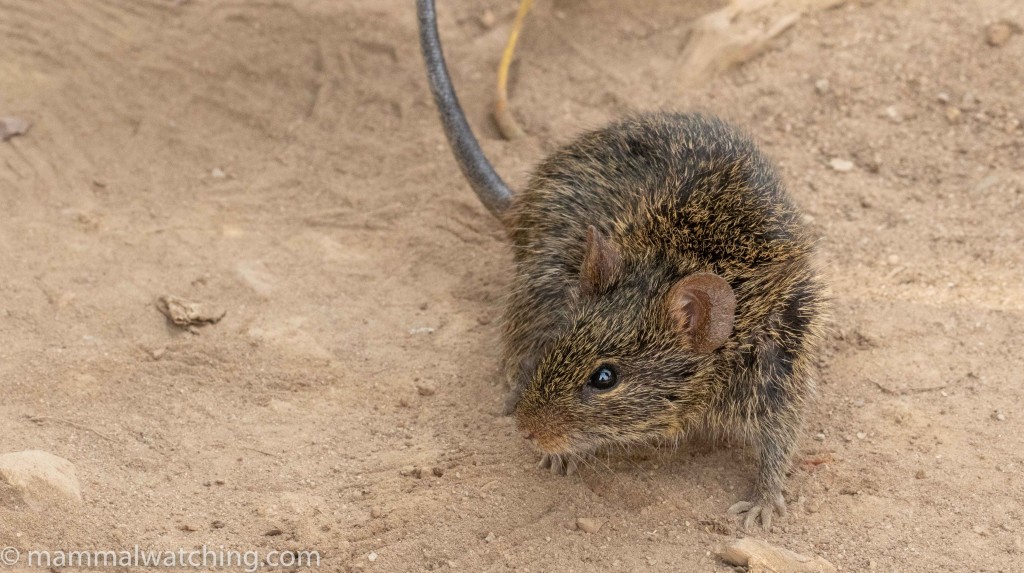
African Grass Rat, Arvicanthis niloticus
One of Kibale’s biggest draws is the chance to spend time with an habituated troop of chimps. Despite COVID-19, tourist numbers was picking up again and Harriet recommended we visit in the afternoon when there are usually fewer people around. This was good advice: we were the only visitors there.
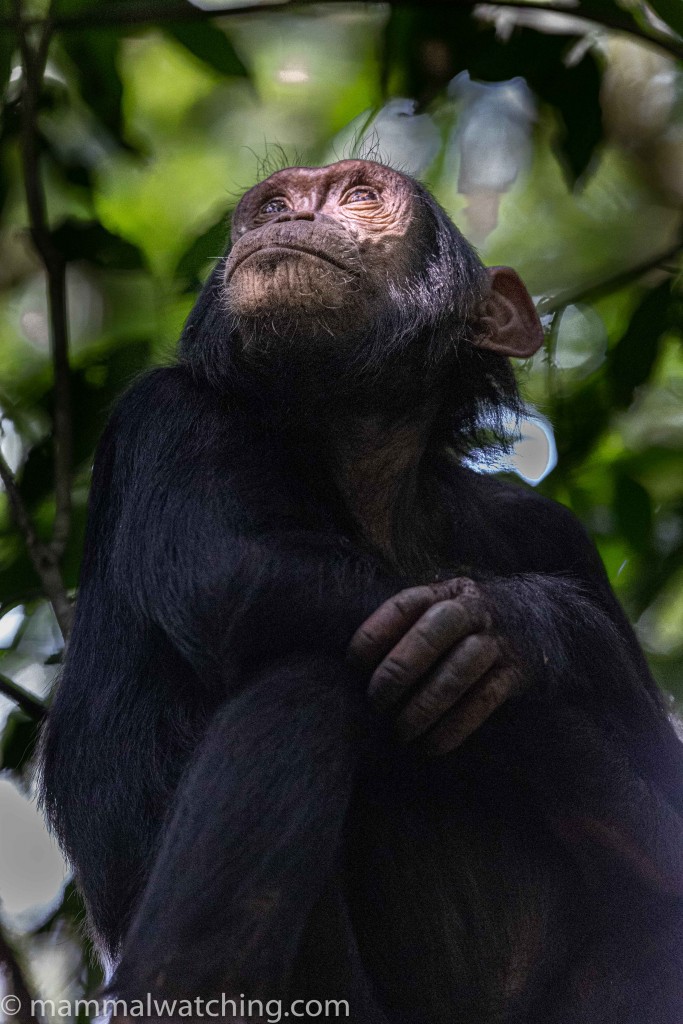
Chimpanzee, Pan troglodytes
It took an hour to reach the chimps which were moving quickly while we were trying to intercept them. The next hour – with the apes – was one of my favourite wildlife experiences ever.
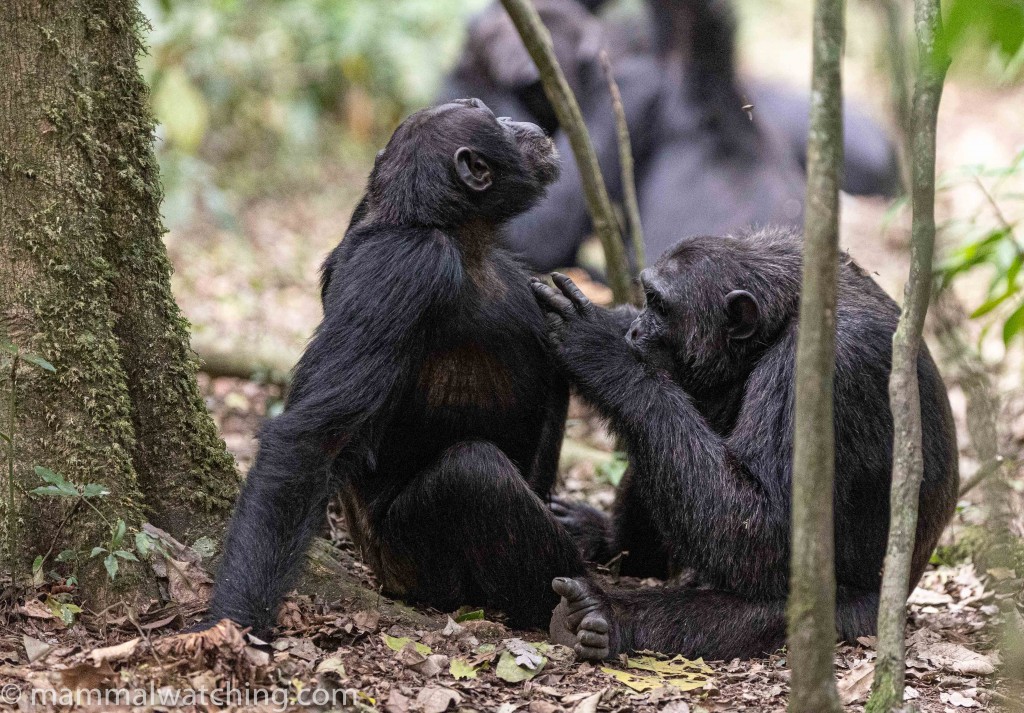
Chimpanzees, Pan troglodytes
We were in the middle of a troop of 20 or so chimps and witnessed a wide range of behaviour including mating, fighting, playing and grooming.
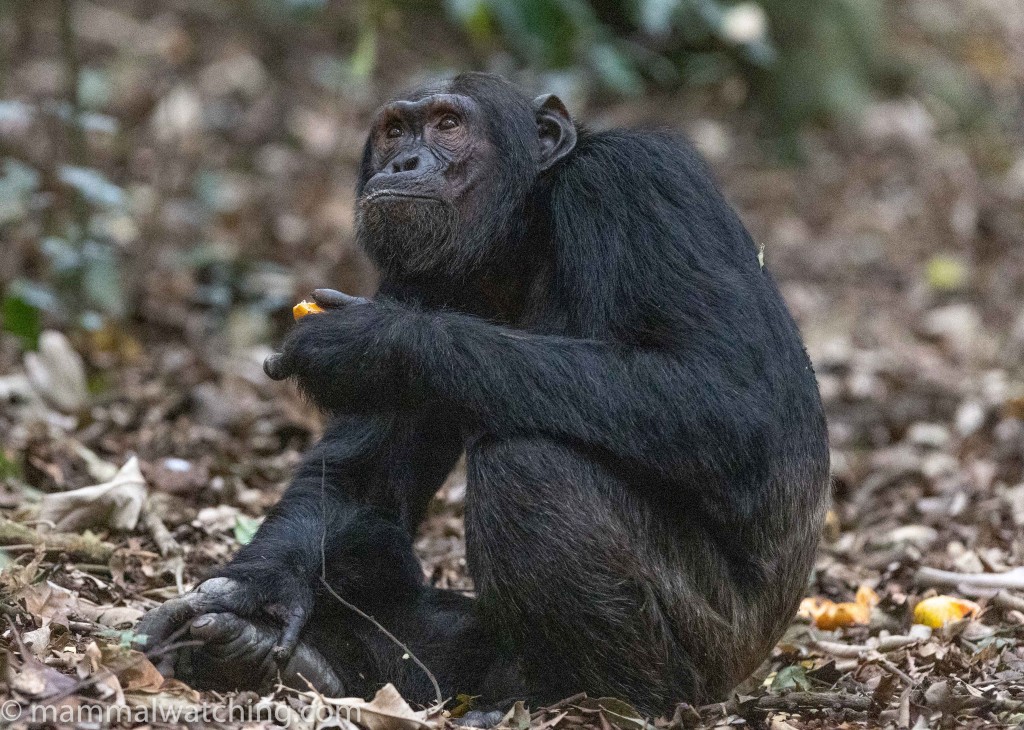
Chimpanzee, Pan troglodytes
Our guide was excellent, explaining the personality of each animal as well as the Machiavellian tactics male chimps use to ascend to Alpha-dom. Patrick was disappointed to learn that chimps could be as unpleasant to each other as humans are. Me too.
After we said goodbye to the chimps a Weyn’s Duiker – this time a real one, not a bushbuck – dashed across the trail in front of us.
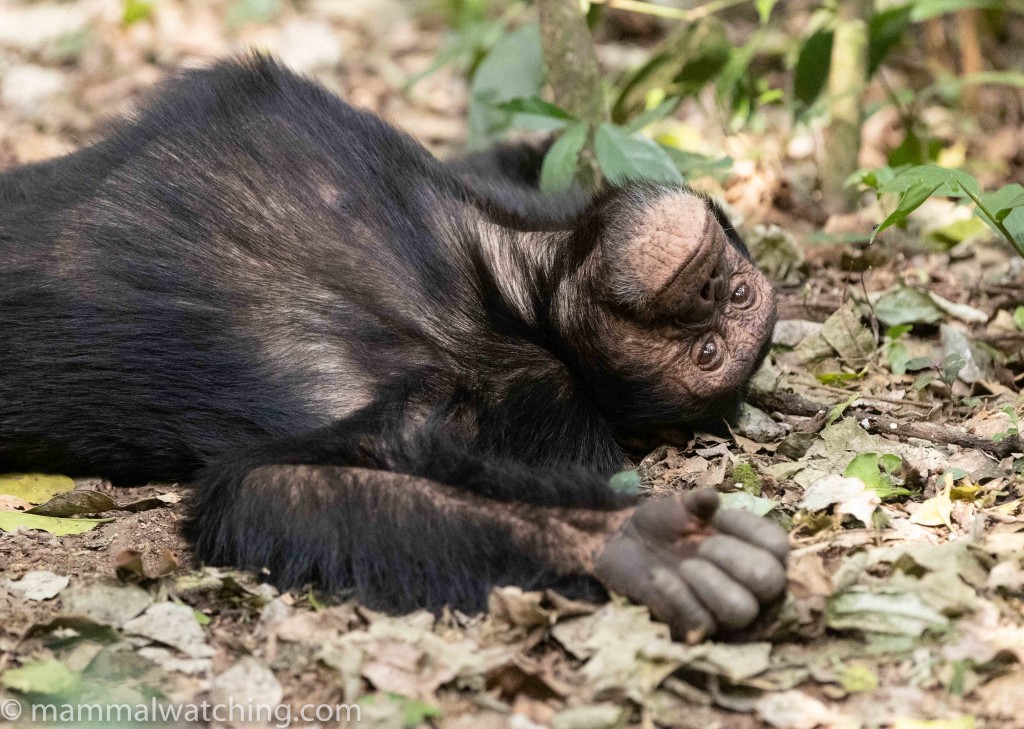
Chimpanzee, Pan troglodytes
In between all the mammals I found time to visit a local hair salon for a shave. After 3 weeks of beard growth my disposable razors were not going to cut it.
This was entertaining for the salon’s clientele and – as word spread – most of the village. Judging by the number of people who walked into the shop to stare at me I am pretty sure I was the first muzungu to have visited in a while.
I only wanted a shave but I somehow ended up staying for an hour, also getting a face mask (which I mistakenly accepted thinking the goop in the barber’s hand was aftershave), followed by various other beautification that included having a raw egg smeared on my face.
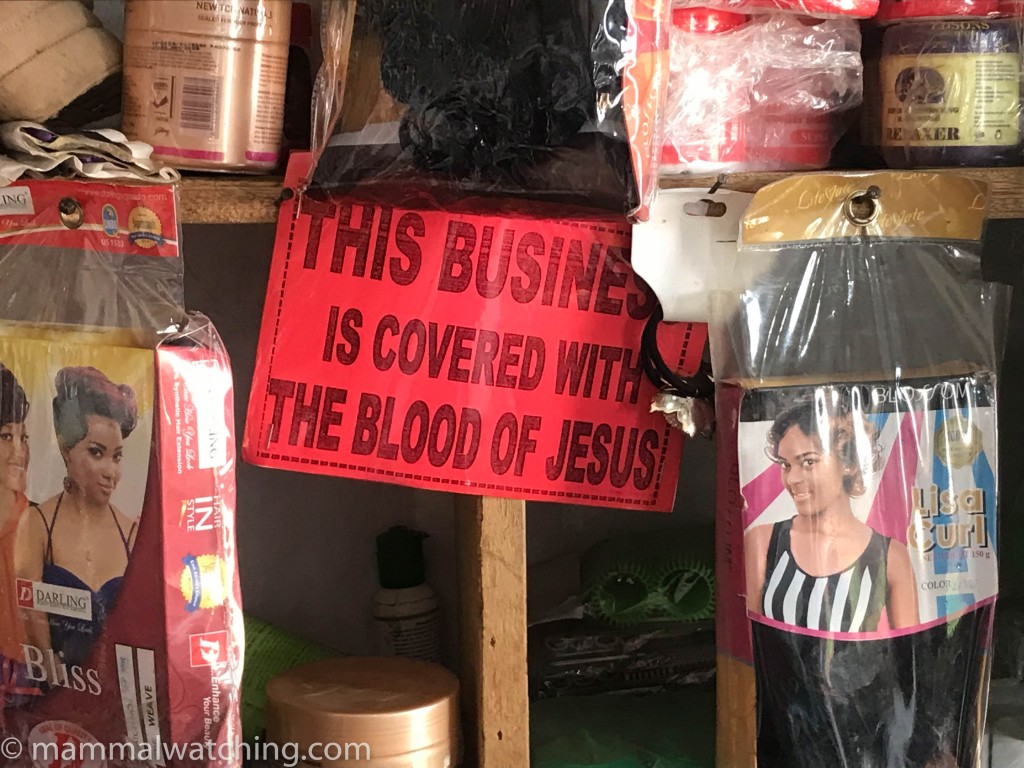
Kibale Hair Salon. Enter at your own risk
The shop – without apparent irony – were displaying what might well be the worst advert ever for any business that makes it living from scissors and sharp blades. I am not sure how long the store had been there but if Jesus had, as they claimed, stopped in, it explains why he grew a beard and stopped cutting his hair.
Bwindi Impenetrable Forest
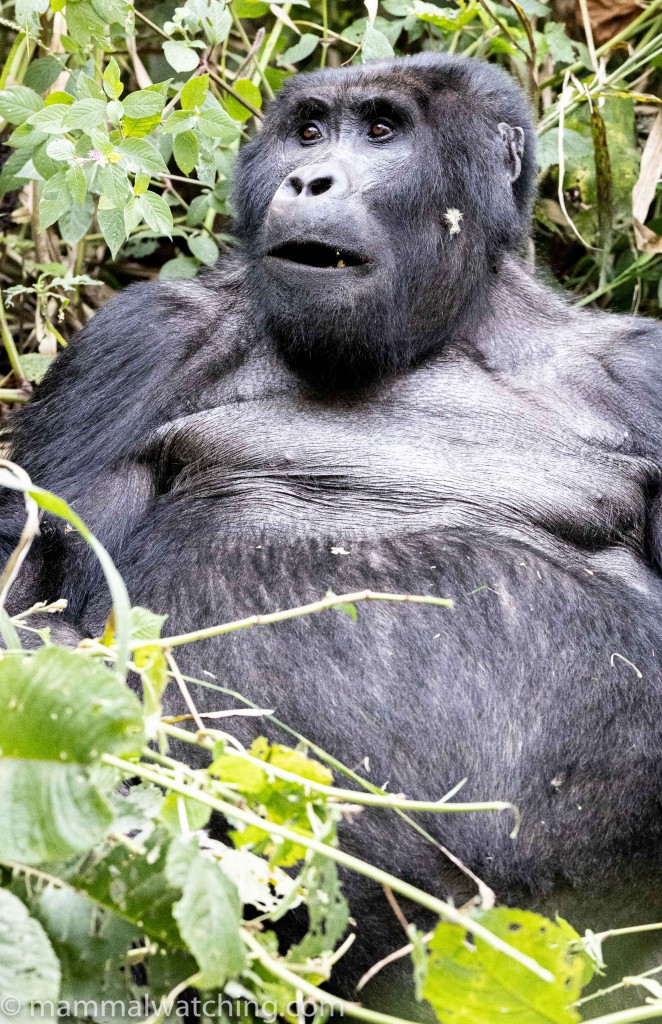
Eastern Gorilla, Gorilla beringei
Bwindi Impenetrable Forest is a beautiful, mega-diverse, mountainous slab of rainforest: one study from 1998 recorded an astounding 65 shrew and rodent species in the park.
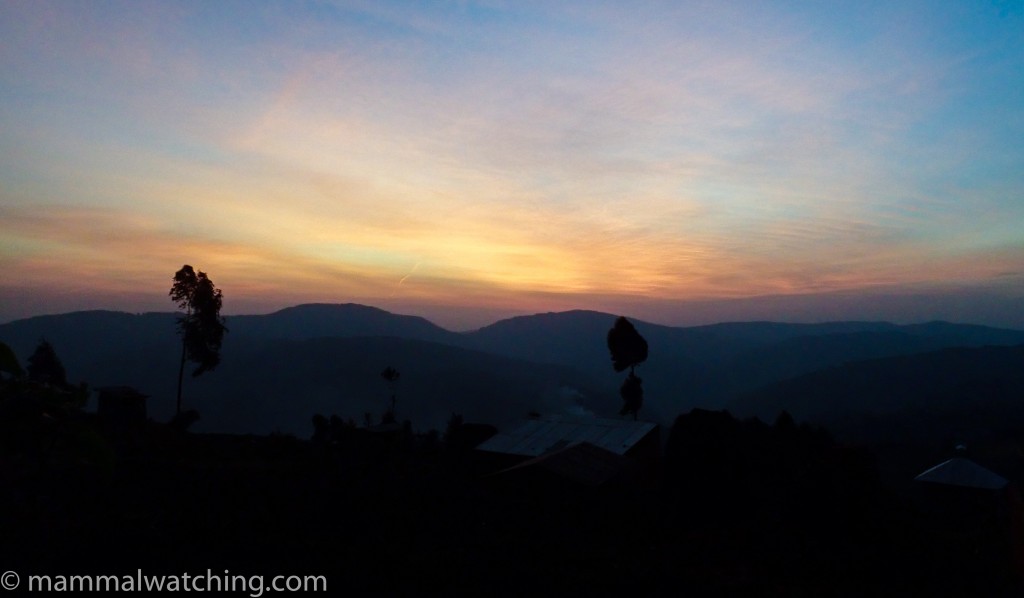
Ruhija sunrise
With more time I would have visited both the Buhoma and Ruhija sectors of the park, but we only had time for one area, and that – from a mammal perspective – had to be Ruhija. During two nights my targets were Ruwenzori Sun Squirrel, Ruwenzori Horseshoe Bat, Spectacled Galago and Black-fronted Duiker. I also promised the family we would go see the gorillas.
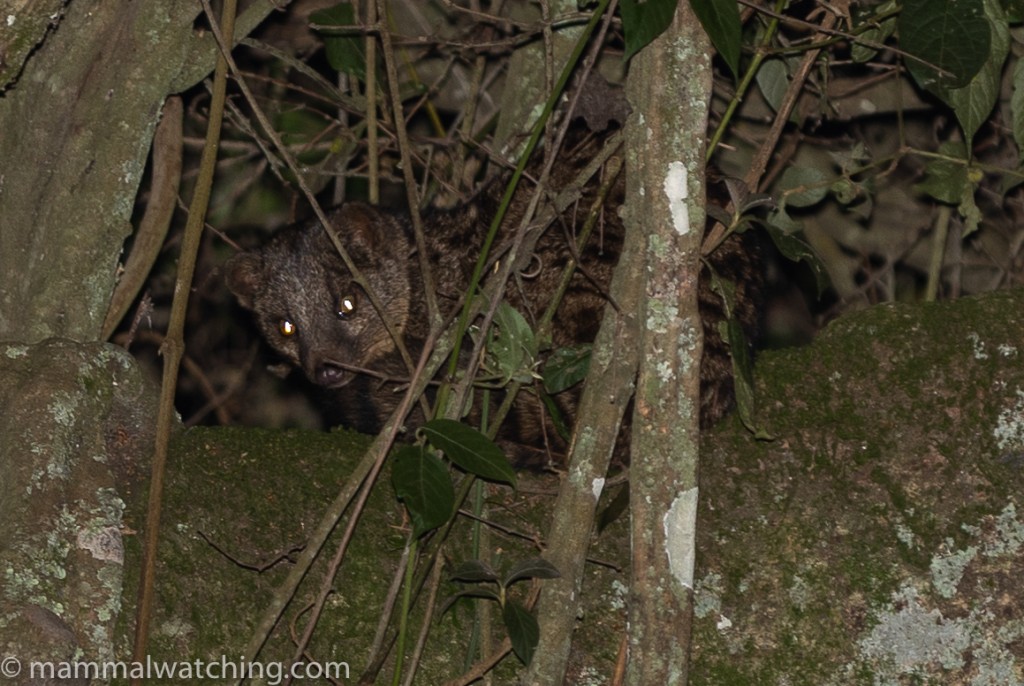
African Palm Civet, Nandinia binotata
We took two longish night drives and had no problems being allowed to travel through the park. Access may have been helped by Harriet’s good relations with the guards.
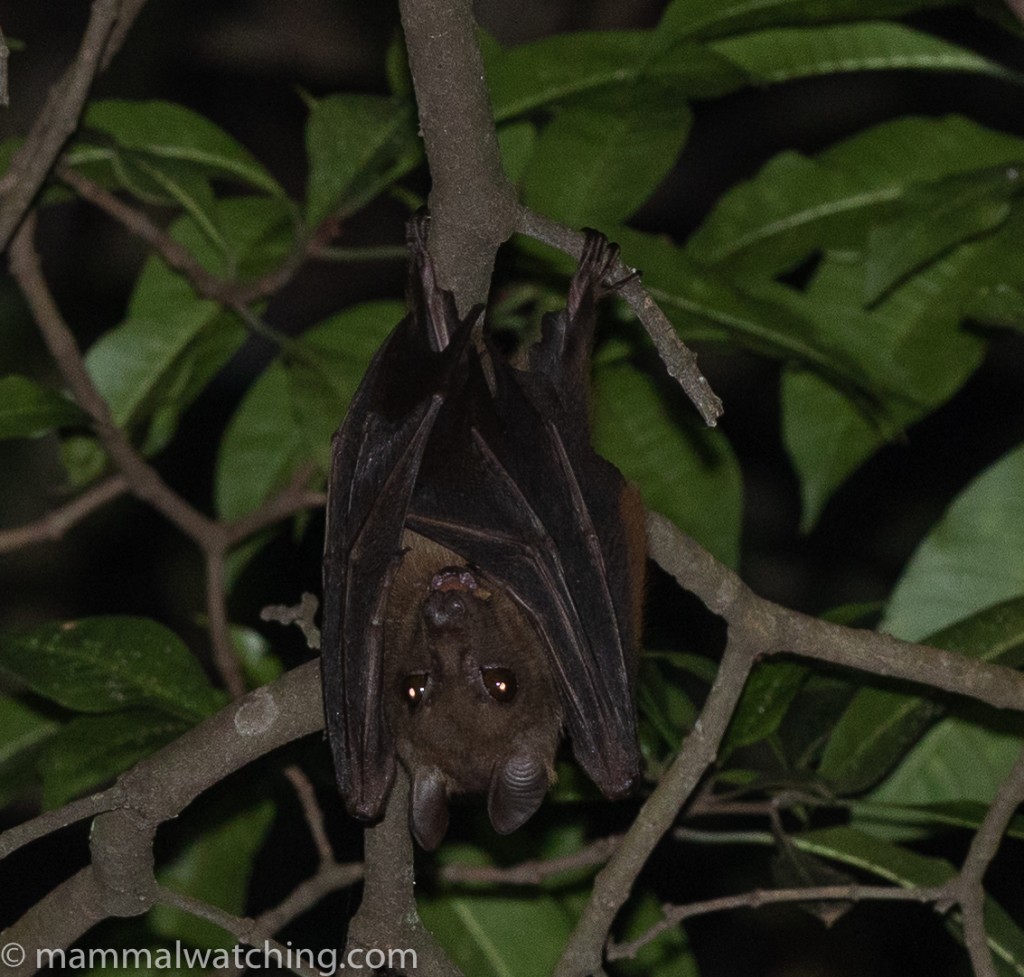
Angolan Fruit Bat, Myonycteris angolensis
There were plenty of mammals to see: mainly difficult to photograph Spectacled Galagos and a few fruit bats, some of which were Angolan Fruit Bats though others may have been Egyptian.
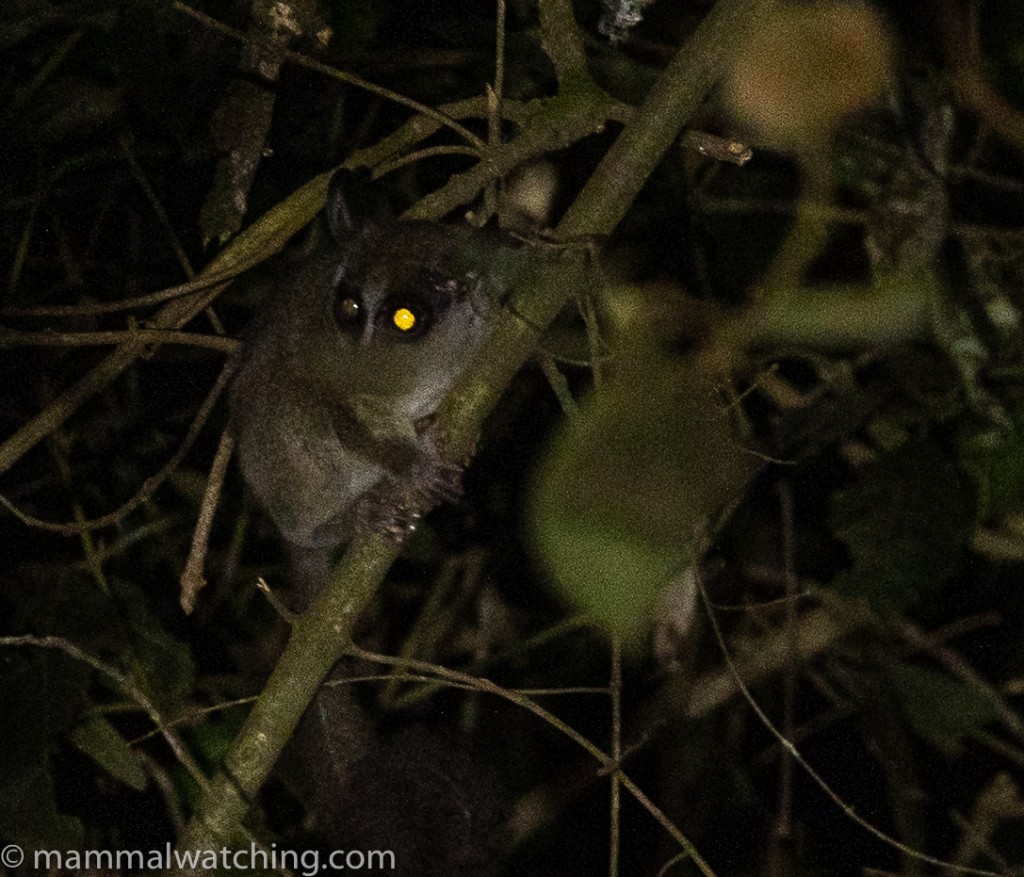
Spectacled Lesser Galago, Galago matschiei
We also had an African Palm Civet and some probable duikers that – as usual – I saw only in the thermal scope. No Golden Cats (of course), though they are here.
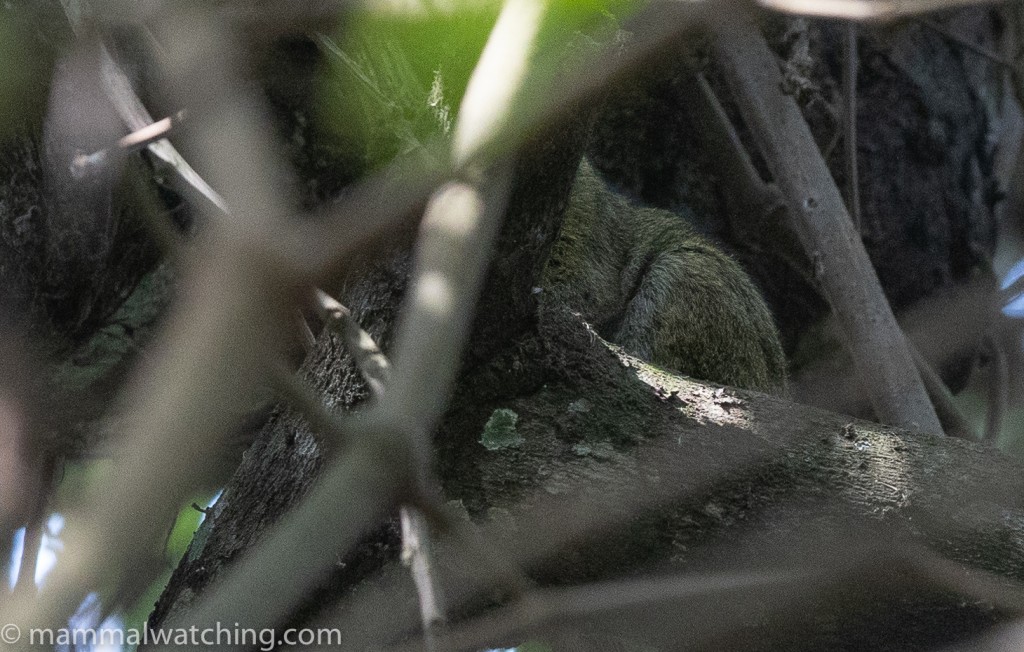
Carruther’s Mountain Squirrel, Funisciurus carruthersi
During the day Harriet helped track down Ruwenzori Sun Squirrels and Carruther’s Mountain Squirrels.
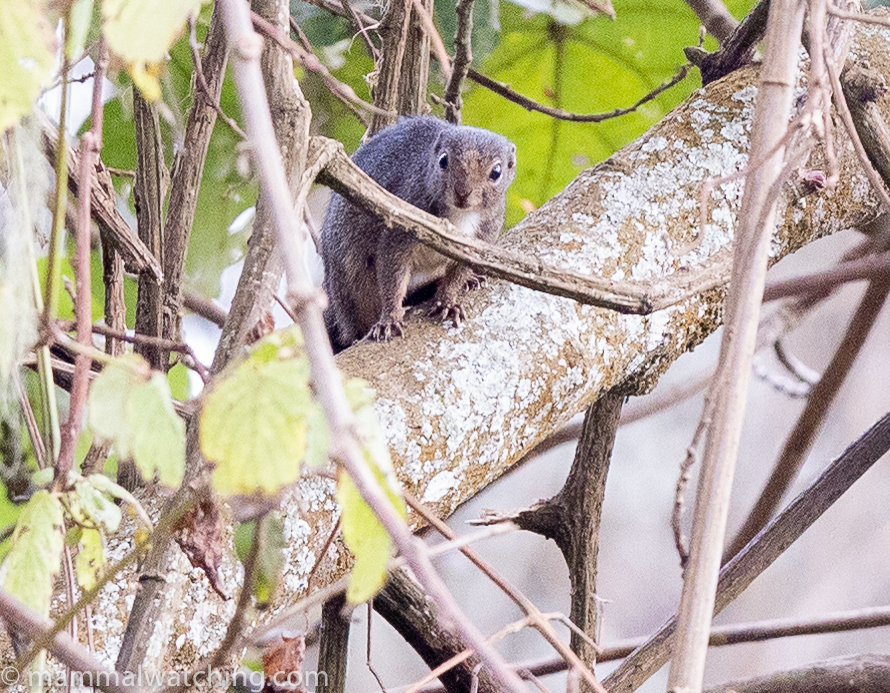
Ruwenzori Sun Squirrel, Heliosciurus ruwenzorii
We saw Blue and L’Hoests Monkeys plus Guereza Colobus along the road too.
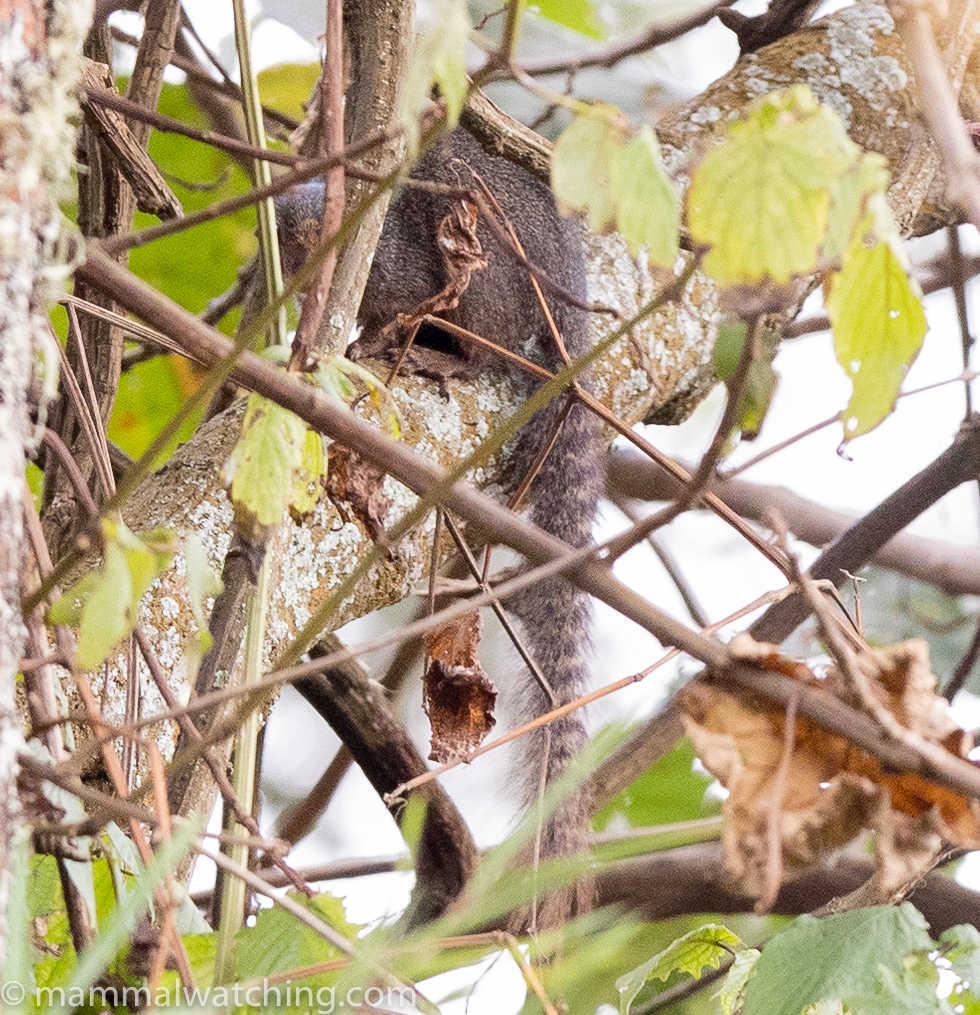
Ruwenzori Sun Squirrel, Heliosciurus ruwenzorii
But despite several hours driving we did not see any duikers. According to Harriet, Black-fronted Duikers are not not all that hard to find as they often graze on the edge of the road (perhaps in search of minerals).
Harriet explained that taking a strategic pee along the roadside can be a useful method of conjuring up a duiker 30 minutes later. But it didn’t work for me, despite several strategic pees. One of the rangers suggested that the long dry spell in the park meant the duikers were no longer coming to the roadside to graze or eat minerals (or lick pee).
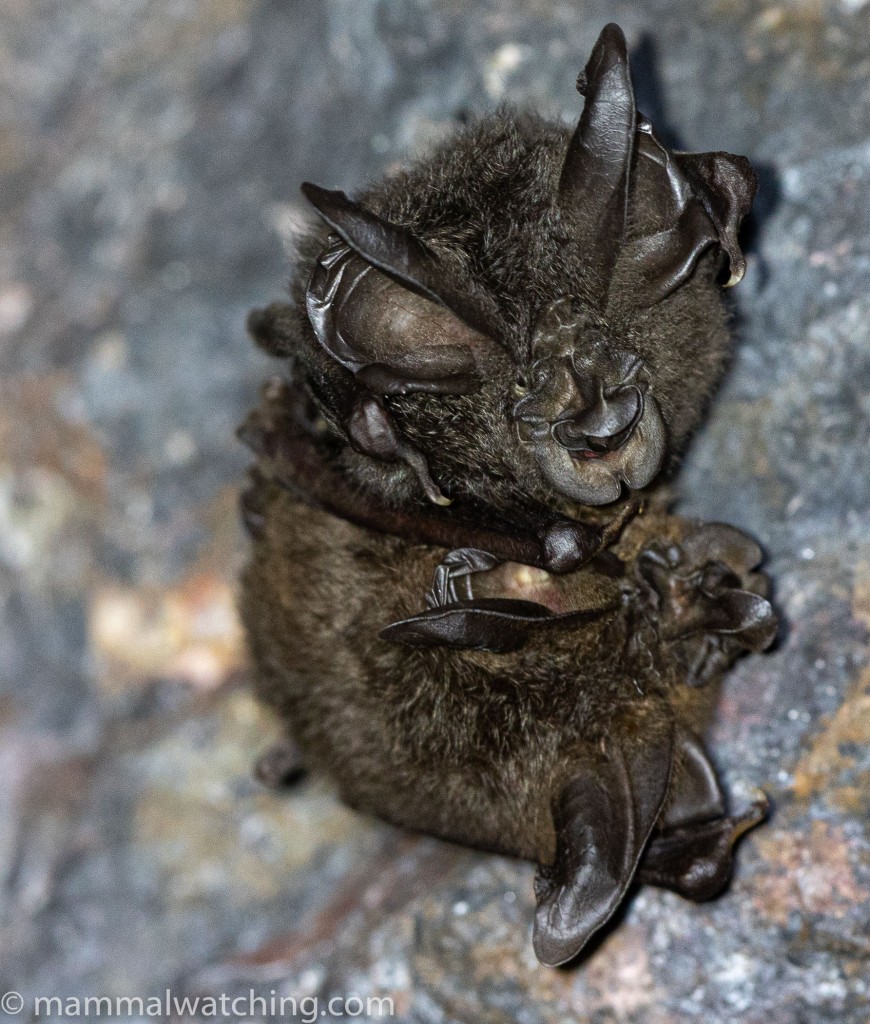
Ruwenzori Horseshoe Bat, Rhinolophus ruwenzorii
The horseshoe bat roost that both Alex and Carlos had seen, in a small roadside cave, was empty. But we visited some abandoned mines in the village where there were a few Ruwenzori Horseshoes, a little known species.
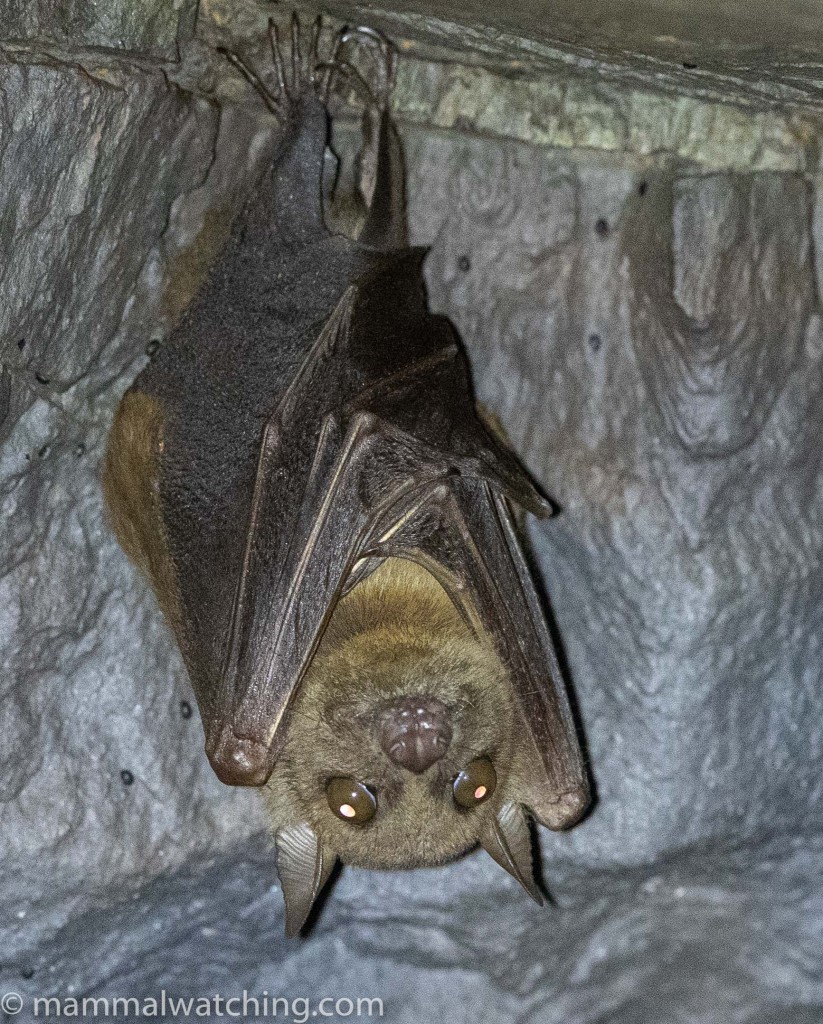
Angolan Fruit Bat, Myonycteris angolensis
There were also Angolan Fruit Bats in the mines, as well as a second species of horseshoe bat.
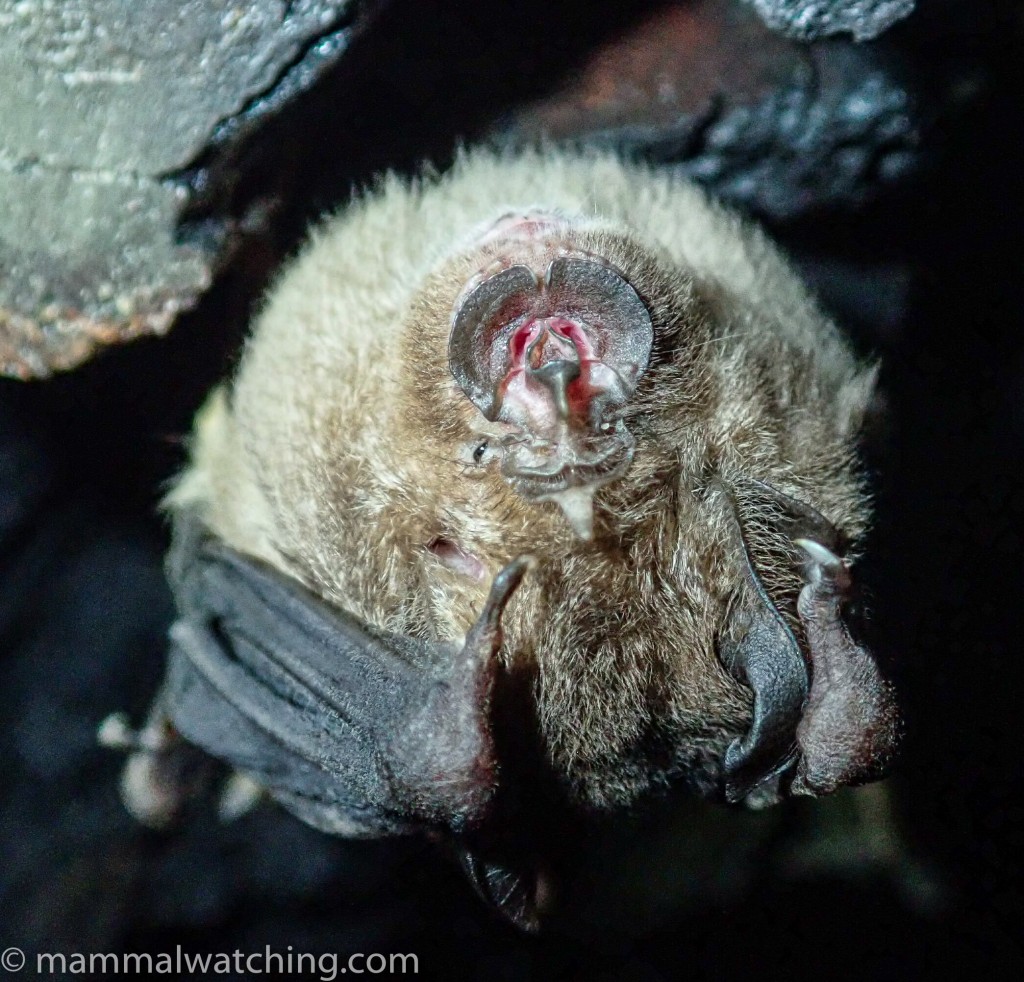
Arabian Horseshoe Bat, Rhinolophus clivosus
This species had a forearm of around 54mm: I think they are Arabian Horseshoe Bats.
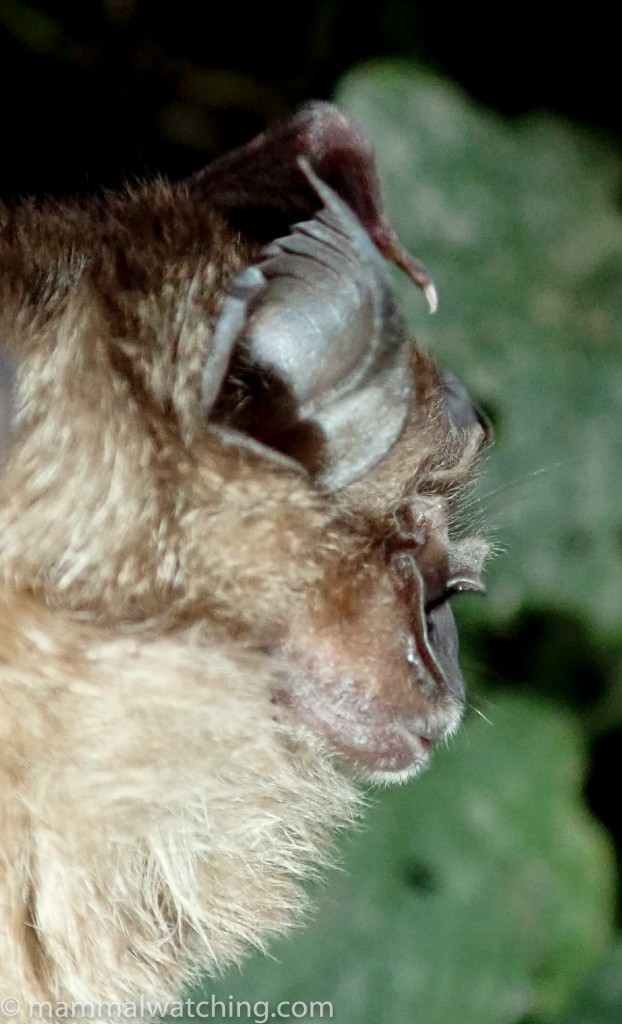
Arabian Horseshoe Bat, Rhinolophus clivosus
The gorilla trek was easier than I had expected. To save time for more duiker searching we asked to visit the Oruzogo group as they were closest to the road that day. We reached them within 40 minutes.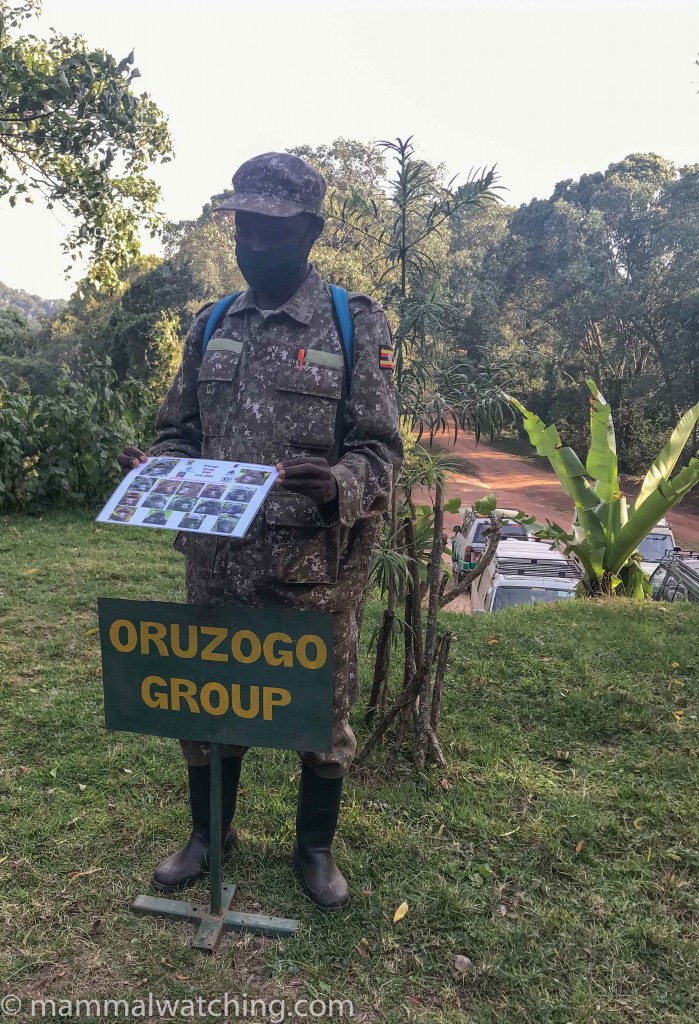
A short trek, but a steep and slippery one, made easier by a friendly porter.
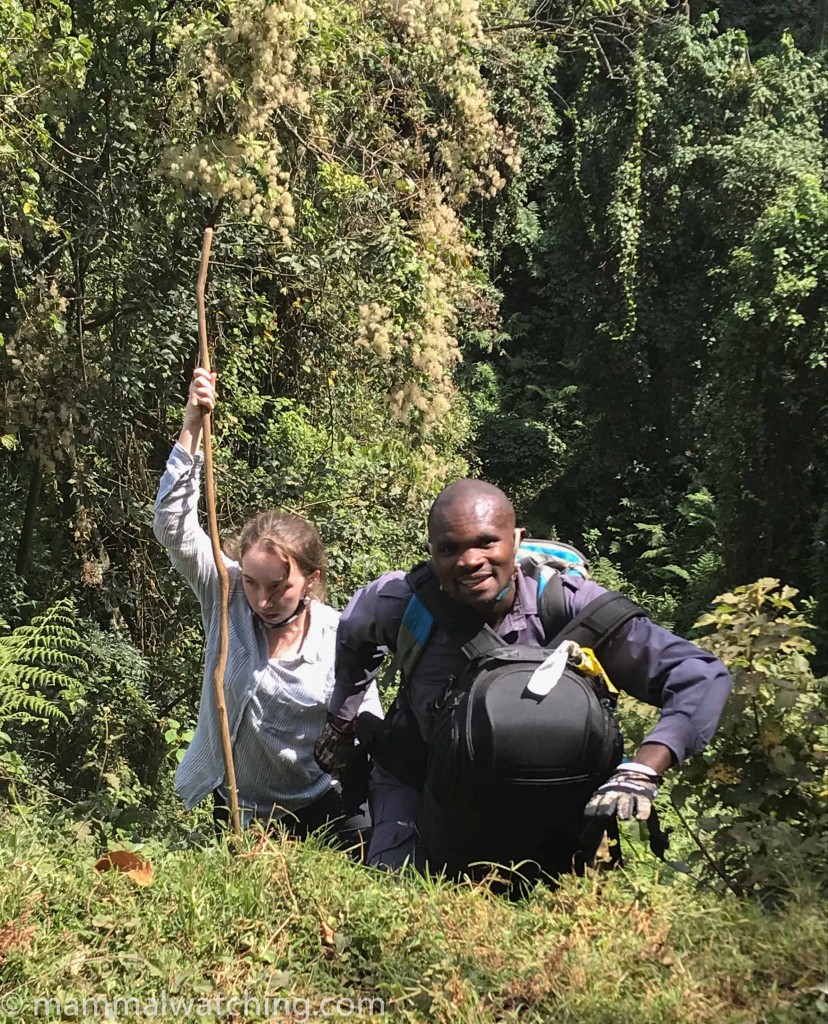
I have seen Mountain Gorillas in Rwanda, so this expensive morning of mammalwatching was mainly for my kids.
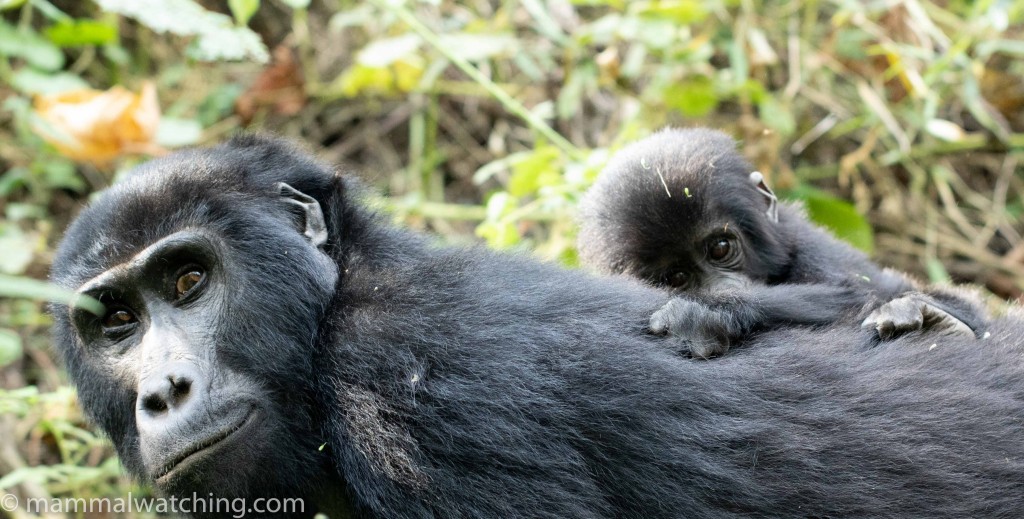
Eastern Gorilla, Gorilla beringei
Seeing the gorillas is without doubt a beautiful experience and I am lucky to have seen them twice. But – even without thinking about the cost – I preferred my more entertaining visit with Kibale’s Chimps. Please don’t tell the gorillas.
Lake Mburo National Park
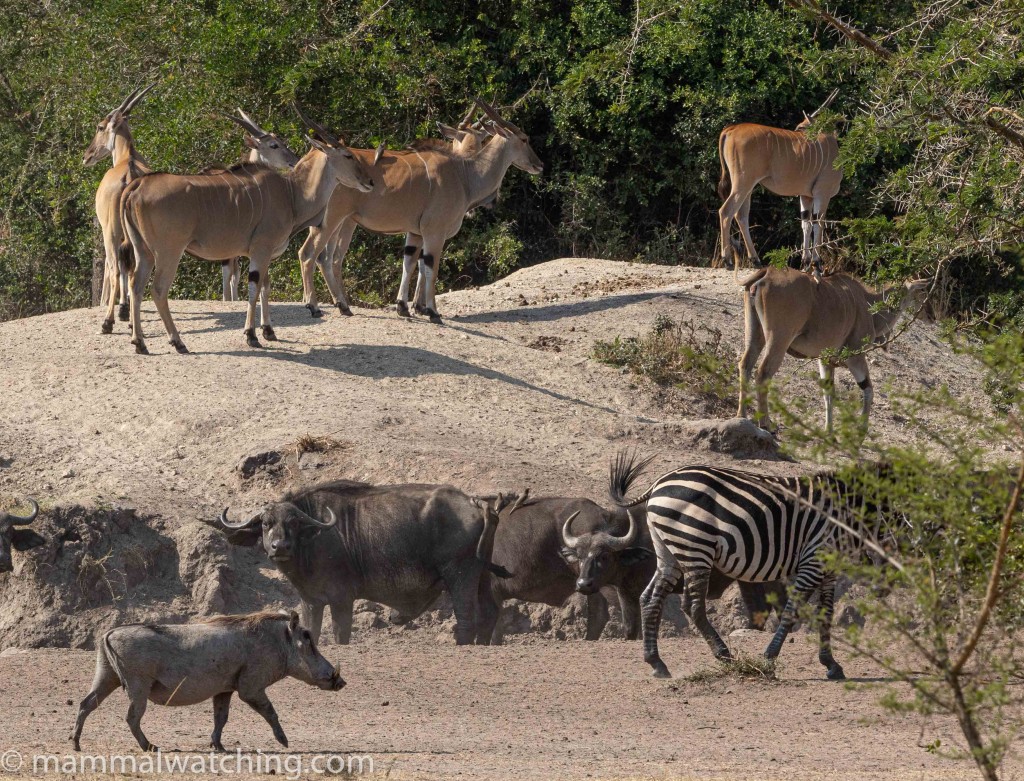
Eland, Zebra, Buffalo and Warthog
Harriet recommended we break the long drive from Bwindi to Entebbe to overnight at Lake Mburo. I wasn’t expecting any lifers here and did not see any, but it is a nice park and I am glad we stopped in.
The park is home to several species that we had not seen so far in Uganda, and I focussed on them.
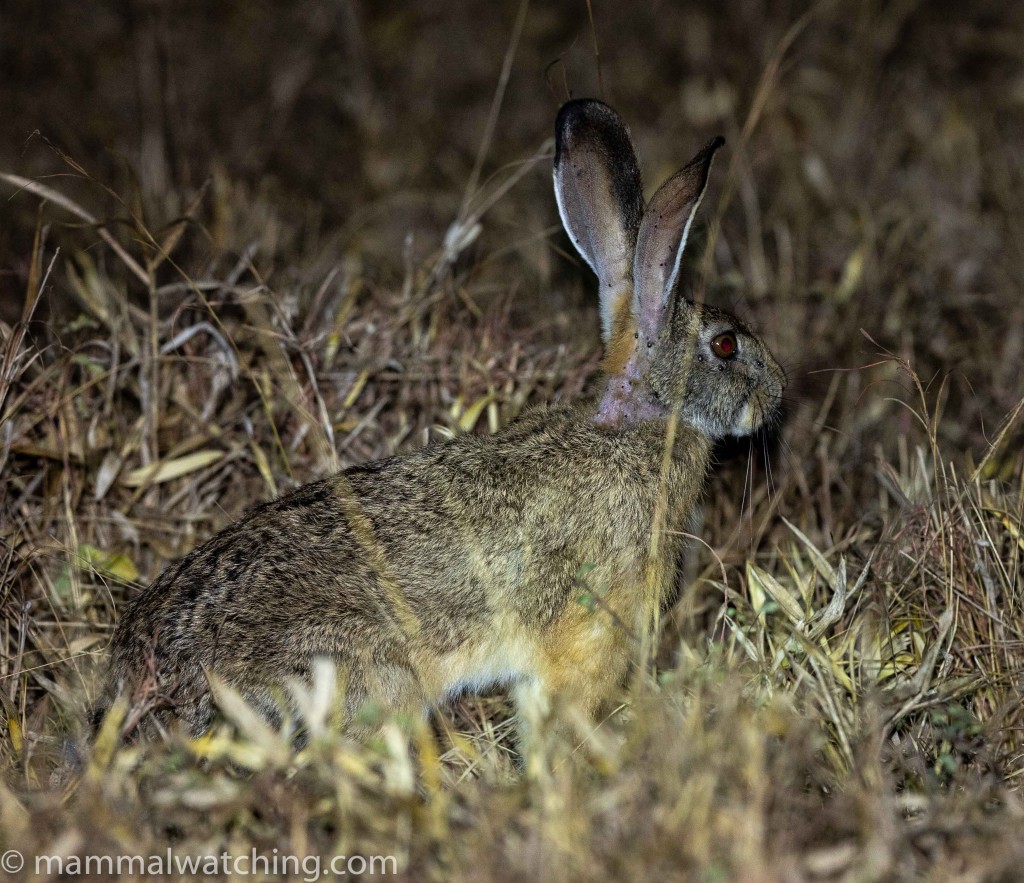
African Savanna Hare, Lepus victoriae
We took a long night drive, starting after 9 pm, in search of Bushpigs, which we were reliably informed could usually be found at the Fishing Village Camp after dark.
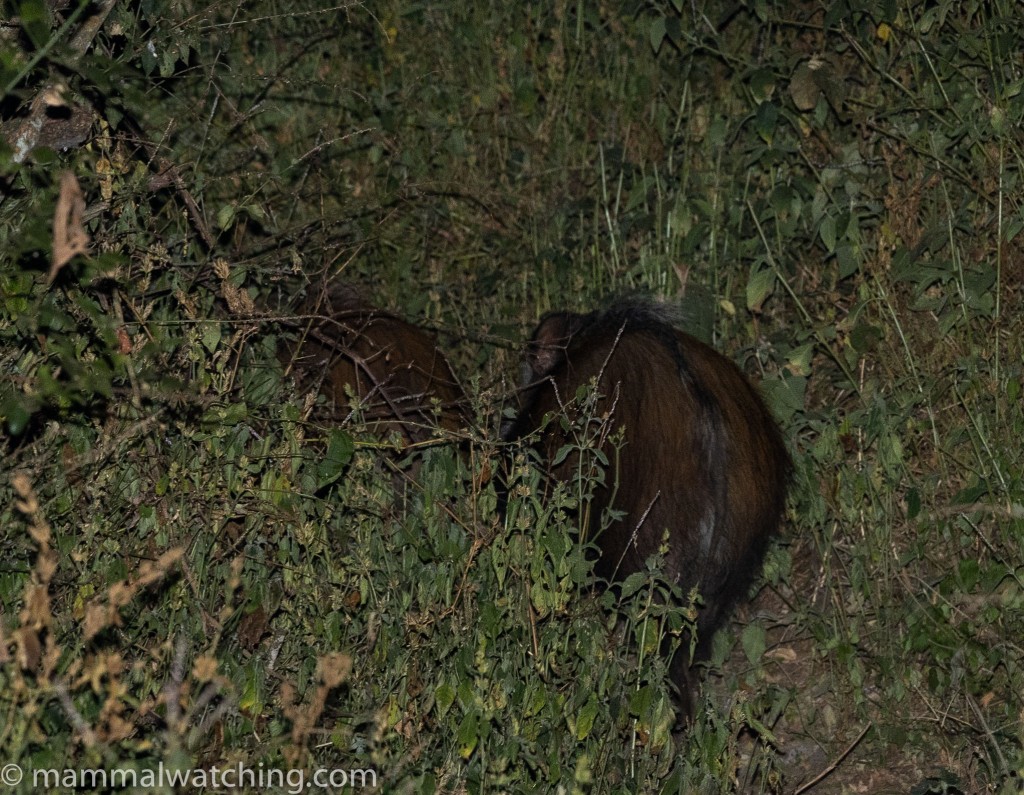
Bushpigs, Potamochoerus larvatus
We drove straight there, and sure enough a sounder of Bushpigs were easy to locate with the thermal scope, though they broke for cover when a light was shone on them.
We spotlit more carefully for some of the way back and the highlights were a Serval, a Greater Galago and a brief look at a genet that our guide said was a Servaline Genet, though I didn’t see it well enough to be sure. We also saw various antelope and a Savanna Hare.
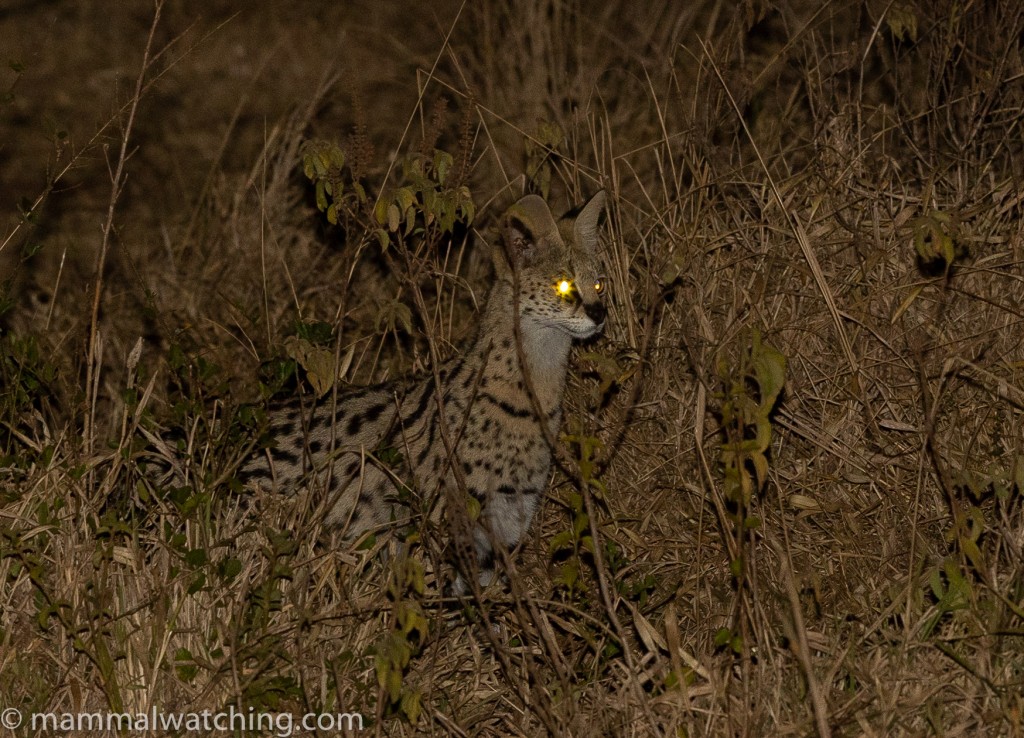
Serval, Leptailurus serval
A short game drive the next morning produced Dwarf Mongoose, Olive Baboons, Vervet Monkeys, Striped Ground Squirrels, Zebra, Warthog, Buffalo, Bushbuck and Impala.
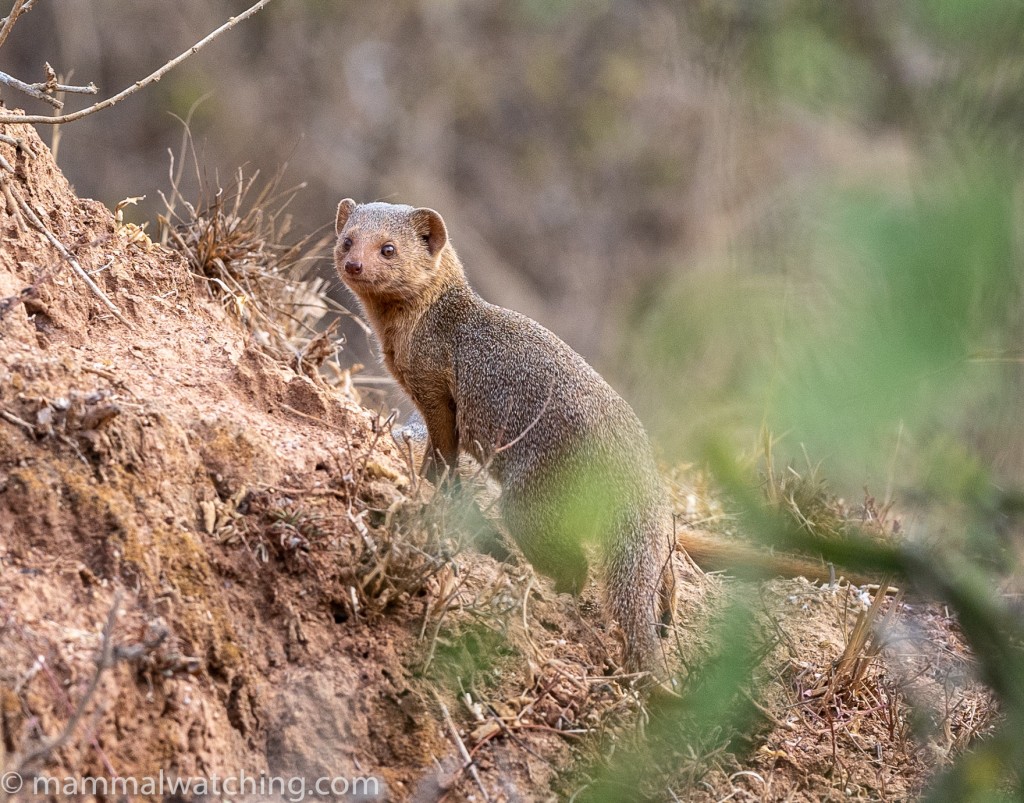
Common Dwarf Mongoose, Helogale parvula
As well as the only Topi and Eland of the trip.
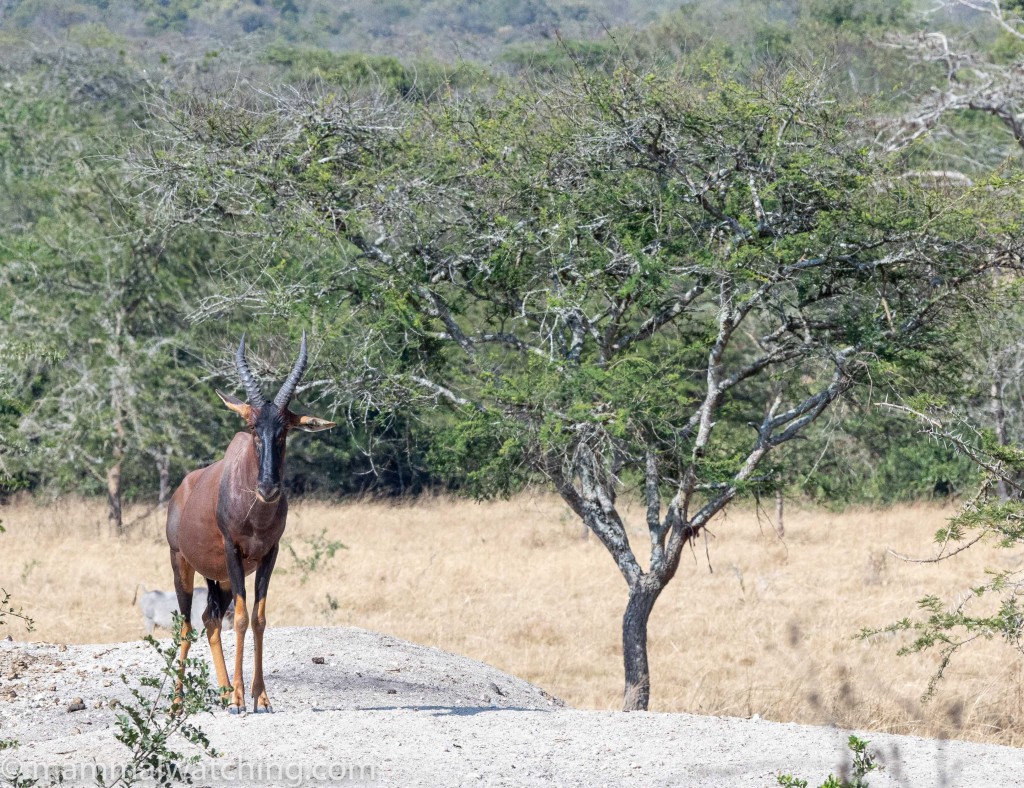
Topi, Damaliscus lunatus
Back at Rwakobo Lodge Joel had caught a Black Rat in the kitchen, and there were slit-faced bats – probably Egyptian Slit-faced Bats – roosting in a shed built into the swimming pool.
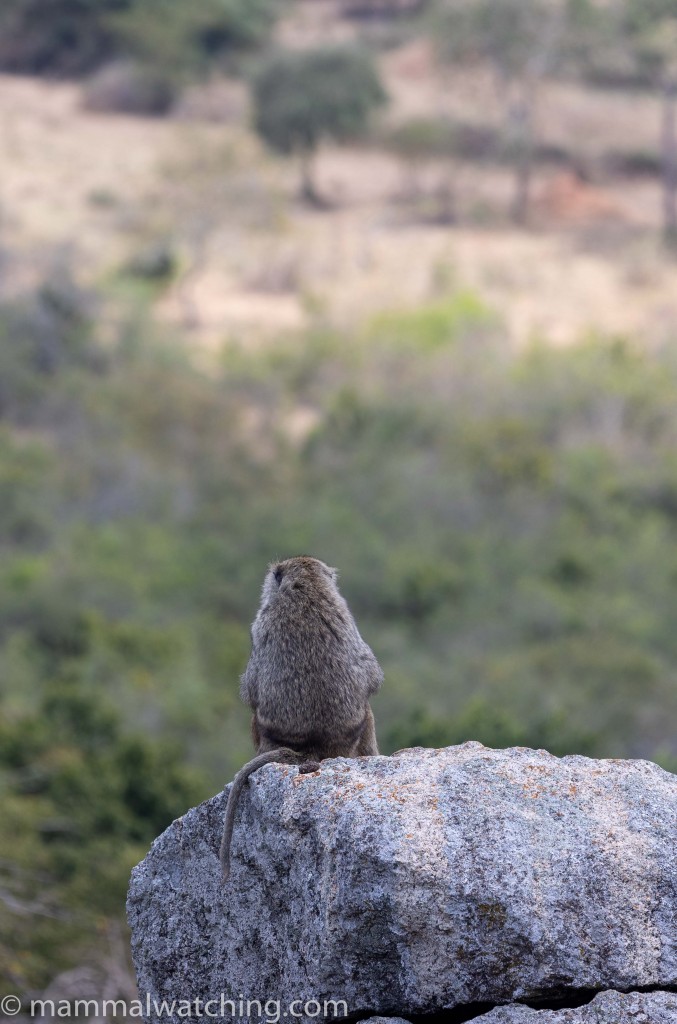
Olive Baboon, Papio anubis
And that was it. After nine days on safari, with around 70 species in the bag, we drove the 5 hours back to Entebbe.
Stuff I missed
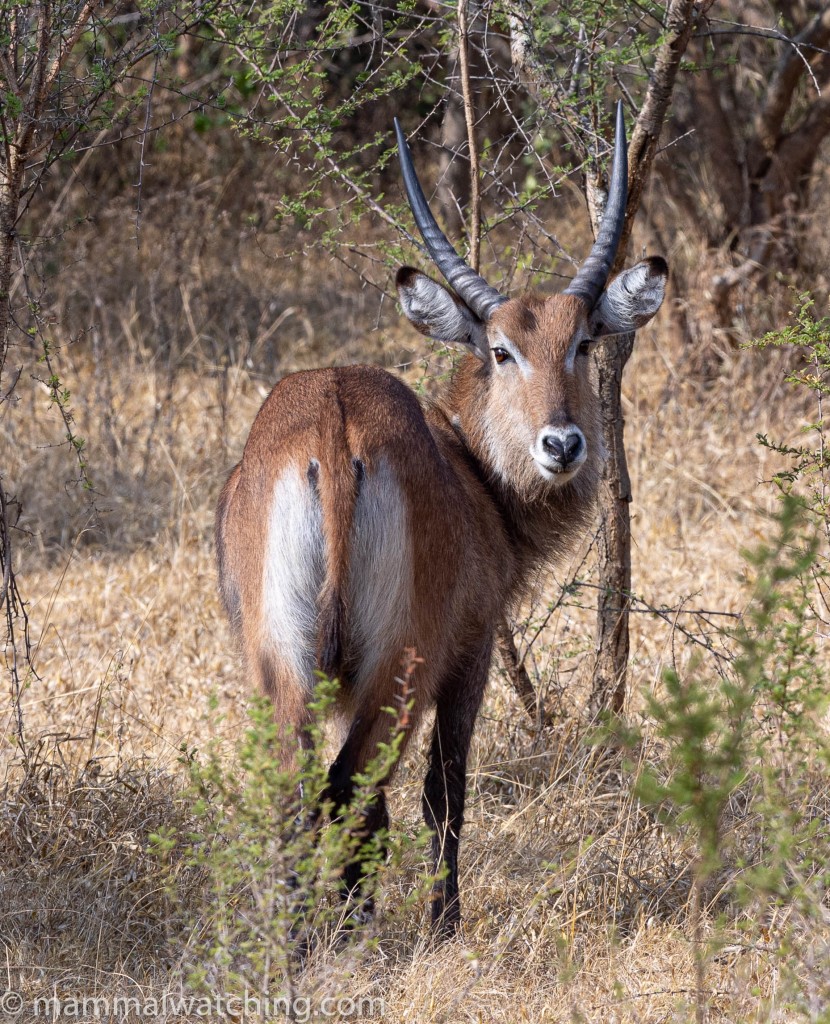
Waterbuck, Kobus ellipsiprymnus. Lake Mburo National Park
I didn’t miss many realistic targets. Of course a Golden Cat or a White-bellied Pangolin would have been exciting, but I wasn’t expecting to see either and did not look for them especially.
Not being able to take a night walk at the Semuliki Hot Springs was a bit of a disappointment: I was very keen to see a Link Rat, and Carlos saw some cool bats there too. But hopefully Harriet has now ensured that access after dark will be easier for the next mammawatchers.
My only other notable miss was Black-fronted Duiker in Bwindi, which are usually fairly easy to see. I have seen this species before in Kenya but wanted a better look especially after seeing Carlos Bocos’s beautiful photograph.
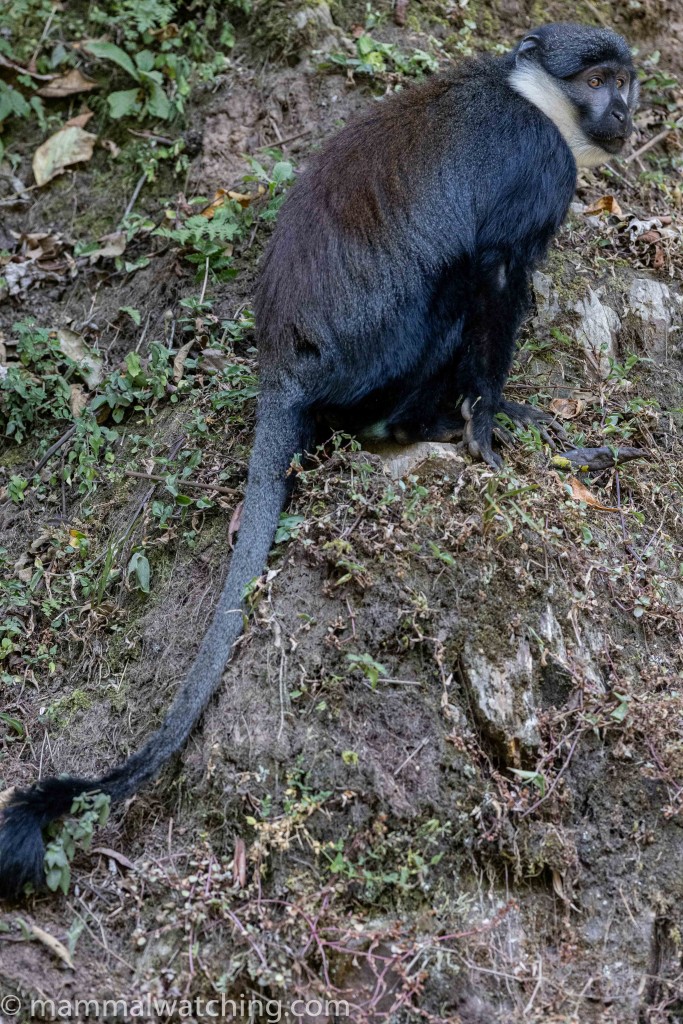
L’hoest’s Monkey, Allochrocebus lhoesti. Bwindi Impenetrable Forest
Thank You
Thanks to Tomer and Alex whose excellent, detailed reports provided the initial inspiration for a trip to Uganda and helped with the planning. Thanks also to Carlos Bocos for his report and a ton of advice on where to find the bats and rats, even if I didn’t see half as many as he did.
And a very big thanks to Harriet, Joel and Kevin from Harrier Tours for their hard work, efficient planning, great spotting and fun company.
Trip List
ELEPHANTIDAE
African Elephant (Loxodonta africana)
LEPORIDAE
Bunyoro Rabbit (Poelagus marjorita)
African Savanna Hare (Lepus victoriae)
HYSTRICIDAE
North African Crested Porcupine (Hystrix cristata)
SCIURIDAE
Striped Ground Squirrel (Euxerus erythropus)
Isabelline Red-legged Sun Squirrel (Heliosciurus rufobrachium)
Ruwenzori Sun Squirrel (H.ruwenzorii)
Carruther’s Mountain Squirrel (Funisciurus carruthersi)
Alexander’s Bush Squirrel (Paraxerus alexandri)
NESOMYIDAE
Forest Giant Pouched Rat (Cricetomys emini)
MURIDAE
Kemp’s Gerbil (Gerbilliscus kempi)
African Grass Rat (Arvicanthis niloticus)
House Rat (Rattus rattus)
GALAGIDAE
Demidoff’s Dwarf Galago (Galagoides demidoff)
Thomas’s Dwarf Galago (G.thomasi)
Spectacled Lesser Galago (Galago matschiei)
Thick-tailed Greater Galago (Otolemur crassicaudatus)
LORISIDAE
East African Potto (Perodicticus ibeanus)
CERCOPITHECIDAE
Grey-cheeked Mangabey (Lophocebus albigena) (includng both Johnston’s and Uganda Crested Mangabeys)
Olive Baboon (Papio anubis)
Patas Monkey (Erythrocebus patas)
Vervet (Chlorocebus pygerythrus)
Tantalus Monkey (C.tantalus)
L’hoest’s Monkey (Allochrocebus lhoesti)
Red-tailed Monkey (Cercopithecus ascanius)
Dent’s Monkey (C.denti)
Blue Monkey (C.mitis)
De Brazza’s Monkey (C.neglectus)
Guereza (Colobus guereza)
Semliki Red Colobus (Piliocolobus semlikiensis)
Ashy Red Colobus (P.tephrosceles)
HOMINIDAE
Eastern Gorilla (Gorilla beringei)
Chimpanzee (Pan troglodytes)
SORICIDAE
African Giant Shrew (Crocidura olivieri)
PTEROPODIDAE
Egyptian Fruit Bat (Rousettus aegyptiacus) (uncertain)
Angolan Fruit Bat (Myonycteris angolensis)
Ethiopian Epauletted Fruit Bat (Epomophorus labiatus)
Wahlberg’s Epauletted Fruit Bat (E.wahlbergi) (uncertain)
HIPPOSIDERIDAE
Sundevall’s Roundleaf Bat (Hipposideros caffer)
RHINOLOPHIDAE
Arabian Horseshoe Bat (Rhinolophus clivosus)
Ruwenzori Horseshoe Bat (R.ruwenzorii)
EMBALLONURIDAE
Mauritian Tomb Bat (Taphozous mauritianus)
NYCTERIDAE
Andersen’s Slit-faced Bat (Nycteris aurita) (uncertain)
Egyptian Slit-faced Bat (N.thebaica)
MOLOSSIDAE
Little Free-tailed Bat (Chaerephon pumilus)
NANDINIIDAE
African Palm Civet (Nandinia binotata)
FELIDAE
Leopard (Panthera pardus)
Serval (Leptailurus serval)
VIVERRIDAE
Servaline Genet (Genetta servalina) (uncertain)
HERPESTIDAE
White-tailed Mongoose (Ichneumia albicauda)
Common Dwarf Mongoose (Helogale parvula)
Pousargues’ Mongoose (Dologale dybowskii)
Banded Mongoose (Mungos mungo)
CANIDAE
Side-striped Jackal (Lupulella adustus)
MUSTELIDAE
Spotted-necked Otter (Hydrictis maculicollis)
EQUIDAE
Plains Zebra (Equus quagga) 56
RHINOCEROTIDAE
White Rhinoceros (Ceratotherium simum)
SUIDAE
Common Warthog (Phacochoerus africanus)
Bushpig (Potamochoerus larvatus)
HIPPOPOTAMIDAE
Hippopotamus (Hippopotamus amphibius)
BOVIDAE
African Buffalo (Syncerus caffer)
Common Eland (Tragelaphus oryx)
Cape Bushbuck (T.sylvaticus)
Impala (Aepyceros melampus)
Oribi (Ourebia ourebi)
Waterbuck (Kobus ellipsiprymnus)
Kob (K.kob)
Hartebeest (Alcelaphus buselaphus)
Topi (Damaliscus lunatus)
Weyns’ Duiker (Cephalophus weynsi)
GIRAFFIDAE
Giraffe (Giraffa camelopardalis)
67 confirmed species, 4 uncertain and 17 confirmed lifers in bold.
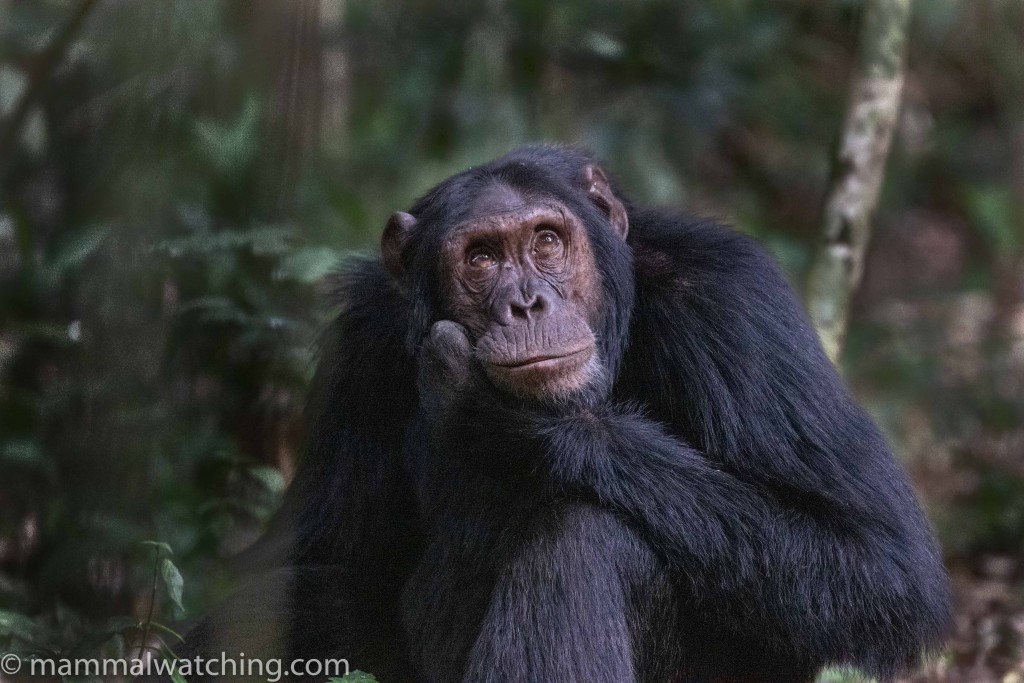
Chimpanzee, Pan troglodytes. Kibale National Park
19 Comments
-
-
-
-
Vladimir Dinets
Nice! I read some parts to my daughter to make her stop complaining about my parenting style.
White rhinos in Uganda were Northern, so whether to call it introduction or reintroduction is an interesting question.
Elephant shrews in Semiliki are supposed to be Stuhlmann’s (a recent split from checkered) I think (never saw one there). -
tomeslice
Amazing report, Jon!!
I’d lie if I said I didn’t check every day since last week to see when it was finally uploaded 🙂
I’m so happy you got to see De Brazza’s and Patas monkeys, and of course I’m jealous of the pousargues mongoose.
Oh, and of course you saw serval and bush pigs again, both species I’ve yet to see… I must connect with them soon!
I second the chequered elephant shrew based on location and on Bret Hartle’s report (he saw it in Budongo, but I suspect it’s the same ecosystem)
All-in-all it sounds like we had a very similar experience with the palm civet, otters, pottos etc.
I’m eager to see even more reports from this incredible country with all its wildlife, until someone finds us a reliable place for Giant otter shrew!!!Cheers!
Tomer -
Samuel
Another cool report Jon. I don’ know how you manage to always be so succesful in your observations and pics wherever you go but I’m always amazed by the number of species you can actually see during your trips (I’m not considering bats that I’m not so much interested in).
For example, I did practically the same itinerary as you in Uganda with good guides as well and yet, I missed the De Brazza’s Monkey in Semuliki and potto & african palm civet and in Kibale/Bwindi. I presumably saw a Pousargue’s Mongoose in the Semuliki Wildlife Reserve at the main lodge where they had been photographied several years ago but it was too brief of an observation to be 100% sure.
By the way from your observations and pics and for my information, how did you come to the conclusion they were indeed Pousargue’s and not red mongoose?
thanks-
Jon Hall
Thanks Samuel. I wish I was always successful! I am sure it helped that all the sites I visited were recently mammalwatched by Tomer and Alex and Carlos so we knew exactly where to look for things. That is a good question on Slender Mongoose (Herpestes sanguineus) (I think that is a red mongoose right?) … I suppose I didn’t really consider that species because these were too colorful, lacked a prominent black tail tip, didn’t seem “slender” enough, and that there were three of them. I have only ever seen single Slender Mongoose I think. But it is a good question and they were also a possibility. I just heard from Harriet that the next mammalwatching trip after mine also saw them at Murchison. Hopefully he got better pictures.
-
-
Mattia from Italy
Great report, as usual, Jon, always a pleasure to read! Please don’t hate me, but the cooler critters you saw are, for me, Shoebill and the Goliath Beetles, maybe because I already had great times with Gorillas and Chimps in Rwanda. I dont’ know the reason, but usually the Gorillas in Rwanda are more active and give better experiences. And of course because I am not so attracted to the Tons of Bats that you search on every trip.
By the way, TONS OF BATS could really be the name of your band, like DESPERATE WITH SERVALS for Tomer.
-
-
Leave a Reply
You must be logged in to post a comment.


Conuropsis
Nice as always. July/August seems to be the best time for going to East Africa. Cooler and less humid and less rain. I didn’t see any stripes on the back of the mongoose so I’d think that would be an easy mark to separate from Banded too. Love the beetle. Have one in my collection.
Andrew